July 29, 2018
Götterdämmerung in Munich
It is also an odd thing, perhaps, to start as well as to end with Götterdämmerung, although that oddness may well be overstated. Wagner’s initial intention was, after all, to write a single drama on the death of Siegfried; after a certain point in the formulation of theRing project, much of what had been written as Siegfrieds Tod remained as Götterdämmerung. Might one even be able to recapture something of that initial intent, relying on the narrations here as they might originally have been conceived? Perhaps - and it is surely no more absurd intrinsically to watch - and to listen to - one of the Ring dramas than it is to one part of the Oresteia . On the other hand, a Götterdämmerung conceived as a one-off - whether in simple terms or as part of a series such as that presented some time ago by Stuttgart, each by a different director, glorying in rather than apologising for disjuncture and incoherence - will perhaps be a different thing from this. Anyway, we have what we have, and I can only speak of what I have seen and heard.
In that respect, I am afraid, this Götterdämmerung proved sorely disappointing - especially, although not only, as staging. Indeed, the apparent vacuity of the staging combined with what seemed a distinctly repertoire approach - yes, I know there will always be constraints upon what a theatre can manage - combined to leave me resolutely unmoved throughout. This did not seem in any sense to be some sort of post-Brechtian strategy, a parallel to where parts at least of Frank Castorf’s now legendary Bayreuth Ring started out - if not, necessarily, always to where they ended up. I distinctly had the impression that what acting we saw had come from a largely excellent cast. Is that at least an implicit criticism of the revival direction? Not necessarily. I know nothing of how what few rehearsals I suspect there were had been organised. I could not help but think, though, that once again Wagner’s wholesale rejection - theoretical and, crucially, practical too - of the ideology and practices of ‘normal’ theatres had once again been vindicated. This, after all, is the final day of a Bühnenfestspiel. At one point, he even wrote of post-revolutionary performances in a temporary theatre on the banks of the Rhine, after which it and the score would be burnt. Did he mean that? At the time, he probably did, just as we mean all sorts of things at the time we might not actually do in practice. Nevertheless, his rejection of everyday practice points us to an important truth concerning his works. As Pierre Boulez, whilst at work on the Ring at Bayreuth, put it: ‘Opera houses are often rather like cafés where, if you sit near enough to the counter, you can hear waiters calling out their orders: “One Carmen! And one Walküre! And one Rigoletto!”’ What was needed, Boulez noted approvingly, ‘was an entirely new musical and theatrical structure, and it was this that he [Wagner] gradually created’. Bayreuth, quite rightly, remains the model; Bayreuth, quite wrongly, remains ignored by the rest of the world.
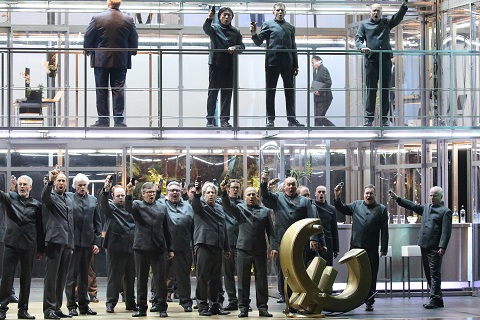 Chorus. Photo credit: Wilfried Hösl.
Chorus. Photo credit: Wilfried Hösl.
Such unhelpfulness out of the way, what did we have? Details of
Kriegenburg’s staging seem to borrow heavily - let us say, pay homage to -
from other productions. The multi-level, modern-office-look set is not
entirely unlike that for Jürgen Flimm’s (justly forgotten) Bayreuth
staging. Brünnhilde arrives at the Gibichung Court with a paper bag over
her head, although it is sooner shed than in Richard Jones’s old Covent
Garden Ring. I shall not list them all, but they come across here,
without much in the way of conceptual apparatus, more as clichés than
anything else. Are they ironised, then? Not so far as I could tell. I liked
Siegfried’s making his way through a baffling - to him - crowd of
consumers, as he entered into the ‘real world’, images from advertising and
all. Alas, the idea did not really seem to lead anywhere.
A euro figure (€) is present; perhaps it has been before. First, somewhat
bafflingly, it is there as a rocking horse for Gutrune; again, perhaps
there is a backstory to that. Then, it seems to do service - not a bad
idea, this - as an unclosed ring-like arena for some of the action,
although it is not quite clear to me why it does at some times and not at
others. Presumably this is the euro as money rather than as emblematic
hate-figure for the ‘euroscepticism’ bedevilling Europe in general and my
benighted country in particular. (That said, I once had the misfortune to
be seated in front of Michael Gove and ‘advisor’, whose job appeared to be
to hold Gove’s jacket, at Bayreuth; so who knows?) There also seems to be a
sense of Gutrune as particular victim, an intriguing sense, although again
it is only intermittently maintained. Doubtless her behaviour earlier on,
drunk, hungover, posing for selfies with the vassals, might be ascribed to
her exploitation by the male society; here, however, it comes perilously
close to being repeated on stage rather than criticised. That she is left
on stage at the end, encircled by a group of actors who occasionally come
on to ‘represent’ things - the Rhine during Siegfried’s journey, for
instance - is clearly supposed to be significant. I could come up with
various suggestions why that might be so; I am not at all convinced,
however, that any of them would have anything to do with the somewhat
confused and confusing action here.
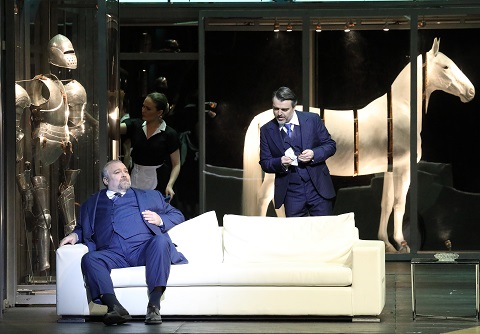 . Hans-Peter König (Hagen) and Markus Eiche (Gunther). Photo credit: Wilfried Hösl.
. Hans-Peter König (Hagen) and Markus Eiche (Gunther). Photo credit: Wilfried Hösl.
Kirill Petrenko led a far from negligible account of the score, which, a few too many orchestral fluffs aside - it nearly always happens in Götterdämmerung, for perfectly obvious reasons - proved alert to the Wagnerian melos. It certainly marked an advance upon the often hesitant work I heard from him in the Ring at Bayreuth. However, ultimately, it often seemed - to me - observed rather than participatory, especially during the Prologue and First Act. The emotional and intellectual involvement I so admired in, for instance, his performances of Tannhäuser and Die Meistersinger here in Munich was not so evident. Perhaps some at least of that dissatisfaction, however, was a matter of the production failing to involve one emotionally at all. The Munich audience certainly seemed more appreciative than I, so perhaps I was just not in the right frame of mind.
Much the same might be said of the singing. Nina Stemme’s Brünnhilde redeemed itself - as well, perhaps, as the world - in the third act, recovering some of that sovereign command we know, admire, even love, although even here I could not help but reflect how surer her performance at the 2013 Proms under Daniel Barenboim had been. There is nothing wrong with using the prompter; that is what (s)he is there for, as Strauss’s Capriccio M. Taupe might remind us. Stemme’s - and not only Stemme’s - persistent resort thereto, however, especially when words were still sometimes confused, was far from ideal during the first and second acts. Stefan Vinke ploughed through the role of Siegfried, often heroically, sometimes with a little too grit in the voice, yet with nothing too much to worry about. It was not a subtle portrayal, but then, what would a subtle Siegfried be?
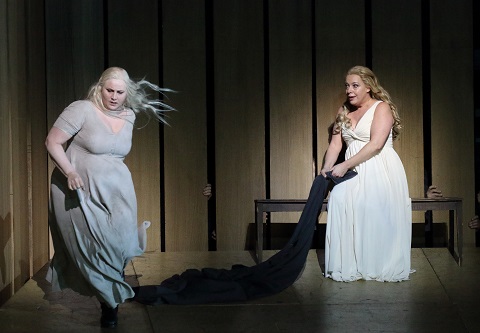 Nina Stemme (Brünnhilde) and Okka von der Damerau (Norn). Photo credit: Wilfried Hösl.
Nina Stemme (Brünnhilde) and Okka von der Damerau (Norn). Photo credit: Wilfried Hösl.
Some might have found Hans-Peter König a little too kindly of voice as Hagen; I rather liked the somewhat avuncular persona, with a hint of concealment. Again, there was no doubting his ability to sing the role. Markus Eiche and Anna Gabler were occasionally a little small of voice and, in Eiche’s case, presence as his half-siblings, but there remained much to admire: Gabler’s whole-hearted embrace of that reimagined role, for one thing. Okka von der Damerau made for a wonderfully committed, concerned Waltraute: as so often, the highlight of the first act. John Lundgren’s darkly insidious Alberich left one wanting more, much more. The Rhinemaidens and Norns were, without exception, excellent. I especially loved the contrasting colours - Jennifer Johnson’s contralto-like mezzo in particular - and blend from the latter in the opening scene. If there are downsides to repertory systems, casting from depth as here can prove a distinct advantage. Choral singing was of the highest standard too.
If only the production, insofar as I could tell, had had more to say and
more to bring these disparate elements together. Without the modern look,
it might often as well have been Robert Lepage or Otto Schenk.
Mark Berry
Richard Wagner, Götterdammerung
Siegfried: Stefan Vinke; Gunther: Markus Eiche; Hagen: Hans-Peter König;
Alberich: John
Lundgren; Brünnhilde: Nina Stemme; Gutrune, Third Norn: Anna Gabler;
Waltraute, First
Norn: Okka von der Damerau; Woglinde: Hanna-Elisabeth Müller; Wellgunde:
Rachael Wilson; Flosshilde, Second Norn: Jennifer Johnston; Third Norn: Anna
Gabler. Director: Andreas Kriegenburg; Revival Director: Georgine Balk; Set Designs: Harald
B. Thor; Costumes: Andrea Schraad; Lighting: Stefan Bolliger; Choreography: Zenta
Haerter; Dramaturgy: Marion Tiedtke, Olaf A. Schmitt. Bavarian State Opera Chorus
and Extra Chorus (chorus master: Sören Eckhoff)/Bavarian State Orchestra/Kirill
Petrenko (conductor). Nationaltheater, Munich, Friday 27 July
image=http://www.operatoday.com/Siegfried%20%28Stefan%20Vinke%29%2C%20Hagen%20%28Hans-Peter%20K%C3%B6nig%29%2C%20Br%C3%BCnnhilde%20%28Nina%20Stemme%29.jpg
image_description=Götterdammerung, Munich Festival Opera
product=yes
product_title=Götterdammerung, Munich Festival Opera
product_by=A review by Mark Berry
product_id= Above: Siegfried (Stefan Vinke), Hagen (Hans-Peter König), Brünnhilde (Nina Stemme)
Photo credit: Wilfried Hösl
July 28, 2018
A celebration of Parry at the BBC Proms
Hubert Parry's hope-filled symphonic masterpiece, Symphony No. 5 (Symphonic Fantasia '1912') from 1912 was paired with three works written in the shadow of the war, Vaughan Williams' The Lark Ascending and Pastoral Symphony, and Gustav Holst’s Ode to Death, none of them obviously war inflected but each piece affected by their composer's wartime experience. This year is also the centenary of Parry's death, and as well his symphony the concert also included his large-scale anthem, Hear my words, ye people. Tai Murray was the violin soloist in the Lark Ascending, with Francesca Chiejina (soprano) and Ashley Riches (bass) soloists in the Parry anthem.
Parry's fifth (and last) symphony was premiered at the Queen's Hall in London in December 1912. It consists of four linked movements; that each movement has a title ('Stress', 'Love', 'Play', 'Now') suggests the work's tone-poem like character, and this is emphasised by the way Parry has labelled the various themes ('Brooding thought', 'Tragedy', 'Wrestling Thought' etc). As a symphonist, we can hear Parry's debt to Elgar, to Brahms and to Liszt but we should also remember that Elgar the symphonist owed something to Parry. Parry's writing, whilst having a sound akin to Elgar, lacks the latter composer's sheer grandiloquence and the fifth symphony is a thoughtful and in many ways poetic work.
The first movement opens with a theme which Parry labelled 'Brooding thought' and it brooded indeed as the slow introduction developed restlessly into an 'Allegro' with Elgarian overtones (or perhaps we should say that Elgar has Parry overtones!). The orchestra made a fine, mellow sound, with much ebb and flow of detail, moments of calm and thrilling drama. The second movement included a lovely duet for bass clarinet and solo cello (evidently the bass clarinet was one of Parry's most favourite instruments), and also a remarkably noble tune. Yet the movement did not progress in an obvious fashion, and there was a remarkable amount of complexity in the detail whilst at the end everything simply subsided into the scurrying delight and perky rhythms of the third movement. This had a delightful, country-dance style trio featuring the horns. The finale brought thoughts of Elgar again, but with a more rumbustious quality to the big tune. Parry gives this a terrific development, which strives to a triumphant close. Throughout, Brabbins and the orchestra played the music as if they had known it for ever, with lovely string phrasing and fine woodwind solos.
This was followed by a far more familiar work, RVW's Lark Ascending with the American violinist Tai Murray. From the opening with its hushed strings, and Murray's bare-there solo, it was clear that she took a very particular view of the work. Her solo line, all elegant fine-grained sound, seemed to go on for ever and throughout the piece tempos were relaxed (without ever being over-done) and Murray emphasised the time-less, contemplative nature of the piece rather than worrying about the descriptive natural detail. This is, in fact, all apiece with the modern view of the work as arising out of RVW's war-time experiences (it was written originally in 1914 and revised in 1920). The middle section had greater vitality, with a clarity and transparency to the orchestral contribution, but then we relaxed into a truly magical ending.
After the interval we had Parry's Hear my words, ye people for choir, brass, organ, solo soprano (Francesca Chiejina) and bass solo (Ashley Riches). Originally written for the Diocesan Choral Festival at Salisbury Cathedral in 1894, the work alternates between full chorus and semi-chorus, with sections for the soloists. It started with an organ peroration (from Adrian Partington on the Royal Albert Hall organ) and throughout the organ part was important, hardly accompanying and rather commenting though there were times when it seemed rather too prominent in the mix in the hall. The soloists were placed quite far back, and neither completely felt present enough in the hall though both sang confidently. All in all, the piece rather failed to hang together, the individual sections never coalescing into a significant work, and this was emphasised by the final section when we suddenly jumped into a memorable tune which became a well-known hymn tune.
Thankfully, Holst's Ode to death was a richer and subtler piece. Premiered in 1919, it arose out of Holst's war-time experiences with the YMCA in Salonica and Istanbul. A setting of Walt Whitman for chorus and orchestra, Holst matches the individual tone of the different verses yet melds the whole into a unique piece. The opening sounded aetherial with transparent scoring when, listening to the words ('Come lovely and soothing death/Undulate round the world, serenely arriving'), we might have expected something more elegiac. This is Holst in The Planets mode (in fact written just before in 1914-1916 and premiered in 1918), and for all the richness of the harmony there was a certain coolness particularly arising out of Holst's fondness for bitonality. In the 'Dark mother always gliding near with soft feet', Holst's writing almost suggests a march, yet the material is hardly martial and Brabbins really brought out the work's subtle poetry. Holst the mystic emerged in the 'Lost in the loving floating ocean', a truly remarkable passage, whilst the concluding section with its bitonality and otherworldly tension, was truly eerie.
This was the work's first performance at The Proms, and I have not heard it live since I sang in a performance with the University chorus as a student in 1974. It is puzzling why such a rich, fascinating work, a secular requiem in all but name, is not better known.
The final work in the programme was another deceptive one. It is fatally easy to fall back on Peter Warlock's satirical comment ' like a cow looking over a gate', yet the piece had its origins in the First World War, and the landscape being evoked is wartime France. This is another contemplative meditation on war, rather than an angry striving. It is worth remembering that another British First World War participant, Sir Arthur Bliss, produced his Morning Heroes after the war, another thoughtful, troubling work.
There is little fast or loud music in RVW's symphony, yet it is full of expressive and passionate moments. The opening movement was quietly concentrated, with quite a flowing tempo and the music gradually building in layers. Brabbins beautifully controlled the ebb and flow of ideas, constantly keeping the music moving yet revealing a lot of detail in the orchestra. As drama progressed, he and the orchestra relished the lush textures and brought out a surprising amount of passion. The second movement opened with a melancholy horn call (again we had bitonality as a profoundly expressive device), creating an eerie moment. The concentrated texture of the orchestral playing was broken by the atmospheric off-stage natural trumpet, creating a moment where time was suspended. The vigorous scherzo was remarkably rumbustious, with pastoral flute passages and an English country dance on the brass, all mixed into something characteristic of RVW. Then suddenly it turns into a perky English country dance. The final movement includes a wordless soprano, off-stage, here Francesca Chiejina who sang with a very rich timbre and create sound which was very present in the hall, there was nothing aetherial about this soprano she was a full-blooded woman (RVW's wife talked about this passaged being about 'that essence of summer where a girl passes singing' and this was a flesh and blood girl). This solo unleashed complex passions in the orchestra, leading to a magical ending where the soprano solo reappears, then evaporates leaving just a high violin note.
This was a fine and thoughtful concert which paired the music of Parry with that of the younger generation of English composers and giving us the more thoughtful side of English music from the 1910s and 1920s.
Robert Hugill
Prom 17: Hubert Parry - Symphony No.5; Ralph Vaughan Williams -The Lark Ascending; Hubert Parry - Hear my words, ye people; Gustav Holst - Ode to Death; Ralph Vaughan Williams - Pastoral Symphony (No.3)
Tai Murray (violin), Francesca Chiejina (soprano), Ashley Riches (bass-baritone), Adrian Partington (organ)
BBC National Chorus of Wales, BBC National Orchestra of Wales, Martyn Brabbins (conductor)
Royal Albert Hall, London; Friday 27th July 2018
image=http://www.operatoday.com/Ashley%20Riches.jpg image_description=Prom 17: Martyn Brabbins with the BBC National Orchestra of Wales and the BBC National Chorus of Wales product=yes product_title= Prom 17: Martyn Brabbins with the BBC National Orchestra of Wales and the BBC National Chorus of Wales product_by=A review by Robert Hugill product_id= Above: Ashley RichesPhoto credit: BBC/Mark Allan
July 26, 2018
Oxford Lieder Festival 2018: The Grand Tour - A European Journey in Song
A celebration of European song will be the focus of the 2018 Oxford Lieder Festival (12th - 27th October) and will showcase the familiar masterpieces of the song repertoire while exploring wider cultural influences from Finland to the south of Spain and from Dublin to Moscow. The great masters of the German Lied brush shoulders with composers from Carl Nielsen to Ester Magi to Lili Boulanger. Fascinating talks and study events will illuminate music, art and literature across the continent. A series of ‘language labs’ explore language and poetry from Polish to Czech to Estonian.
International stars including Louise Alder (15 Oct), Toby Spence (16 Oct), Kai Rüütel (17 Oct), James Gilchrist (19 Oct), Camilla Tilling (20 Oct), Christoph Prégardien (21 Oct), Benjamin Appl (22 Oct), Sarah Connolly (22 Oct), Véronique Gens (24 Oct), Thomas Oliemans (25 Oct) and Kate Royal (26 Oct) appear alongside exceptional young artists, including the winners of the Kathleen Ferrier Awards, the Wigmore Hall International Song Competition and, in a new collaboration with Heidelberger Frühling, Das Lied. The lunchtime series includes concerts of Polish, Hungarian and Italian songs, and there is a rich programme of chamber music in the rush-hour series, including music from the Baltic states, Russia and France.
A day-long event focuses on Scandinavian song, with performances given by native-speaking singers from all the Nordic countries (20 Oct). There will be a day devoted to Claude Debussy on the centenary of his death, including a recital with leading French pianist Anne Le Bozec and two of the brightest emerging French singers: Marie-Laure Garnier and Jean-Christophe Lanièce (13 Oct). An evening in Spain features soprano Lorena Paz Nieto and British/Catalan mezzo Marta Fontanals-Simmons, as well as Spanish violin music, a Spanish wine tasting and Flamenco (18 Oct). A range of events mark the 100th anniversary of the death of Hubert Parry taking a fresh look at his significance for English song.
Other highlights include the opening concert (12 Oct) with Sophie Bevan, Kitty Whateley, James Gilchrist and Marcus Farnsworth performing works including Ralph Vaughan Williams’s Serenade to Music, and the closing concert (27 Oct) with the thrilling Irish mezzo Tara Erraught and BBC New Generation Artist Ashley Riches performing Schumann’sMyrthen. Robert Holl and Graham Johnson perform Winterreise (14 Oct) and the exciting new ensemble Schubert & Co. present an uplifting Schubertiade (23 Oct).
Tickets and festival passes visit www.oxfordlieder.co.uk / 01865 591276.
image=http://www.operatoday.com/Oxford%20lieder%20logo.jpg image_description=Oxford Lieder Festival, 12th - 27th October 2018: The Grand Tour - A European Journey in Song product=yes product_title=Oxford Lieder Festival, 12th - 27th October 2018: The Grand Tour - A European Journey in Song product_by= product_id=July 25, 2018
Angelika Kirchschlager's first Winterreise
Similarly, men are often the voice of choice in female roles where an element of strangeness is to the fore, such as Birtwistle’s Snake Priestess (The Minotaur) and Britten’s Madwoman (Curlew River). Theatre, too, is gender-neutral these days, and Glenda Jackson can be King Lear just as Mark Rylance can become Cleopatra.
But, what of the recital hall? Where the solo lieder singer has no dramatic role to embody and where the poet so often seems to have identified intensely with the poetic persona for whose voice the singer is an expressive conduit?
I put this question to Austrian mezzo-soprano Angelika Kirchschlager, before her performance of Schubert’s Winterreise at Middle Temple Hall , with pianist Julius Drake. She sensibly pointed out that in the opera house, the travesti roles make a positive and essential contribution, androgyny being integral to the dramatic and musical design, and also to the ‘entertainment’. But, art song is not entertainment: it is both delicate and powerful; it forces one to reflect on and to integrate ideas and emotions; it issues challenges of a political and personal nature. “There is always something humming beneath the surface.”
I wondered if, while we are unperturbed by a woman embodying, say, the lovesick travelling journeyman in Mahler’s Lieder eines fahrenden Gesellen or Schubert’s Ganymede, there is something unique about Winterreise, Wilhelm Müller’s poems being too ‘confessional’ to permit the crossing of gender lines? Angelika explained that she believes Winterreise communicates human experience, rather than an explicitly male or female perspective. She described the song-cycle as “a journey to the inside of a human being”, a spiral ever deeper into loneliness as the male persona becomes increasing cut off from the world, unable to find his place, ever more lost. “A man or a woman can do that journey.”
And, why not? Female singers including Elisabeth Schumann, Lois Marshall, Christa Ludwig and Brigitte Fassbaender have all performed or recording Winterreise. After thirty years of singing opera and lieder, and ten years of teaching, Angelika hoped that it would come up some day. “It is the ultimate challenge in lieder. A complex masterpiece for which I have so much respect.” The exploration of the cycle’s psychology and parameters is obviously something that the mezzo-soprano has relished.
When I questioned whether a male singer could sing Schumann’s Frauenliebe und Leben, Angelika replied, “No. Because the songs communicate uniquely female experience. No man can ever know what it is to love as a woman, to marry, to become a mother.” Schumann’s songs tell of a woman’s daily life, whereas in Winterreise only the first song, ‘Gute Nacht’, is connected to the real world, and through the rest of the cycle the persona travels ever further into nature and away from people.
Angelika told me that she feels the influence of Schubert’s own life experiences in these songs - practical problems arranging concerts, with women, money, illness - and that the cycle expresses feelings of helplessness about where life can go. She also believes that the winter traveller’s journey into isolation and introspection has begun long before the first song commences; that he had suffered before, and that the cycle resumes a long process of separation. “Why is he leaving? We don’t know and can only speculate. But, I try to keep out lament; not to cry unless it is in the songs, and to focus on other emotional aspects. He is rushing away, and he just keeps on going.” Interestingly, Angelika remarked that after more than a year of learning the song-cycle, she felt that she was getting into the mind of a man, encountering problems which she recognised from the experiences of men whom she knew.
I was surprised when Angelika revealed that she has never heard Winterreise performed live before, and I asked her how she has been preparing for her own first performance of the cycle. She listened to recordings of single songs - “thinking about how creative I could be,” she said, with a laugh - and then explored the texts, looking for connections between Schubert’s harmonies and the texts. Schubert’s textual annotations were comprehensive, and she commented, “you don’t have to do anything, just find out what Schubert wants to tell us”. As she advises her students, if you just sing what you feel, it will be your music but not the composer’s.
We discussed some of the practicalities such as the choice of keys and transposition. Angelika’s choices are entirely her own, drawing on the original version and those for medium and low voice. She carefully considered the connections between songs, asking herself whether she wanted progressions to seem “weird” or natural, whether to retain links or to break them. Having gone through numerous sets of possibilities, changing the key relationships over and over, she has settled on her fifth version!
We talked, too, of vocal technique and colour, and Angelika emphasised that the absence of contrast between the chest and head voice for women has a marked effect. Schubert may have written a particularly high passage for tenor, anticipating the softness and colour of the head voice, and so a woman’s performance will inevitably be different. I raised the matter of the ‘distance’ between the vocal line and piano, the former higher in pitch than usual, and the latter lower as a result of the transposition, and Angelika reflected that perhaps this increases the sense of the traveller’s alienation and loneliness.
I wondered whether the close proximity of the audience at Temple Church presented challenges, but Angelika laughed again: “I like the audience close! I’ve sung in venues where they’ve been much closer. It means the audience cannot escape! I don’t want to sing in a dark auditorium where the audience are anonymous: they must be part of it, they are 50% of the evening.”
At the end of our conversation, Angelika spoke with passion. “There can never be a right or wrong Winterreise. There are simply always more aspects of the cycle to explore and each new interpretation is a positive contribution to the work’s life. A ‘solution’, there can never be. But the essential thing is to be faithful to the music and that will ensure that the singer is faithful to Schubert’s genius.”
With such thoughts in mind, I settled into the pew at Temple Church and listened to the urgent but light tread of Julius Drake’s piano introduction to ‘Gute Nacht’, and was immediately struck by this traveller’s intensity: the fixity of Angelika Kirchschlager’s stare as she seemed to reach for a distant point, beyond the horizon, was riveting. There was steely purpose, here: ‘Was soll ich länger wellen/ Bis man mich treib’ hinaus?’ (Why should I wait longer for them to drive me out?) pushed forward, with defiant determination. There was tension and turbulence too - in the unruly trembling of Drake’s weathervane in the following song, and in the traveller’s heart - but in these opening songs it was restrained, almost repressed, occasionally retreating into numbness, or, as in the final stanza of ‘Gefrorne Tränen’, momentarily relaxing and finding warm release: ‘Als wolltet ihr zerschmelzen/Des ganzen Winters Eis’ (As if you would melt/All this winter’s ice).
Dreams of ‘Der Lindenbaum’ transported the traveller far from the present, but the tenderness of the vision only emphasised the vulnerability of the voyager. This was less a ‘narration’ than a drama, as Kirchschlager communicated emotion openly and directly. Though her artistry was ever evident, the mezzo-soprano seemed to render these art songs into pure feeling, almost folk-like in their honesty, often singing with little vibrato and using vocal heightening and nuance with care and thoughtfulness. Flashes of brightness - passion, anger, pain - were thus all the more telling. The slow tempo of ‘Wasserflut’ suggested the traveller’s ‘lostness’, though the heatedness of the burning tears reminded us of his anguish; Drake’s tip-toeing accompaniment in ‘Auf dem Flusse’ took us deeper into a dream-scape, before we were wrenched back to reality by the traveller’s agonized questioning as he gazes into the stream at the close of the song - ‘Ob’s unter seiner Rinde/ Wohl auch so reißend schwillt?’ (Is there such a raging torment beneath its surface too?) - the agitation spilling over into restless ‘Rückblick’ (A backward glance).
It was the lurch in Drake’s skittish accompaniment at the start of ‘Irrlicht’ (Will-o’-the-wisp) which signalled a shift to a darker, dangerous psychological landscape. Ironically, the terrible unfulfillment of the traveller’s searching was communicated by Kirchschlager’s beautifully warm lower range and her effortless transitions between registers. She seemed to physically inhabit the tiredness of ‘Rast’, though Drake’s steady accompaniment was cruelly impassive; the sudden freshness and vigour of ‘Frühlingstraum’ (Dream of Spring), was troubled by deep, unpredictable currents. Always the tension was kept in check, though the threat of disintegration seemed ever imminent, and contrasts between the lassitude of ‘Einsamkeit’ (Loneliness) and the frantic haste of ‘Die Post’ were disquieting. The delicacy of the close of ‘Der greise Kopf’ was frightening, and it was no surprise when it was shattered by the piano’s tormented circlings in ‘Die Krähe’ (The crow).
‘Letzte Hoffnung’ (Last hope) followed segue, another irrevocable staging-post on a journey into existential solitude. The final songs accrued a gripping dramatic force, which relaxed slightly as Kirchschlager lightened her voice to capture the hallucinations of ‘Täuschung’ (Delusion) but then exerted its grip as she hardened the sound to convey the traveller’s obsessive intensity in ‘Der Wegweiser’ (The signpost): ‘Eine Straße muß ich gehen,/ Die noch keener ging zurück.’ (One road I must travel, form which no man has ever returned.) The arrival at the inn (‘Das Wirthaus’) seemed to bring some comfort and relief, but the courage of ‘Mut’, as the vocal line flashed with fire, bordered on madness and the low piano bass in ‘Die Nebensonnen’ (Phantom suns) seemed to draw the traveller ever deeper into his own obsessions and fixations. The encounter with ‘Der Leiermann’ offered no solace: subdued, still, the music and the traveller seemed to slip away, elsewhere.
The sustained focus and intensity of this performance of Winterreise was astonishing and almost hypnotic. During our conversation, Angelika had been keen to point out that this is first time that she has performed Winterreise, and that her interpretation will undoubtedly develop. The next stop is the Vienna Staatsoper, where she and Julius Drake will perform the cycle in October. This is just the beginning of her own musical journey.
Claire Seymour
Angelika Kirchschlager (mezzo-soprano), Julius Drake (piano)
Temple Church, London; Tuesday 24th July 2018.
Photo credit: Nikolaus Karlinsky
John Storgårds takes the BBC Philharmonic on a musical journey at the BBC Proms
Just as there was a variety of composers, there was a variety of performance standards; to the extent that it did not take too much to guess where the rehearsal time had been spent. The Wagner Meistersinger Overture was a casualty in this regard, the legato articulation of the opening and the very soft-sticked timpani basically offering Wagnerian sludge. On the plus side, the BBC Philharmonic’s sound is deeper, more burnished in the lower registers these days, the eight double-basses a real presence, and there were plenty of excellent individual contributions, most notably the tuba (Christopher Evans) and, in fact, the brass section in general, but there was a somnambulistic aspect to the performance that seemed markedly against the spirit of the music.
The excellent soprano Elizabeth Watts proved something of a turning-point in the concert’s trajectory, bringing superb shaping to each of the four Schubert/Liszt songs. The meeting of Schubert with Liszt’s unmistakable voice in the orchestrations is fascinating, and the performances were vibrant. Capturing the dark, stormy energy of Die junge Nonne, D828, to perfection, the BBC Philharmonic provided the perfect backdrop to Watts’ rich, resonant voice. Watts’ diction here, and throughout, was exemplary, not a syllable getting eaten up by the vastness of the Albert Hall. Her voice is free, allowing her to convey peace as well as anger inNonne; and how strong, too, is her lower register. The famous Gretschen am Spinnrade (D118) opened with a tapestry of strings over which Watts spun the drama of the young girl’s infatuation. Schubert’s great gift for simplicity came to the fore in Lied der Mignon, D877/3 (which included a lovely solo cello contribution from Peter Dixon); Watt’s superbly free voice once more soared. One of the most famous of Schubert songs, Erlkönig, found Watts acting the various parts of father, son and Erlking physically as well as vocally, thinning her voice for the son; filling it for the Erlking (and how delightful are Liszt’s woodwind additions to “Du liebes Kind”).
The idea of contrast and variety in this concert was massively confirmed by including Bernd Alois Zimmermann’s Symphony in One Movement of 1947-51, heard in its 1953 revision (in which Zimmermann cuts the organ part of the original). The piece began with an existential cry; forthcoming textures were vibrant with dark energy. The sureness of the performance indicated careful rehearsal, the angst-ridden march rhythms, laden, heavy, contrasted strongly with woodwind passages of Zimmermann meeting Mendelssohn in terms of lightness. Block chords were superbly balanced by the conductor. No easy piece to listen to (or play), this performance seemed to sum up what the Proms is all about, introducing music of huge value to large audiences.
The second half held two contrasting pieces. Schubert’s “Wanderer” Fantasy arranged for piano and orchestra by Liszt rubbing shoulders with Sibelius’ miraculous, seeming stream-of-consciousness yet in fact exquisitely structured, Seventh Symphony. Louis Lortie was the fine soloist (playing a beautifully toned and prepared Bösendorfer) in a performance of the Schubert “Wanderer’ Fantasy of terrific verve. The violin semiquavers at he opening in the violins were supremely together, setting the tone for the orchestral discipline on evidence throughout the performance. Lortie was technically commanding throughout, but he also found just the right depth for the prayer-like opening to the slow movement. Ländler rhythms lilted beautifully from all. This was a wonderful performance of this rarely-heard arrangement (the last time it was heard at the Proms, for example, was 1986, with the great Jorge Bolet as soloist).
Finally, Sibelius’ fabulous one-movement Seventh Symphony of 1924. The BBC Philharmonic trombones were tasked with Sibelius’ potent, noble theme that recurs at salient points, and delivered with beautifully creamy tone and a well considered sense of balance. Consonances or near-consonances glowed from within, and Storgårds ensured a real sense of organic unfolding; more, even. The BBC Philharmonic perfectly captures Sibelius’ stark, sometimes forbidding, landscape. Monumental brass, light wind in the scherzo-like Vivacissimo and superbly together strings all contributed to this stunning performance, the crowning brass (the Elgarian term ‘nobilmente’ sprung to mind) glowing.
Quite a musical journey over the course of the evening, then; and quite right that the Sibelius should be its crowning glory.
Colin Clarke
PROM 14: Elizabeth Watts (soprano), Louis Lortie (piano), BBC Philharmonic/John Storgårds
Wagner: Die Meistersinger von Nürnberg - Overture; Schubert/Liszt: ‘Die junge Nonne’, ‘Gretschen am Spinnrade’, ‘Lied der Mignon’, ‘Erlkönig’; Zimmermann - Symphony in One Movement; Schubert/Liszt - Fantasy in C, ‘Wanderer’, D760; Sibelius - Symphony No.7
Royal Albert Hall, London; 24th July 2018.
image=http://www.operatoday.com/Elizabeth%20Watts.jpg image_description=PROM 14: BBC Philharmonic/John Storgårds (conductor), Elizabeth Watts (soprano), Louis Lortie (piano) product=yes product_title=PROM 14: BBC Philharmonic/John Storgårds (conductor), Elizabeth Watts (soprano), Louis Lortie (piano) product_by=A review by Colin Clarke product_id= Above: Elizabeth WattsPhoto credit: Marco Borggreve
July 24, 2018
Heavenly choruses - Mahler 8th at the BBC Proms
In music, quality comes before quantity, so many performances scale down the numbers for the sake of the music. But the Royal Albert Hall was created for extravagant choral spectaculars In this vast barn of a building, it's possible to do things with Mahler's 8th that couldn't be done elsewhere. Most of the 6000-strong audience will remember this Prom for years to come. For starters, the Royal Albert Hall is in itself a form of theatre: the dome, the atmosphere, the sense of communal anticipation and the sheer visual impact of seeing the choristers file into their places. All eight rows of the choir stalls were packed, with another row of singers above that still. Across the entire breadth of the hall, two rows of young singers dressed in white. And right at the heart, the Royal Albert Hall organ so majestic that it sustain the whole powerful experience.
With its unconventional structure and eclectic meaning, Mahler's 8th still remains perplexing for many. Why are the two parts so different ? How do they work? Nearly every good performsnce can offer insight. Under Søndergård, the BBC NOW is at a peak but the glory of this performance was built on the choral forces he had to hand - the BBC National Chorus of Wales (Adrian Partington, chorus master), the BBC Symphony Chorus (Neil Ferris) and the London Symphony Chorus (Simon Halsey) with the Southend Boys' Choir and Southend Girls' Choir (Roger Humphreys). Halsey was chorus master of the City of Birmingham Symphony Orchestra and of the Berlin Philharmonic before his present post, and Partington, one of the stalwarts of the Three Choirs Festival (which starts next weekend) has conducted Mahler 8 before, at Gloucester Cathedral. Thus the exceptional coherence in the singing : hundreds of individuals operating in unison, negotiating the swift changes with precision, keeping lines fluid and clean. In a symphony that predicates on images of illumination, this clarity is important. Most impressive of all was the stillness these massed voices managed to achieve in the quieter passages. Though the nickname "Symphony of a Thousand" predisposes listeners to expect overwhelming volume, the critical passages are marked by hushed refinement, the "poetical thoughts" of spiritual refinement. Hearing hundreds of voices singing quietly, tenderly and yet in unison was very moving. They even seemed to synchronize turning their pages.
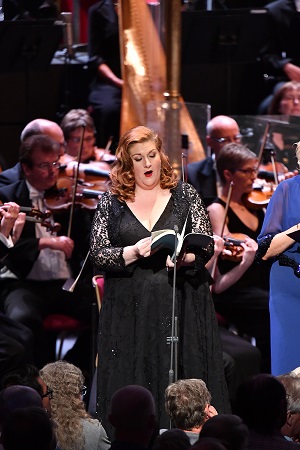 Tamara Wilson. Photo Credit: BBC/Chris Christodoulou.
Tamara Wilson. Photo Credit: BBC/Chris Christodoulou.
The First Part of this symphony is based on an ancient latin hymn about the Pentecost. Divine fire descends upon the Apostles, inspiring them to go forth on their mission to spread Enlightenment. Hence the direct attack with which "Veni creator spiritus!" was executed , creating an aural force field n which the soloists voices were embedded. Though the soloists - Tamara Wilson, Camilla Nylund, Marianne Beate Kielland, Claudia Huckle, Joélle Harvey, Simon O'Neill, Quinn Kelsey and Morris Robinson - stand at the front of the platform where they can be heard, they are primus inter pares - first among equals - operating as an extension of the chorus and orchestra.
In the Second Part of this Symphony, Mahler was inspired by Goethe's Faust, where Faust is redeemed by divine grace. The soloists are named but they operate as stages in the transformation,: they aren't acting out roles as if in an opera. Take the names too literally and miss the esoteric spirituality, where ego is sublimated for a higher purpose. The variety in the voice types reflects human diversity,. I liked the balance between O'Neill's earnest fervour and Kelsey's rich tone, anchored by Robinson's bass. These parts also operate in musical terms suggesting movement upwards and downwards, on simultaneous planes, also pertinent to meaning. The women's voices supply the Das Ewig-wiebliche, the "Eternal Feminine". This dichotomy between male and female, creator and muse, is central to Mahler's later work. The chorus of Blessed boys operates in parellel. "Wir werden früh entfernt von Lebenchören", They too, have been reborn by an act of faith, but how cheeky and childlike they are, like th child in Mahler Symphony no 4.
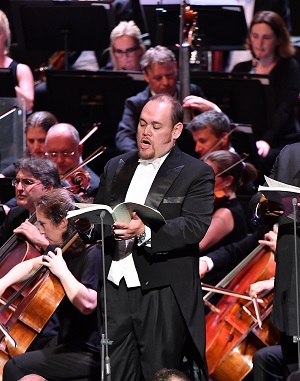 Quinn Kelsey. Photo Credit: BBC/Chris Christodoulou.
Quinn Kelsey. Photo Credit: BBC/Chris Christodoulou.
The vocal music in Mahler's 8th inevitably draws attention, and deservedly so. Thus the absolute importance of the silence that follows the ecstasy with which the first part ends. It represents a transition, bridging the two disparate parts, cleansing away what has gone before, settingb the scene for what is to come. But in many ways, the whole Symphony pivots on the first part of the Second Part where the orchestra alone speaks. Søndergård approached it with restraint, letting the detail shine. Pizzicato figures suggest tentative footseps entering the new territory evoked by sweeping strings, called forward by horn and flutes. The Chorus and echo repeat the pattern, marking the transition. Throughout the symphony, details were respected, so individual instruments like flutes, celesta and harps could be heard despite the size of the forces around them. Some conductors achieve much more luminous purity, but Søndergård made the most of generous choral resources at his disposal, which played to the strengths of the Royal Albert Hall.
Anne Ozorio
image=http://www.operatoday.com/Mahler%20Prom%20BBC%20CC.jpg
image_description=Gustav Mahler: Symphony no 8 Thomas Søndergård, BBC National Orchestra of Wales, BBC National Chorus of Wales, BBC Symphony Chorus, London Symphony Chorus, Southend Boys' Choir, Southend Girls' Choir, Tamara Wilson, Camilla Nylund, Marianne Beate Kielland, Claudia Huckle, Joélle Harvey, Simon O'Neill, Quinn Kelsey, Morris Robinson, BBC Prom 11 - 22nd July 2018
product=yes
product_title=Gustav Mahler: Symphony no 8 Thomas Søndergård, BBC National Orchestra of Wales, BBC National Chorus of Wales, BBC Symphony Chorus, London Symphony Chorus, Southend Boys' Choir, Southend Girls' Choir, Tamara Wilson, Camilla Nylund, Marianne Beate Kielland, Claudia Huckle, Joélle Harvey, Simon O'Neill, Quinn Kelsey, Morris Robinson, BBC Prom 11 - 22nd July 2018
product_by=A review by Anne Ozorio
product_id=Photo credit: BBC Proms/Chris Christodoulou
July 22, 2018
Beyond Gilbert and Sullivan: Edward Loder’s Raymond and Agnes and the Apotheosis of English Romantic Opera
It thus comes as a surprise to many opera lovers to learn that, before Gilbert and Sullivan teamed up in 1871, Britain had its own distinctive school of serious opera. This is conventionally referred to as English Romantic opera: it made its first appearance in 1834, continued to be produced into the 1860s, and the best-known examples were performed well into the twentieth century. It was strongly influenced by both German (especially Weber) and Italian (mainly Rossini, Bellini and Donizetti) models, but it also had distinctively British elements. The most important of these was the ballads, generally not too difficult to sing, which were designed to become hit songs outside the opera house – British composers were much more dependent on the sale of sheet music than their Continental rivals.
English Romantic opera had been almost completely forgotten when Richard Bonynge made a landmark recording of Michael William Balfe’s The Bohemian Girl in 1991. This was the obvious place to start a revival, for The Bohemian Girl was the most successful of all these operas. Inspired by Bonynge’s example, other operas from this period have since been revived and recorded. Bonynge himself has recorded William Vincent Wallace’s Lurline and Balfe’sSatanella. There have also been recordings of Balfe’s The Maid of Artois, Wallace’s Maritana, and – a favourite of this writer – George Alexander Macfarren’s Robin Hood. Alongside these have appeared George Biddlecombe’s standard study, English Opera from 1834 to 1864 (1994), and books on Balfe, Wallace, and Edward Loder. All this would have been quite unthinkable before 1990.
Most of these recordings have been met with surprise and delight by critics astonished at the fact that such impressive operas from the pre-Gilbert and Sullivan era even existed. Yet until now it has been impossible to listen to the work that critics have increasingly highlighted as the finest of all the English Romantic operas: Edward Loder’s Raymond and Agnes of 1855. Biddlecombe wrote of this as having ‘a quality of invention and dramatic power that raises it to an unusual position in English nineteenth-century opera’. Nigel Burton, in The Grove Dictionary of Opera, goes even further, emphasising the ‘surprising emotional intensity’, ‘the sense of drama and depth of musical characterization … close to Verdi’, which makes Loder ‘the foremost composer of serious British opera in the early Victorian period’.
In 1855, Raymond and Agnes was premiered at the Theatre Royal, Manchester, where Loder had been musical director since 1851. It enjoyed considerable success there, but when a London production was organised four years later, it was something of a disaster, thanks to the very poor quality of the performance. Loder (1809–65) was by that time suffering from the mental illness which painfully afflicted his final years, and was unable to promote his own work adequately. Thus this extraordinary opera disappeared from sight and was more or less unheard of for a century.
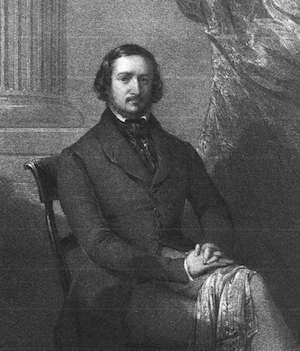 Edward James Loder, c. 1836 [Print, after an oil painting, in possession of Janet Snowman]
Edward James Loder, c. 1836 [Print, after an oil painting, in possession of Janet Snowman]
Then in 1963, Nicholas Temperley discovered a vocal score and immediately recognised Raymond and Agnes as a lost masterpiece. He organised a staged performance at Cambridge in 1966, and as word got out about just how good the opera was, critics travelled from all over the country to see it. They were all impressed. Charles Osborne wrote that he ‘was bowled over by Raymond and Agnes. Its intensity, and Loder’s gift for melody and musical characterization, were indeed Verdian and marvellously exciting.’ Andrew Porter called Loder a genius, John Warrack dubbed the Act 2 quintet ‘magnificent’ and Stanley Sadie thought it ‘would not disgrace middle‑period Verdi’.
After all the excitement in 1966, one might suppose that Raymond and Agnes could not be forgotten again. Yet it was. The problem was that in the 1960s, no libretto was thought to survive, and Temperley’s production was a speculative recreation of the opera based on the sung music. Although the BBC did broadcast a radio version in 1967, there was too much uncertainty about the opera for recording companies, or professional opera companies, to show interest. And so, once more, the dust gradually settled.
Finally, though, in the last decade there has been a steady movement toward reviving Raymond and Agnes in the form of a professional recording. A copy of the libretto, as used in London in 1859, has been located, and musicologist Valerie Langfield has spent years creating a definitive performance edition. When Retrospect Opera, the British charity, was founded in 2014, their first goal was to record Raymond and Agnes. It has been a crowdfunded project, with over 200 donations coming in from all over the world. Richard Bonynge was the obvious conductor to turn to, and a studio recording under his baton was made in October 2017. It is being released this summer complete with a sumptuous booklet containing the full libretto and three authoritative essays.
It must be confessed that the title, Raymond and Agnes, does not raise the same degree of interest as The Bohemian Girl or Robin Hood. It can sound prudishly ‘Victorian’. But this is very misleading. The title was in existence long before the opera, having been given to various works derived from Matthew ‘Monk’ Lewis’s classic Gothic novel, The Monk (1796), which had much the same impact in the 1790s as Alfred Hitchcock’s Psycho had in the 1960s, fascinating, horrifying and appalling people. The Monk contains several intertwined stories – that of the lovers Raymond and Agnes is just one of them, and when that part of the story began to be treated as an independent work, it was called, unimaginatively, Raymond and Agnes. Loder’s librettist, Edward Fitzball, adapted this time-tested story, enlarging and complicating it with elements drawn from Lewis’s play, The Castle Spectre (1797), and Weber’s Der Freischütz.
The plot is very intricate, no doubt; the listener needs to make some effort to understand what is happening. It is also improbable in the extreme. But it is full of intensely dramatic situations and inspired Loder’s greatest music. Although Raymond and Agnes does contain some of the ballads that the Victorians demanded, it is in no sense a ‘ballad opera’. Its musical core is found in the duets and ensembles, composed with a Verdian level of force and conviction. The three central characters, Raymond (tenor), Agnes (soprano) and their sinister nemesis, the Baron of Lindenberg (bass-baritone), are brought together in various combinations and with every variety of emotion, from the most passionate youthful love to the profoundest hate, from tender gratitude to remorseless revenge. These scenes are orchestrated with a mastery unprecedented in nineteenth-century English opera, and make the strongest possible case for taking pre-Gilbert and Sullivan works seriously.
In Loder’s youth, Weber was making his huge impact on English opera, first with the sensationally successful adaptations of Der Freischütz (one of them made by Fitzball) in 1824, then with Oberon two years later. Weber seems to have been, enduringly, Loder’s greatest inspiration, and it is certainly not fanciful to imagine these German Romantic operas giving him his sense of vocation. By 1827, young Loder was studying music in Germany with Ferdinand Ries, and in 1834, when his own operatic career commenced, he introduced himself to the British public as ‘a German Student in music’. Unlike Balfe, with his mainly Italian influences, Loder wanted to create an English Romantic opera that could stand beside and claim kinship with the works of Weber and his German followers. Raymond and Agnes, with a story appropriately set long ago in a Romantic Germany of forest and castle, represents a most satisfying fulfilment of this goal.
Retrospect Opera’s recording of Raymond and Agnes can be ordered directly through their website ( www.retrospectopera.org.uk ), as well as through standard music retailers.
David Chandler
image=http://www.operatoday.com/R%26A_front_cover.jpg image_description=Raymond and Agnes by Edward Loder {Retrospect Opera RO005 [2CDs]} product=yes product_title=Beyond Gilbert and Sullivan: Edward Loder’s Raymond and Agnes and the Apotheosis of English Romantic Opera product_by=Commentary by David Chandler product_id=Retrospect Opera RO005 [2CDs] price=£17.95 product_url=http://www.retrospectopera.org.uk/CD_SALES/CD_Sales_R&A.htmlJuly 19, 2018
A Donizetti world premiere: Opera Rara at the Royal Opera House
L’Ange de Nisida is one of the middle knots in a cat’s-cradle of sources. In 1838, frustrated by the obduracy of the Italian censors, Donizetti moved to Paris and within just a few months his operas were being acclaimed in all the capitals major theatres. Les Martyrs (a revision of Poliuto, which had been disallowed from the Neapolitan stage) was admired at L’Opéra, which had also commissioned Le Duc d’Albe; La Fille du régiment had a successful premiere at the Opéra-Comique; a French version, prepared by Donizetti, ofLucia di Lammermoor opened at the Théâtre de la Renaissance in August 1839. No wonder Berlioz complained that Donizetti’s presence in Paris was a ‘véritable guerre d’invasion’.
The success of Lucia led the Théâtre de la Renaissance to commission a new work with a libretto by Alphonse Royer and Gustave Vaëz - L'Ange de Nisida. Donizetti putLe Duc d’Albe on hold and began work on L’Ange de Nisida, drawing on the score of Adelaide, an incomplete opera semiseria. The bankruptcy of the Théâtre de la Renaissance put a spanner in the works, though; ever the pragmatist, Donizetti drafted in Eugene Scribe to re-work the libretto, set about adapting the score of L’Ange de Nisida, added a little music from Le Duc d’Alba, and La Favorite was born. The latter was premiered on 2nd December 1840 at L’Opéra, while L’Ange de Nisida was condemned to nearly two decades of silence and obscurity.
10 years of painstaking detective and re-construction work by Italian musicologist Candida Mantica have brought the 800-page score back to life. Mantica has shown that press reports from La France musicale and La Revue et Gazette musicale, dating from February 1839, confirm that not only was the opera complete, but that rehearsals were underway and that the Théâtre de la Renaissance had prepared a mise-en-scène. The scholar argues that the reconstruction of L’Ange de Nisida (from the autograph score of La Favorite and other materials in the Bibliothèque nationale de France) illuminates Donizetti’s creative process, enables comparison of the dramatic and musical characteristics of French and Italian genres at this time, and offers information about the history of Théâtre de la Renaissance. [1]
Set in 1470 in Nisida and Naples, L’Ange de Nisida serves up the standard elements of opera semiseria - a tragic love-triangle and a comic strand. It also makes one rue, ‘If only they’d talked about things’, for the characters are all sure of their own plans and ignorant of those of others, and the result of their misconceptions is muddle and misery.
Leone de Casaldi, exiled from the army after a duel, flees to Nisida, an island off the Neapolitan coast. He yearns to see his beloved Sylvia who, unbeknown to Leone, is the mistress of King Fernand of Naples and is much admired by his people. Sylvia, annoyed at being lured to Naples from her native Andalusia with the promise of a husband only to become a mere paramour, keeps both admirers at arm’s length. Don Gaspar, Chamberlain to the King, meets Leone, learns of his need for refuge and starts meddling. In brief: Leone lands up in gaol before Sylvia’s pleas gain his release; the King’s plan to wed Sylvia is scuppered when a monk appears brandishing a Papal Bull threatening to send Sylvia to a convent if the King defies Rome and marries her; and Don Gaspar comes up with a plan by which Leone will marry Sylvia, then be banished so that the King can keep Sylvia as his mistress. After various mix-ups, the deceptions are discovered, and Leone decides to become a monk. Sylvia, near death, follows him to beg forgiveness for doubting his fidelity, but when they attempt to flee she expires at his feet.
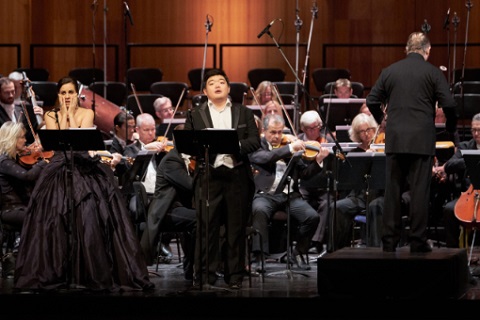 Joyce El-Khoury (Sylvia), David Junghoon Kim (Leone) and Sir Mark Elder. Photo credit: Russell Duncan (Opera Rara/ROH).
Joyce El-Khoury (Sylvia), David Junghoon Kim (Leone) and Sir Mark Elder. Photo credit: Russell Duncan (Opera Rara/ROH).
Mark Elder’s commitment and concentration were noteworthy. There was not the smallest motif in the choral or orchestral parts that was not carefully, lovingly gestured and nurtured. The balance between soloists and orchestra was superb, especially as the ROH Orchestra had been released from the nether regions and placed on stage. Elder made sure that the imaginative woodwind colours registered, allowing us to enjoy not only Donizetti’s orchestrations but also those of Martin Fitzpatrick who has fleshed out some of the sketchy passages in the sources. Both Chorus and Orchestra demonstrated an excellent appreciation of style and a feeling for the dramatic character of the piece, and Elder’s energy was unflagging throughout the two and a half hours of music.
As the Chancellor puffed up with his own self-importance and misguided assurance of his Machiavellian nous, Laurent Naouri squeezed ever dramatic drop from the role of Don Gaspar; energised, colourful, attentive to the text and nimble in the patter, Naouri made a considerable contribution to the theatrical impact of this concert staging. Act Three is full of musico-dramatic interest, and Naouri’s duet with Vito Priante’s King Ferdinand, was a highlight of the evening, as he sought to back-track on his plan when he realised that Leone was truly in love with Sylvia.
I have to confess that David Junghoon Kim, a former Jette Parker Young Artist, has not impressed me overly in the past, singing competently and sometimes acting a little stiffly. But, I’m now prepared to eat my words: this was a tremendous performance which revealed a sure sense of bel canto idiom and a powerful tenor with plenty of penetrating presence. His phrasing was elegant, from his first avowals of love to his bitter rejection of the King, when Leone learns of Don Gaspar’s manoeuvrings and throws down the sword that he had previously put at the King’s service. The tenor went from strength to strength, growing in dramatic confidence as the action progressed. As the machinating monk who thwarts the amorous intrigues, Evgeny Stavinsky was also superb, revealing a lovely warm bass.
Joyce El-Khoury seemed a little out of sorts as Sylvia. She looked and sounded hesitant initially, and her tone never really found its shine or coloration. Though she sang with discerning shapeliness of phrase in the Act 3 cabaletta - in which she laments Leone’s apparent, but mistaken, dishonour - the following cabaletta (adapted from Maria di Rohan, owing to a gap in the sources), was lacking in fluency and clarity.
While the first three Acts were fully engaging, Donizetti seems rather to have lost his way a little in Act 4, where the extended quiet, plaintive duet for Leone and Sylvia resulted in a dissipation of dramatic energy and, for this listener at least, lessened the emotive impact of the tragedy. But, we are indebted to Opera Rara for yet another ‘first’ and for their courage, commitment and stamina in pursuing the rare and vanished in this repertoire.
L’Ange de Nisida is repeated on 21st July. A live live recording will be made for release in 2019, marking the company’s 25 th complete opera recording by the composer and Sir Mark Elder’s ninth Donizetti title for Opera Rara.
Claire Seymour
Donizetti: L’ange de Nisida (Libretto by Alphonse Royer and
Gustave Vaëz)
Opera Rara: Conductor - Mark Elder
Sylvia - Joyce El-Khoury, Leone de Casaldi - David Junghoon Kim, King
Fernand of Naples - Vito Priante, Don Gaspar - Laurent Naouri, Monk -
Evgeny Stavinsky, Orchestra of the Royal Opera House, Royal Opera Chorus.
Royal Opera House, Covent Garden; Wednesday 18th July 2018.
[1] Candida Mantica, ‘From Lucia de Lammermoor to L’Ange de Nisida, 1839-1840: Gaetano Donizetti at the Théâtre de la Renaissance’, Revue Belge de Musicologie/Belgisch Tijdschrift voor Muziekwetenschap , 2012, Vol.66, pp.167-179.
Photo credit: Russell Duncan (Opera Rara/ROH)
July 18, 2018
A stellar Ariadne auf Naxos at Investec Opera Holland Park
This co-production between Investec Opera Holland Park and Scottish Opera adds further bifocal perspectives. Antony McDonald’s production was originally staged in spring, behind the scenes of the mansion belong to ‘the richest man in Glasgow’, and now the director and designer has brought the show from north to south, morphing the Scottish pile into South Kensington’s Holland Park House.
The rival operatic and vaudeville troupes are cooped up in tatty trailers either side of the lawn, the burlesque comedians, circus artists and MC taking the air on the top of their grass-bound motorhome, the diva and her tenor lounging in a curtained caravan.
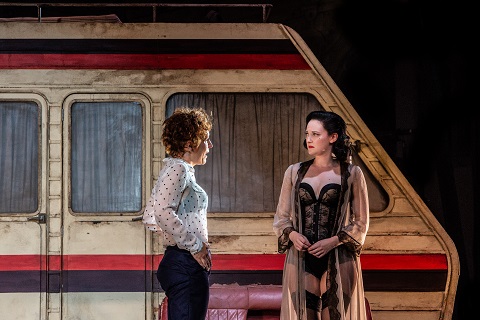
Julia Sporsén (Composer), Jennifer France (Zerbinetta) [Photo credit: Ali Wright]
The Prologue antics are rather frantic as Stephen Gadd’s deliciously poker-faced Music Teacher receives and rebuffs the news - delivered in broad Glaswegian brogue by Eleanor Bron’s Party-Planner (aka the Major Domo) - that his protégé’s classical-themed opera will need to be synchronised with the burlesque troupe’s acrobatics if the money-man’s pyrotechnic coda is to be lit by 9pm. The colloquial quips of Helen Cooper’s English translation help Strauss’s conversational idiom to skip along, but the acoustics of Opera Holland Park’s dome defeated Bron, and sadly I for one struggled to make sense of her spoken text (for which there were no surtitles - a pity, in an unforgiving venue).
Seria and buffa elements were confrontational rather than cohesive - perhaps that’s how it should be - but Julia Sporsén’s Composer brought disparate parts into a cohesive whole, with her Schubertian-Straussian paean an die Musik. Sporsén’s soprano shone and thrilled and both her declaration that music is a holy art and her interactions with Zerbinetta were genuinely touching. Jennifer France’s Dietrich-like, dynamic Zerbinetta may have thought she was engaging in mild flirtation, but her heart was clearly hooked by the Composer’s soulful sincerity and artistic and romantic integrity. And, here McDonald has added another piquant twist, making the Composer a woman - given that Sporsén sported a blue suit and the only hint of femininity was dark underwear showing through her white polka-dot blouse, some in the audience may have been confused -thereby adding a touch of spice to the androgynous aromas of Strauss’s original travesti interactions.
The gender-switch also means that it is a woman who has penned the tale of Ariadne’s love, loyalty and loss, subtly shifting the sympathies of the perspective. When Mardi Byers appears at the start of Act 2 and lingers beside a grand dining-table, abandoned mid-meal - taking a glug of red wine from a half-filled glass, gazing forlornly at an un-cut tiered cake - it’s hard not to see a hint of Miss Haversham’s Satis House mausoleum, spacious and handsome but in which ‘every discernible thing in it was covered with dust and mould, and dropping to pieces’, the most prominent object being ‘a long table with a tablecloth spread on it, as if a feast had been in preparation when the house and the clocks all stopped together’.
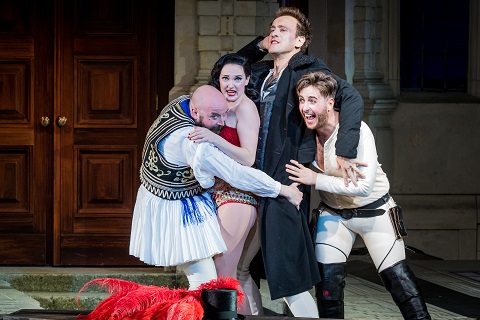 Daniel Norman (Scaramuccio), Jennifer France (Zerbinetta), Lancelot Nomura (Truffaldino) and Elgan Llŷr Thomas (Brighella). Photo credit: Robert Workman.
Daniel Norman (Scaramuccio), Jennifer France (Zerbinetta), Lancelot Nomura (Truffaldino) and Elgan Llŷr Thomas (Brighella). Photo credit: Robert Workman.
Dickens jilted bride ‘laid the whole place waste, as you have seen it, and she has never since looked upon the light of day’, and so this Ariadne stares yearning at the coffin which she longs to make her final resting place, sooner rather than later. Only the dulcet urgings of the three nymphs keep her from the abyss. Elizabeth Cragg (Naiad), Laura Zigmantaite (Dryad) and Lucy Hall (Echo) resembled the Queen of the Night’s Three Ladies in their gorgeous frocks, with bat-like trains, of white-grey-black: veritable bridesmaids-in-decay.
McDonald doesn’t quite keep seria and buffa in balance, and the vaudeville troupe threaten to up-stage the classical in Act 2, especially when they take a rest from the show-casing their spectacular circus skills - not one spinning china-plate fell - and they grab the wedding-cake from the table and flick through a book of Greek myths. Circus skills director Joe Dieffenbacher has mentored his tutees expertly and Alex Otterburn (Harlequin), Daniel Norman (Scaramuccio), Lancelot Nomura (Truffaldino) and Elgan Llŷr Thomas (Brighella) form a compelling vocal and kinetic ensemble. And, to be honest, it’s a relief, after several recent productions, to have a vaudeville troupe who are more Berlin satire than barbershop saccharinity.
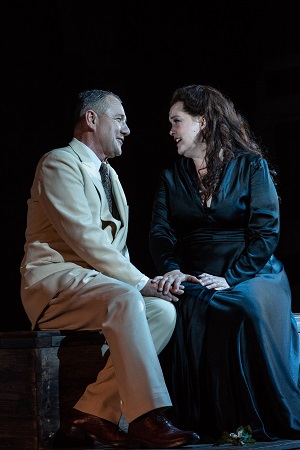 Kor-Jan Dusseljee (Bacchus) and Mardi Byers (Ariadne). Photo credit: Robert Workman.
Kor-Jan Dusseljee (Bacchus) and Mardi Byers (Ariadne). Photo credit: Robert Workman.
The arrival of Kor-Jan Dusseljee’s stentorian Bacchus - high notes sometimes a little overly ear-piercing but still remarkably true and firm - marked a shift in the dramatic dynamic from triviality to transcendence. Byers didn’t negotiate every phrase with Straussian suavity, but there were rich colours and honest emotions, and this Ariadne’s torment and troubles were palpably evident. In their final duet, she and Dusseljee effected the necessary translation and quickly the busy preliminaries to their romantic apotheosis were forgotten as they drew us into their unearthly paradise. It was at this moment too that conductor Brad Cohen, who had presided over an impressive account of Strauss’s sumptuous music up to this point, seemed to become totally absorbed, his arms swirling and sweeping all sumptuously into Strauss’s musical magic.
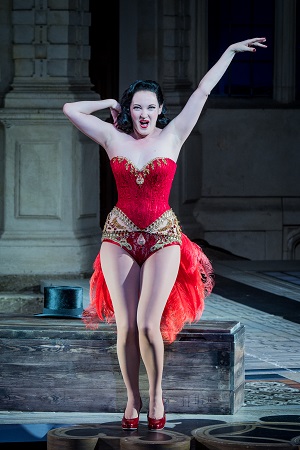 Jennifer France (Zerbinetta). Photo credit: Robert Workman.
Jennifer France (Zerbinetta). Photo credit: Robert Workman.
But the real transcendence was to be found elsewhere. When Strauss began setting Hofmannsthal’s libretto he said that he envisaged Zerbinetta as the leading role, and he told his librettist that he would be writing the part for a high coloratura soprano - Ariadne was originally to be a contralto - advising Hofmannsthal to listen to Selma Kurz, the first Zerbinetta, singing arias from La sonnambula or Lucia di Lammermoor if he wanted to get a feel for the idiom. And, so it was that Jennifer France was the true Sirius in a stellar show, delivering her vocal acrobatics with astonishing athleticism, precision and expressive nuance, all the while performing a teasing strip-show. Languor and assertiveness were wonderfully melded in sensual sublimity. It was hard to tell who enjoyed it most: France or the mesmerised audience.
And, it was France who held our attention in the closing moments. With Ariadne and Bacchus united in divine devotion, one by one the other characters crept in to witness the denouement and take their bows. Sporsén’s Composer was the last, and her arrival drew Zerbinetta from her embrace with Harlequin: it was the women’s love that had the last word. A love celebrated by a fountain of fireworks - an hour late, at 10pm, but still a fitting accolade for Investec Holland Park’s vocally stunning Strauss debut.
Claire Seymour
Richard Strauss: Ariadne auf Naxos
The Prima Donna/Ariadne - Mardi Byers, The Tenor/Bacchus - Kor-Jan Dusseljee, Zerbinetta - Jennifer France, Harlequin - Alex Otterburn, Scaramuccio - Daniel Norman, Truffaldino - Lancelot Nomura, Brighella - Elgan Llŷr Thomas, The Party Planner - Eleanor Bron, The Professor of Composition - Stephen Gadd , The Composer - Julia Sporsén, The Producer - Jamie MacDougall, Naiad - Elizabeth Cragg, Dryad - Laura Zigmantaite, Echo - Lucy Hall , Wig Master - Thomas Humphreys, Butler - Trevor Bowes, Officer - Oliver Brignall; Director/Designer - Antony McDonald, Conductor - Brad Cohen, Lighting Designer - Wolfgang Göbbel, Choreographer - Lucy Burge, Circus Skills Director - Joe Dieffenbacher, Prologue Translation - Helen Cooper, City of London Sinfonia.
Investec Opera Holland Park, South Kensington, London; Tuesday 17 th July, 2018.
Photo credit: Robert Workman
PROM 5: Debussy’s Pelléas et Mélisande
That the semi-staging probably rescued the evening from large-scale failure - as many semi-staging’s do - had much to do with focussing the drama of this opera rather tightly. It was largely beautifully acted, with some of the symbolism and mystery of the text much less micro-managed than in a full-scale production of the opera.
I think Sinéad O’Neil’s staging is mostly admirable. It would have been easy to have done very little, but she does quite the reverse. Some scenes are certainly more compelling than others - Golaud’s hair-pulling scene, with Mélisande writhing as if bound to a stake, is rather monstrously done. Golaud, from one of the choir stalls, acts just like a malevolent puppet-master. The end of Act III, where Golaud persuades Yniold to spy into the windows of the tower, was genuinely rather terrifying - indeed, it’s reasonably rare to find any production where the tension between these two characters seems to fit with the music Debussy wrote but it does here. Pelléas and Golaud wandering through the castle dungeons only worked through careful lighting but it was magnificently sepulchral nevertheless. On the downside, interior scenes looked and felt cluttered and had the unintended effect of making one feel everyone had fallen on very hard times; it often felt like downstairs at Downton Abbey. Importing the original productions hefty over-reliance on hand gestures, especially the perpetual covering of eyes, became slightly grating; one often felt one was trying to read sign language. Often there’s so much going on it’s against the very synthesis of the music itself. Much of this opera, for better or worse, is about stillness and that’s a concept that the staging really didn’t appreciate.
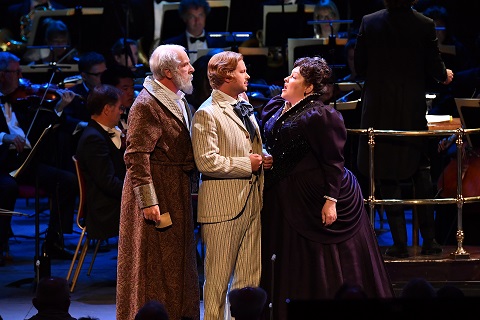 Brindley Sherratt (Arkel), John Chest (Pelléas), Karen Cargill (Geneviève). Photo credit: BBC/Chris Christodoulou.
Brindley Sherratt (Arkel), John Chest (Pelléas), Karen Cargill (Geneviève). Photo credit: BBC/Chris Christodoulou.
I did find the casting a problem. Debussy attached great significance to the libretto of this opera - indeed, the rhythms of the words are quite meticulously designed to be heard in this opera - so it was disappointing that so much of the sung French was so opaque. It had little to do with the fact that the hall sometimes swallowed voices, or they simply disappeared, rather that it wasn’t a particularly refined cast. In one sense this is a rather misty, or ethereal opera, and the lack of detail in the voices rather added to this. Karen Cargill’s Geneviève, for example, was luxury casting - but she was so velvety, so vocally secure that she rather forgot to bring any sense of mystery or depth to her character. Christopher Purves, as Golaud, seemed a tad one dimensional to me. This is perhaps the most vividly drawn character in the entire opera, but that was entirely irrelevant here. What we got was someone who acted beautifully but sang as if Golaud was entirely driven by anger and violence; the fact Purves felt the need to dominate the orchestra again suggested a lack of depth - this is a man possessed by raging jealousy, too, and innately virile; it didn’t come across that way. John Chest’s Pelléas began a little nervously - some of his A flats were flaky - but of all the male leads he was the most successful at pitching the balance between rhythm and concept - and his singing became notably more passionate during the evening. If the voice had been a little frayed earlier on, it was notably more secure by the time of his death. Christina Gansch’s Mélisande was girlish enough, but the blandness of the voice, and the lack of nuance, left me wondering why this particular Golaud and Pelléas would be involved with her at all. Only Chloé Briot’s Yniold - the sole native French speaker among this cast - was really a success at getting to grips with the text, and also doing something meaty with her role.
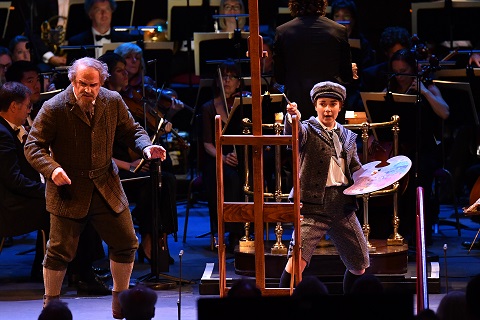 Christopher Purves (Golaud), Chloé Briot (Yniold). Photo credit: BBC/Chris Christodoulou.
Christopher Purves (Golaud), Chloé Briot (Yniold). Photo credit: BBC/Chris Christodoulou.
The undisputed highlight of the evening was the playing of the London Philharmonic Orchestra. I’ve rarely - if ever - heard this score better played. The LPO is becoming one of the great opera orchestras: time and time again, I found the detail a revelation, the internal instrumental voices, the clarity of phrasing and the impeccable balance of tone and colour remarkable. The woodwind, especially, have such flexibility they can almost do anything asked of them. I think one can certainly quibble with Robin Ticciati’s approach to the opera itself - and this was certainly reflected in the LPO’s overall sound. At times I did feel as if I was listening to Parsifal rather than Pelléas et Mélisande - the Wagnerian inferences are certainly in Debussy’s score but sometimes you wondered if Ticciati thought it was Klingsor wielding the sword rather than Golaud. The strings, too, sounded heavy at times - but what a wonderful, spellbinding richness of sound it was. Ticciati took a somewhat majestic view of the score, too, less overtly sensuous than some, certainly less French, but he can whip up tension and terror when it’s needed but there are also beautifully seductive, dark-hued moments too. It certainly won’t appeal to everyone, and sometimes borders on being self-indulgent, but the tightrope he walks is just narrowly a viable one.
The tightrope that Glyndebourne’s semi-staged production walked wasn’t entirely a successful one, but very few productions of this magnificent opera manage to make a complete success of it. Not the most satisfying Pelléas, but a ravishing orchestral feast I won’t soon forget.
Marc Bridle
Prom 5: Debussy, Pelléas et Mélisande (semi-staging based on production by Stefan Herheim)
Golaud - Christopher Purves, Mélisande - Christina Gansch, Geneviève - Karen Cargill, Arkel - Brindley Sherratt, Pelléas - John Chest, Yniold - Chloé Briot. Sinéad O’Neill; conductor - Robin Ticciati, London Philharmonic Orchestra, The Glyndebourne Chorus.
Royal Albert Hall, London; Tuesday 17th July 2018.
Available on BBC iPlayer for 30 days.
image=http://www.operatoday.com/Debussy%20Pelleas.jpg image_description=Pelléas et Mélisande, Glyndebourne Festival Opera at the BBC Proms product=yes product_title=Pelléas et Mélisande, Glyndebourne Festival Opera at the BBC Proms product_by=A review by Marc Bridle product_id= Above: Christina Gansch (Mélisande, Christopher Purves (Golaud), Pelléas (John Chest)Photo credit: BBC/Chris Christodoulou
July 17, 2018
Thought-Provoking Concert in Honor of Bastille Day
“We wanted this recital to be beautiful even when the political climate is so ugly,” said Jones, of the choice of French-song centered evening.
And beauty the sopranos did indeed present with a highly ambitious, challenging program that included Benjamin Britten, Gabriel Fauré, Viktor Ullman, and a world premiere by composer Martha Sullivan.
Elise Brancheau began the program with Les Illuminations, op. 18 by Benjamin Britten. Brancheau oscillated between coy gaiety and deep desperation in order to illustrate the pathos of poetry imbued with pastoral playfulness and perverse paintings of human freakishness. Martin Néron played the at-times perversely cheerful stylings of Britten with aplomb, supporting Brancheau in a display of skillful duetting. Brancheau navigated the difficult cycle with incredible breath control, musical sensibility, and a shimmering instrument seemingly unphased by the music’s many vocal challenges.
Brancheau’s performance of the world premiere of Lunaire by Martha Sullivan also proved a success.
“The collaboration came about by chance,” said Brancheau of her partnership with Sullivan. “She [Sullivan] reached out to me and said she had always wanted to set these poems [by Albert Giraud].”
Sullivan’s music is lyric and sweeping, and clearly displays her knowledge of the soprano voice. The piano moves between complex harmonies while repeating haunting leitmotifs that linger in the mind long after each musical phrase has ended. The vocal line deftly illustrates the eeriness of each of Giraud’s poems with frequent moments of musical word painting, supported by a thrusting piano part that almost evokes a more sinister Debussy.
Shannon Jones collaborated with pianist Keith Chambers to present Cinq Melodies “de Venise” by Gabriel Fauré. Jones brought a lush and sensual interpretation to Fauré’s songs. Her second selection, a set of Viktor Ullman songs setting the poetry of Louïse Labé, displayed the full depth and range of Jones as a singer, as well as Chambers as a pianist. Jones sang through two songs of unrelentingly high tessitura with clear and striking vocal timbre, while Chambers ripped through the difficult piano accompaniment with nearly unbelievable ease.
Ullman was a striking and poignant choice by Jones, who said of the composer, “He and his works are a reminder of what we stand to lose if we look at people as a race versus a being.”
The evening, skillfully handled by all the performers, was not impressive merely for its excellent musical displays, but for the thoughtfulness of programming and nuanced interpretation of beautiful and meaningful poetry. Each artist had something to say throughout the course of the evening, and the musical choices provoked emotion and discussion in a way that only a meaningfully curated concert can.
Alexis Rodda
image=http://www.operatoday.com/Prise_de_la_Bastille.png image_description="The Storming of the Bastille" by Jean-Pierre Houël [Source: Wikipedia] product=yes product_title=Thought-Provoking Concert in Honor of Bastille Day product_by=A review by Alexis Rodda product_id=Above: "The Storming of the Bastille" by Jean-Pierre Houël [Source: Wikipedia]Dido in Deptford: Blackheath Halls Community Opera
Graham foregrounded Aeneas’ and Dido’s obvious physical passion as the Trojan Prince tussled with a vicious Sorcerer - a devil in a sharp grey suit who wooed wickedly and sought to win the Queen of Carthage for himself. The Sailor’s song - sung with delightful indelicacy by a swarthy Alun Butler - was a riotous celebration of imminent departure, goading the tinsel-bedecked Chorus to rowdily anticipate their arrival in the Italian capital: “Rome is Home” screeched the lofted banner.
Any doubts that Dido may have had about her fate would quickly have been dispelled from the start, by the sinister Spirits clad in silver-grey smocks who squatted on the floor around the Queen’s prone body, scribbling prophetic graffiti: “You are going to die”, “The Queen of Carthage is dead”, “Blood”, “Betray”, read the ominous chalk jottings, the twirling white script forming an ever-increasing spidery web on the black floor as the evening progressed. Graham suggests that the ominous words are no Delphic divination but rather the outer projection of Dido’s own, sometimes suppressed, consciousness, when she explains, ‘Our production is inspired by these words from the libretto, “Great minds against themselves conspire, and shun the cure they most desire”. The stage is Dido's mindscape. We see everything as a manifestation of her thoughts.’
And so, Dido’s depression and inner unrest at the start of the opera is projected through the storm with which we begin and which shipwrecks Aeneas and his people as they flee from Troy, after Jupiter’s commands to the Trojan Prince have boomed electronically and rather ear-splittingly across and around the Albany’s round theatre-space, sending the Trojans on their fateful journey to Rome. Elliot Griggs’ lighting conjured thunder and tempest, as the singers of Blackheath Halls Opera Chorus floundered noisily, desperately seeking the safety of the Carthaginian shore. The Choruses generally may not have been ‘crisp’ but they were hearty, well-tuned, and the words were clear.
Founded in 2007, this year BHCO has been forced to decamp from its familiar home - the Blackheath Halls are currently undergoing a £3 million refurbishment - to The Albany Theatre in nearby Deptford. The theatre-in-the-round, skirted by a narrow circle of seats at ground level and in the balcony, proved eminently suitable for Graham’s concept, providing a large space across with the chorus could present the opera through physical and visual gestures as much as through song and music.
And, the physical movement was energetic, noisy, and sometimes a little chaotic, as the Chorus gossiped and laughed, whooped and stamped - sometimes obliterating the buoyant dances which conductor Lee Reynolds was inspiring from the excellent small instrumental ensemble - and carried in and assembled the constituents parts of a banqueting table. But, the spirit was one of vigour and life. The community chorus ran energetically about the auditorium and up into the balcony, peering at the action from the gallery - and occasionally blocking the audience sight-lines! - as Graham sought to use every inch of the available space.
The professional cast were excellent, and it must have been inspiring for both the Conservatoire singers and the members of the community to sing alongside them. German mezzo-soprano Idunnu Münch was the eponymous Queen, making her UK premiere after several years at Oper Stuttgart. Münch has a lovely rich voice, just perfect for passionate Queen of Graham’s conception; at first, I feared that she might misjudge the venue - her voice is large and she employed a very full vibrato in her first aria of despair, ‘Ah Belinda, I am prest with torment’, but she quickly found the measure of the acoustic and portrayed the Queen as a very ‘real’ woman, using every colour and nuance to win our sympathy. I’m not sure why this Dido seemed so shocked by her profusely bleeding wound given that it is self-inflicted, but Münch carried off Dido’s moments of delight and distress with equal dramatic conviction. ‘When I am laid in earth’ was truly touching, and the apparent resurrection of Dido’s spirit, as her prone body was strewn with red poppy petals by the children of the Chorus, was consoling.
Marcus Farnsworth was relaxed of voice and movement as the denimed Aeneas, though he took quite a battering from the pummelling fists of the children furious at his betrayal. Farnsworth and Münch conjured some credible regal ‘chemistry’, and he conveyed Aeneas’ honest love and subsequent confusion. Alison Rose’s lovely clean sound was a perfect complement to Münch, and she made Belinda a more supportive companion to the Queen than is sometimes the case, projecting beautifully when she sang from the balcony.
Only the descent of some wintery branches from the ceiling hinted at the arrival of the Sorcerer’s fearful voice from aloft. There was a touch of Britten’s Oberon when William Towers descended and set about luring the Queen into his sensual snare, particularly when, Pied Piper-like, the children joined his pack of witches, trailing behind their master - evil, masked acolytes. Towers’ microphone-assisted command, in the guise of ‘Mercury’, to Aeneas, to remind him of his destiny in Rome, was strange and sinister.
The students from Trinity Laban made impressive contributions, especially Sofia Celenza who exhibited vocal and physical poise in the role of the Second Woman.
Graham’s Dido may not have been quite what Purcell imagined when he conceived the opera for the genteel ladies of Josias Priest’s Chelsea boarding school (if that was indeed where the opera was first performed), but it was true to the work’s humanity, and performed with commitment and not inconsiderable charm.
Claire Seymour
Blackheath Halls Opera 2018: Purcell - Dido & Aeneas
Dido - Idunnu Münch, Aeneas - Marcus Farnsworth, The Sorcerer - William Towers, Belinda - Alison Rose, Second Woman - Sofia Celenza*, First Witch - Rebecca Leggett*, Second Witch - Jennifer Mitchell*, Spirits (Guste Sinkeviciute, Jude Smith, Laura Kislick, Leia Joyce, Stanislaw Kochanowski-Tym, Zarofina Farodoye), Sailor - Alun Butler, Chorus leaders* (Katy Allen, Jennifer Barwise, Emily Kirby Ashmore, Charlotte Levesley); Director - Polly Graham, Musical Director - Lee Reynolds, Designer - April Dalton, Lighting Designer - Elliot Griggs, Movement Director - Francesca Mangiacasale, Blackheath Halls Opera Chorus, Blackheath Halls Orchestra, Pupils from Charlton Park Academy, Royal Greenwich and Blackheath Halls Youth Choir.
Albany Theatre, Deptford; Monday 16th July 2018.
* Students at Trinity Laban Conservatoire of Music and Dance image=http://www.operatoday.com/MF%20and%20IM%20Workman.jpg image_description=Dido and Aeneas, Blackheath Halls Community Opera product=yes product_title=Dido and Aeneas, Blackheath Halls Community Opera product_by=A review by Claire Seymour product_id= Above: Marcus Farnsworth (Aeneas) and Idunnu Münch (Dido)Photo credit: Robert Workman
July 16, 2018
Summer madness and madcap high jinxs from the Jette Parker Young Artists
Director Noa Naamat and lighting designer Nick Havell made the panelled oak walls which have been serving so effectively as both a 1950s country club and Windsor Forest during the current revival of Robert Carsen’s production of Verdi’s Shakespearean swansong , work surprising well as a theatre-within-a-theatre, a lunatic’s cell, a Queen’s inner chambers and the Mediterranean coast. Pendulous chandeliers, potted palms, and a silver pistol were a few of the minimal props that did good service. And, with bright penetrating colours and simple sets, moods, locales and dramatic tensions were deftly and pointedly established: the greens and purples which bathed the sleeping Ariadne, the blood red which tormented Rakewell in his dying moments before his ascent in the shimmering white clouds of the afterlife, the deep-sky blue which glistened with the sun’s gold behind the Bey’s terrace, all made a striking impression.
Conductor Sonia Ben-Santamaria was given the task of heralding the 2018 showcase, and though there were a few smudges in the opening fanfare from The Rake’s Progress the Orchestra of Opera North brass sound was bright and punchy, and the fanfare might have proved an efficient call-to-attention and curtain-raiser had it not been followed by the electronic tannoy reminder to switch off mobile ’phones and refrain from photography during the performance, rather dampening any excitement generated. And, the curtain was to stay firmly lowered for a little longer, during the overture to Offenbach’s La Belle Hélène, in which conductor Matthew Scott Rodgers conjured elegant and tasteful phrasing.
The show got underway with excerpts from Strauss’s Ariadne auf Naxos, though the task of establishing the context twice in quick succession, when we shifted from the conclusion of the Prologue to Ariadne’s first aria, not surprisingly proved challenging and the quick sequence of disparate numbers felt a little restless. As in Katharina Thoma’s Glyndebourne production , the commedia troupe were a barbershop quartet, skilled in soft shoe shuffles and adept at twirling a brollie, and their harmonies were sweet. Angela Simkin’s Composer hit the histrionic heights with aplomb and Haegee Lee’s Zerbinetta was a festoon of candy pink and vocally assured. Best of the bunch was Gyula Nagy’s Music Teacher, a poseur par excellence who nonchalantly smoked a cigarette through the Composer’s complaints and whose fore-curtain introduction to ‘Ariadne’ was a masterpiece of physical and vocal gesture.
Condemned to mental torment - and, in this production, self-harm - in the subsequent excerpt from Act 3 of The Rake’s Progress, Thomas Atkins’ Tom Rakewell nursed his Adonis-delusions with painful conviction. Atkins’ performance was one of the highlights of the showcase, and he was ably supported by Francesca Chiejina’s vocally sympathetic Anne Truelove and Simon Shibambu’s Father Truelove. The final ascent to the heavens was both poignant and transcendent: one could almost forget that any suggestion of ‘redemption’ is overturned by Stravinsky’s epilogue which reminds us that the devil makes work for idle hands.
Jacquelyn Stucker has made a strong impression during her first year as a JPYA, as Princess Azema in Semiramide and Frasquita in Barrie Kosky’s new Carmen ; she also won Second Prize in this year’s Glyndebourne Opera Cup. Here, her Ophélie - in the opening of Act 3 of Ambroise Thomas’s Hamlet - confirmed her accomplishment and stellar potential. Stucker sang with purity and colour, by turns and as required, and had plentiful stamina for the big vocal climaxes; but, more importantly, she really communicated Ophélie’s confusion, distress and emotional frailty while all the time sustaining vocal assurance and precision. Nagy returned as Hamlet, demonstrating that he can do existential frailty as well as entertaining farce; his fragmented ‘to be or not …’ monologue was consummately structured and projected. Simkin was a round-toned Gertrude while the earnestness of Shibambu’s prayer won a little sympathy for the murderous Claudius.
The best was saved till last. Attired in stunning scarlet, accessorised with designer clutch-bag and killer stilettos, Aigul Akhmetshina’s Isabella was a girl who knew her own mind and charms. Shibambu displayed a winning comic nous as the teased and tempted Bey Mustafà - tickled literally and figuratively by Isabella’s roving, fluttering fan. Haegee Lee’s emotionally wrought Elvira and Konu Kim’s hapless Lindoro threw themselves, and each other, back and forth across the wide stage, each determined to retain their loved one’s heart. The comic capers were manic, but expertly choreographed by movement director Jo Meredith, climaxing with a behind-the-plant-pot, now-you-see-me-now-you-don’t routine that was perfectly timed and flawlessly sung. Summer madness, indeed.
Claire Seymour
Jette Parker Young Artists Summer Performance: Director - Noa Naamat, Lighting Designer - Nick Havell, Movement Director - Jo Meredith, Orchestra of Opera North.
Stravinsky: The Rake’s Progress, opening fanfare
Conductor: Sonia Ben-Santamaria
Offenbach: La Belle Hélène, Overture
Conductor: Matthew Scott Rogers
Strauss: excerpt from Ariadne auf Naxos
Echo - Francesca Chiejina, Zerbinetta - Haegee Lee, Prima Donna/Ariadne -
Sarah-Jane Lewis, Dryad - Aigul Akhmetshina, Composer - Angela Simkin,
Naiad - Jacquelyn Stucker, Scaramuccio - Thomas Atkins, Brighella - Konu
Kim, Music Teacher - Gyula Nagy, Harlequin - Dominic Sedgwick, Truffaldino
- Simon Shibambu; Conductor - Jac van Steen, Piano - Nick Fletcher, Celeste
- Sonia Ben-Santamaria, Harmonium - James Hendry
Stravinsky: The Rake’s Progress, Act III, final scene
Anne Trulove - Francesca Chiejina, Tom Rakewell - Thomas Atkins, Father
Trulove - Simon Shibambu; Conductor - Jac van Steen, Continuo - James
Hendry
Thomas: Hamlet, Act III beginning
Ophélie - Jacquelyn Stucker, Gertrude - Angela Simkin, Hamlet - Gyula Nagy,
Servant - Dominic Sedgwick, Claudius - Simon Shibambu; Conductor - James
Hendry
Rossini: L’italiana in Algeri, Act I finale
Elvira - Haegee Lee, Isabella - Aigul Akhmetshina, Zulma - Angela Simkin,
Lindoro - Konu Kim, Taddeo - Gyula Nagy, Haly - Dominic Sedgwick, Mustafa -
Simon Shibambu; Conductor - Nick Fletcher
Royal Opera House, Covent Garden, London; Sunday 15th July 2018.
Photo credit: Clive Barda
Mefistofele at Orange’s Chorégies
It’s the famed librettist Arrigo Boito’s only opera, premiered in 1868 when he was 26 years-old, filled with youthful musical idealism and the then avant-garde ideas flowing down from the north. Though what we have seen just now in Orange’s huge old Roman theater is his 1876 version, much reduced in length. Faust is now a tenor (a flashier voice) and there is the added Act III grand duet “Lontano, lontano” - the too good to pass up opportunity to sentimentally dwell on what Faust and Marguerite’s lives might have been.
Said to have been composed in response to Gounod’s superficial treatment of the famed legend Boito’s opera has nonetheless become a vehicle for the world’s liveliest metteurs en scène to show supercilious wit. To be recalled are a couple of late 1980’s productions — the Genoa production by American director Ken Russell where the religious fervour of nuns becomes the fuel for a spaceship headed to the Walpurgis Night, and the Geneva production by Canadian director Robert Carson with its bared female breasts and exposed male genitalia. More recent was the Jean-Louis Grimpa production in Montpellier where Mefistofele exulted in Grecian beauty from afar, perched among audience on a balcony railing, legs dangling into the void.
Jean-Louis Grimpa, now in charge of the Chorégies d’Orange (as well as Monaco’s Opéra de Monte-Carlo) based his production for Orange’s Théâtre Antique on his Montpellier production, the difference becoming that of scale, the farcical indulgences of Montpellier were sacrificed to the monumentality of Roman architecture. The directorial wit was now expressed in a tongue-in-cheek explosion of staging grandeur. So much spectacle, so little content. And so much fun.
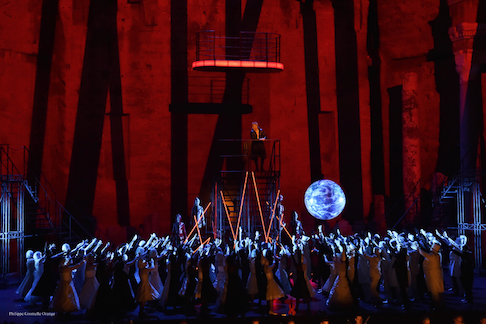 The Walpurgis Nacht, and the faraway earth
The Walpurgis Nacht, and the faraway earth
The Orange stage is 300 plus feet wide, the height of the back wall is 100 plus feet. The combined choruses of the operas of Monaco, Nice and Avignon swathed in miles of white gossamer-like fabric flowed on, across and off the stage as the heavenly choirs. For the Walpurgis Night this massive chorus wore exaggerated, hugely colorful village fair theater costumes. They cavorted onto and off of the stage and wildly upon and down from several rolling, welded metal staircase ramps (the only constructed scenery) abetted by clowns on very high stilts and more clowns on roller blades.
All this against full back-wall color projections, evoking marvel at the advancement of theatrical projection technology at Orange over the past ten years, from the first black and white moving shadows of a Trovatore way-back-when to the now detailed, almost photographic architectural images. Of spectacular effect was a small platform that hung from the recently added roof now covering the Théâtre Antique’s stage that slowly descended (the platform) while the image of an acropolis slowly arose. The physical sensation of ascent this trick created was truly amazing!
Opera’s stories are told to the Théâtre Antique’s 9000 spectators in bold strokes, without subtlety. The staging in Orange is always evident, principles congregate down stage center where they are both singer and scenery, and where they take advantage of the theater’s amazing and excellent acoustic to sing their arias and duets of which Boito’s Mefistofele offers a plentitude.
As is usual Mefistofele is never far from front and center anyway. Here it was Uraguay bass-baritone Erwin Schrott who managed a non-stop plethora of flashy and triumphant poses for three solid hours, including a beyond-the-pale series of catcall whistles as he collapsed on a walkway just by conductor Nathalie Stutzmann for the final notes of the opera. Mr. Schrott was in fine voice indeed, and well deserves to count Mefistofele among his signature roles (Don Giovanni as example of another).
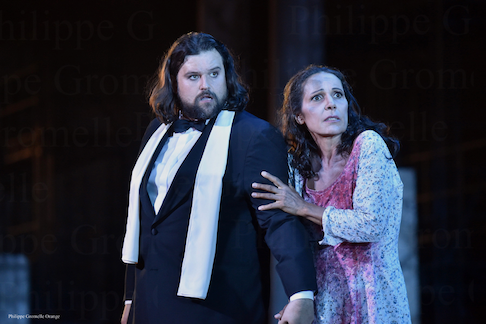 Faust and Margherita
Faust and Margherita
Monaco born tenor Jean-François Borras was a large scale Faust, boasting sufficient heft and presence of body and voice to persuade even the furthest away spectators of his earnest pursuit of enlightenment and his distress at the plight of poor Margherita. Certainly more at home in the French repertory his Faust missed the Italianate mannerisms that could have made Boito’s naive music into a more convincing vocal display. The same may be said of the Margherita of French mezzo-soprano Béatric Uria-Monzon who was Orange’s spectacular Carmen in 2008 (among many roles at the Chorégies). She delivered the famous “L’altra notte in fondo al mare” in splendid voice though she did not move us with the glorious variation of vocal colors that have made this aria a standard audition piece for Italianate voices.
The Orchestre Philharmonique de Radio France was conducted by Nathalie Stutzmann, a frequent collaborator with Jean-Louis Grimpa at the Opéra de Monte-Carlo. Amazingly, impeccable pit/stage ensemble at Orange is the norm, and this Mefistofele was no exception. The two harps of the orchestra earnestly pursued their angelic duties, the satanic bass drum player gave a virtuoso performance together with the dramas that unfolded on the timpani. Mme. Stutzmann held it all together ably without resolving the question of whether Boito’s youthful attempt at composing opera is great or even good music.
The world awaits a production of Boito’s 1867 La Scala score. Only then may we know if Boito’s opera is the send-up of Goethe’s tale that so amuses stage directors.
Michael Milenski
Cast and production information:
Mefistofele: Erwin Schrott; Faust: Jean-François Borras; Margherita/Helen: Béatrice Uria-Monzon; Marta: Marie-Ange Todorovitch; Wagner/Nero: Reinaldo Macias; Pantalis: Valentine Lemercier. Orchestre Philharmonique de Radio France. Choruses of the operas of Avignon, Monte-Carlo and Nice, Children’s Choir of the Académie Ranier-III-de-Monaco. Conductor: Nathalie Stutzmann; Stage Director: Jean-Louis Grinda; Scenery: Rudy Sabounghi; Costumes: Buki Shiff; Lighting: Laurent Castaingt; Videos: Julien Soulier. Théâtre Antique, Orange, France, July 9, 2018)
image=http://www.operatoday.com/Mefistofele_Orange1.png
product=yes
product_title=Mefistofele at Orange's Chorégies
product_by=A review by Michael Milenski
product_id=Above: Erwin Schrott as Mefistofele [All photos copyright Philippe Gromelle, courtesy of the Chorégies d'Orange]
July 15, 2018
Mascagni's Isabeau rides again at Investec Opera Holland Park
It’s not just the medieval milieu recreated by takis’ set - high majestic towers, low townhouses with windows that will be sealed tight when Isabeau rides through the streets, twisting stairwells and alleyways - or the heraldic colour and chivalry.
It’s the way that Lloyd-Evans seems to mimic the blending and subversion of genres that Chaucer achieved in narratives such as the Franklin’s Tale in which the quasi-magical romance of the Breton lay form, with its characteristic courtesies and courtly love, is countered with real, painful human passions which defy classification and custom. (Readers seeking a resumé of genesis and plot might like to turn to my interview last month with David Butt Philip , who sings the role of Folco in this production.)
Some of takis’ symbolism has a pre-Raphaelite preciousness about it - the silver falcon sculpted by Benedict Romain and manoeuvred by three ‘angels’ which symbolises the transcending freedom bestowed by Folco’s love; the juxtaposition of glossy crimson, emerald and purple robes with Isabeau’s Christ-like white purity; floral and decorative iconography; Isabeau’s Rapunzel-like red-tresses (a languorous Elizabeth Siddal as painted by Edward Burne-Jones came to mind) - but that’s not unreasonable given the archaisms and allusiveness of Luigi Illica’s libretto.
Sometimes the manoeuvring of the set by the Opera Holland Park Chorus feels rather cumbersome and effortful, as they rotate cottages, slide walls and spiral staircases. And, at the start of the opening night performance, when the round exterior of the drum tower refused to budge and King Raimondo remained concealed within it was unfortunately reminiscent of the malfunctioning of the wobbly sets of 1970s sitcoms. It was also regrettable that when the knights arrive seeking to win the princess’s hand - Ubaldo of Edinburgh, Arundel of Westerne, Ethelberto di Argile, Randolfo of Dublin - Illica’s faux archaic nomenclature raised a chuckle. Despite their resplendent armour and pompous righteousness, Isabeau was clearly not impressed by her Arthurian suitors’ deeds of high honour and derring-do.
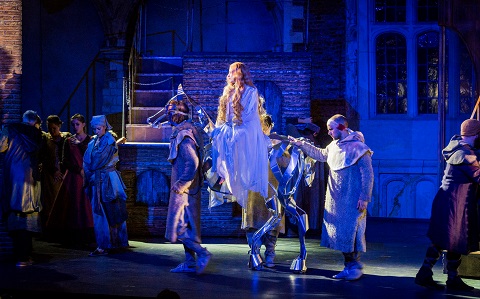 Anne Sophie Duprels as Isabeau with the Angels and members of the Opera Holland Park Chorus. Photo credit: Robert Workman.
Anne Sophie Duprels as Isabeau with the Angels and members of the Opera Holland Park Chorus. Photo credit: Robert Workman.
But, the wide stage area is engagingly filled and populated, and there are some effective moments of dramatic pageantry, such as the lauded arrival of the Outlaw Knight, the King’s nephew Ethel, who lifts his shield aloft to claim his bride. And, the naked horse-ride itself is thoughtful staged and paced, with the musical and dramatic tempo increasing breathtakingly when Folco brazenly admires the humiliated Isabeau, and climaxing in the desperate assertion with is her sole utterance in the second Act, ‘Folco!’ Most especially, the duet which dominates the final Act is tremendously powerful, as both the promise of love and the threat of death escalate to fever pitch.
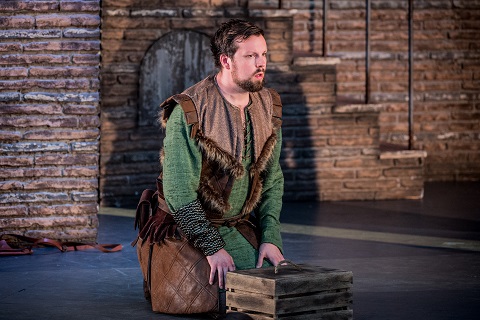 David Philip Butt (Folco). Photo credit: Robert Workman.
David Philip Butt (Folco). Photo credit: Robert Workman.
When I asked David Butt Philip if Isabeau’s neglect was due to the difficulty of casting two singers who could surmount the demands - sustained high tessitura, stamina - of the two lead roles, the tenor modestly demurred that the while the opera was challenging, Mascagni’s dramatic design helps the singers to pace themselves. Nevertheless, the roles of both Folco and Isabeau sounded pretty taxing to me, and Investec Opera Holland Park were lucky to have two singers who tackled them so boldly and with such persuasive and stirring accomplishment.
Butt Philip conveyed every ounce of Folco’s youthful optimism, passion and directness; the merry woodsman had the openness and spontaneity of a Papageno in Act 1, while Folco’s consuming joy as he showered the naked rider with flowers and sang ecstatic paeans to her beauty, with match his floral tribute, was palpable. When, in the Act 3 duet, he accused Isabeau of hiding her true passion behind a false guilt, Butt Philip’s vocal and physical acting was superb. Throughout he displayed impressive muscular power to match the strength of Folco’s honest feeling.
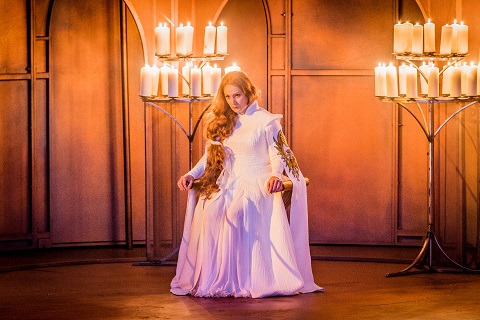 Anne Sophie Duprels (Isabeau). Photo credit: Robert Workman.
Anne Sophie Duprels (Isabeau). Photo credit: Robert Workman.
Anne Sophie Duprels is fast becoming not so much a princess but a queen of Investec Opera Holland Park, after her acclaimed performances in Mascagni’s in 2016 Iris and last year’s production of Leoncavallo’s Zazà . Duprels’ Isabeau was elevated and chaste - she seemed to share Mélisande’s disconcerting blend of ethereal, fairy-tale other-worldliness and tangible physical sensuality. Vocally, she switched from heavenly to highly charged - and from lyricism and declamation - in an instant. Her voice shone lustrously but there were also rapturous pianissimos - one sustained stratospheric whisper towards the close seemed to suspend time - and there was variety of both colour and dynamics. A truly regal performance.
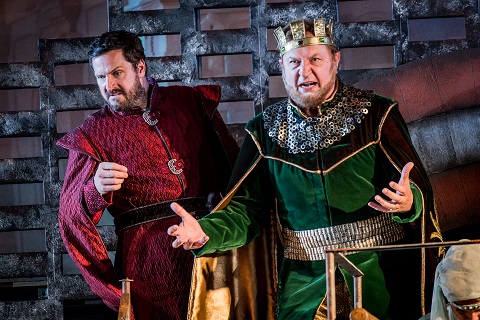 Photo credit:George von Bergen (Cornelius) and (Mikhail Svetlov) as King Raimondo Robert Workman.
Photo credit:George von Bergen (Cornelius) and (Mikhail Svetlov) as King Raimondo Robert Workman.
The minor characters do not really have sufficiently interesting dramatic or musical involvement to make them anything more than two-dimensional, but all of the cast worked hard to create impact and presence. I felt that Lloyd-Evans didn’t make enough of the King’s Councillor Cornelius’ Machiavellian dastardliness, but George von Bergen brought some vocal darkness to the role. Mikhail Svetlov, who impressed as Il Cieco in Iris, rather lacked grading and shading as King Raimondo but was appropriately stentorian as the cruel patriarch.
Fiona Kimm was terrific as Giglietta, her plump, rich tone and urgent projection conveying real love for her grandson and heart-warming courage in pleading for his life. Isabeau’s maids were performed by Nadine Benjamin (Ermyntrude) and Joanne Marie Skillett (Ermyngarde), and their voices blended beautifully with the harp as they showed consoling love for their humiliated mistress in Act 3. The stage was busily populated with extras such as six heralding on-stage trumpeters (who rather overpowered the ‘real’ herald - Thomas Humphreys’ L’araldo maggiore) and the aforementioned three angels who by the close seemed to have become a trio of Grim Reapers.
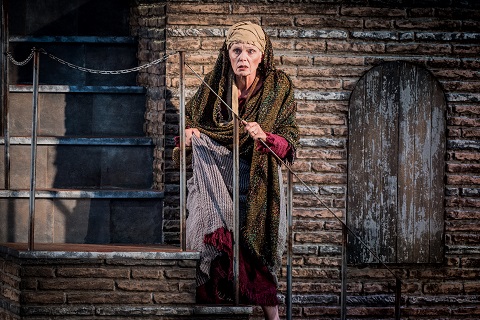 Fiona Kimm as Giglietta. Photo credit: Robert Workman.
Fiona Kimm as Giglietta. Photo credit: Robert Workman.
Conductor Francesco Cilluffo relished every rhythmic and harmonic intricacy and surprise, and summoned passionate playing from the City of London Sinfonia, showing the same sort of authority that enabled him to guide Wexford Festival Opera’s 2015 Guglielmo Ratcliff with such accomplishment and drive. The Intermezzo, a ‘Hymn to the Sun’, before the fateful ride gleamed with ardour.
When Isabeau was premiered, under Mascagni’s baton and with Maria Farneti and Antonio Saludas in the leading roles, in June 1911 at the Teatro Coliseo in Buenos Aires, each Act received an ovation, and after productions (again with the composer at the helm) at La Scala and La Fenice the following year the opera remained in the repertoire, in Italy at least, as a star vehicle for tenors such as Bernardo De Muro and Giulio Crimi, with Maria Farneti, Gilda Dalla Rizza and Rosetta Pampanini, among others achieving success in the title role. It subsequently slipped under the radar, and we owe Investec Opera Holland Park gratitude and admiration for having given us a chance to experience an opera which may be dramaturgically unsatisfying, but which has plenty of vocal charisma and dramatic panache to compensate.
William Ashbrook may have, along with others who have viewed the opera as second-rate verismo cliché, condemned the opera as ‘trite bombast’, but on this occasion there was plenty of musical finesse and mesmeric fire.
Performances of Isabeau continue on 18, 20, 26 and 28 July.
Claire Seymour
Mascagni: Isabeau (UK premiere)
Isabeau - Anne Sophie Dupreis, Folco - David Butt Philip, King Raimondo - Mikhail Svetlov, Cornelius - George von Bergen, Ermyntrude - Nadine Benjamin, Ermyngarde - Joanne Marie Skillett, Giglietta - Fiona Kimm, Il cavalier Faidit - Oliver Brignall, L’araldo maggiore - Thomas Humphreys; Director - Matrtin Lloyd-Evans, Conductor - Francesco Cillufo, Designer -takis, Lighting Designer - Robbie Butler, City of London Sinfonia, Chorus of Opera Holland Park.
Investec Opera Holland Park, London; Saturday 14th July 2018.
image=http://www.operatoday.com/Title%20image%20for%20Isabeau.jpg image_description=Isabeau at Investec Opera Holland Park product=yes product_title=Isabeau at Investec Opera Holland Park product_by=A review by Claire Seymour product_id=Above: Isabeau, with Anne Sophie Duprels in the title role (centre)Photo credit: Robert Workman
The 2018 BBC Proms opens in flamboyant fashion
But, this year’s Proms will also mark two political events of 100 years ago: the end of the First World War and the 1918 Parliamentary Act which granted suffrage to women over the age of 30. And, both season-strands were present at this First Night performance given by the BBC Symphony Orchestra under their Chief Conductor, Sakari Oramo, with works composed at the start of the century by English composers placed alongsideFive Telegrams - a new work by Anna Meredith in collaboration with 59 Productions which was jointly commissioned by the BBC Proms, 14-18 NOW and Edinburgh International Festival.
The ‘elegiac’ side of things was confined to the first half of the concert. Vaughan Williams’s Toward the Unknown Region, a setting of text from Walt Whitman’s Leaves of Grass, was first performed in 1918, though not heard at the Proms until after the Second World War. Presumably the composer was drawn repeatedly to Whitman’s poetry - in the Sea Symphony and Dona nobis pacem, for example - because of the American poet’s blend of pseudo-religious mysticism and humanistic values. The opening lines were sensitively sustained by the BBC Symphony Chorus, every word carefully declaimed. Oramo kept things moving along and build with grandeur but avoiding triumphalism towards the massive hymn-like climax, encouraging a blossoming swell of sound from his singers. It was resolute but not too nobilmente, the emphasis on song and spirit in the final floating cry: ‘Equip them at last, them to fulfil, O soul!’
Oramo strove for similarly restrained sentiment in Holst’s The Planets, though he allowed his two timpanists to propel ‘Mars’ from dark beginnings to a thunderous tumult, their menacing rhythm pounded with unrelenting insistence, as trombones and horns snarled, and the woodwind sneered. The horn solo at the start of ‘Venus’ sounded a little tentative, but there was much delicacy and sweetness in this movement, not least some lovely string playing enhanced by gentle solos from leader Stephen Bryant. ‘Mercury’ was fleet but sharply defined, a whirl of colour and nuance.
I’d have liked the syncopated motif which introduces Jupiter’s ‘jollity’ to have had a bit more bite and tension, but again Oramo had a good eye for the long-range target, steering fluently through the triple-time accelerando and then easing up, but not too much, for the ‘big theme’. The lack of sentimentalism didn’t stop from one of the audience members seated just behind me from joining, rather untunefully, however; and another small gripe was the applause which punctuated the first few movements. But, the final movements proceeded segue and the compelling momentum which Oramo had formed carried us convincingly onwards, culminating with Neptune’s mystical cry from other unknown regions, as the female voices of the National Youth Choir receded into silence.
The performance had been ‘complemented’ by pulsating colours and lights along the frieze behind the orchestra and the illumination of the Hall’s heights in hot red and cool emerald - a sort of cosmic light-show which anticipated the Son et lumière which was to come.
The concert had commenced at the rather unusual, and not particularly convenient, time of 8.15pm, and after a disproportionately long first half it was 10pm before we had the opportunity to hear the first of this year’s Proms commissions, Anna Meredith/59 Productions’ Five Telegrams. Meredith is one of twenty-two women composers championed by the Proms this summer, with Roxanna Panufnik receiving a commission for the Last Night and eight other women contributing world premieres to the Proms Chamber Music series.
Each of the five movements of this twenty-five-minute work explores one of the forms of communication employed on the Front Lines, and between the war-front and those back home, and is accompanied by a ‘light-show’ which projects a flamboyant and flashy array of colours, patterns and motifs around the auditorium. Meredith has employed big forces, the BBC Symphony Orchestra being complemented by the BBC Proms Youth Ensemble - its 10 trombones, four euphoniums, six trumpets and battery of percussion ranged along the bottom of the choir stalls - and the National Youth Choir of Great Britain. And, the work’s statements are bravura. Meredith has explained, ‘We were clear that we didn’t want to create a sepia-toned, lone-bugled kind of piece. No poppy petals gently falling.’
What we have instead is a firework display of illumination and colour, and there’s no denying it was impressive, but often the mood created felt rather too celebratory and frivolous. I’m sure many found the blend of sound and music interesting or stimulating, perhaps even inspiring, but for this listener the incessant abstract swirling and sputtering, floating and flashing was something of a distraction. At times there seemed to be recognisable visual motifs: flames, water, telegraph wires, search-lights perhaps. But too often music and image seemed unconnected.
Meredith’s genre-bending part-pop, part-minimalist idiom was well-suited to the mechanistic quality of the visuals, particularly in ‘Codes’ where patterns and abstractions flickered and flew around the walls of the RAH to the accompaniment of brutal percussive stamping. In ‘Spin’, too, Meredith conjured an impressive weight from the brass, but she showed she could use her forces selectively, as the concluding ‘Armistice’ hesitantly communicated the confusion and uncertainty which sits alongside cessation of conflict. The singers whispered fragments - “I am quite well” - from the Field Postcards that the soldiers were permitted to send home, but which were heavily censored.
There were pyrotechnics of an aural kind at the start of the concert, in the form of a commemoration and celebration of the life and work of Oliver Knussen who sadly died last week. Scheduled too late for inclusion in the programme booklet, the opening bars of Knusssen’s Fireworks with Flourish may left those listeners anticipating Vaughan Williams a little bemused initially, but their ears were soon pricked by Knussen’s characteristically colourful palette and combination of intricate restlessness and painterly refinement. The storm clouds may have broken that evening over the streets of South Kensington, but inside the Royal Albert Hall the 2018 BBC Proms season kicked off with a sparkling fanfare in all senses of the word.
This concert was broadcast live on BBC2 and Radio 3 and can be accessed via BBC iPlayer .
Claire Seymour
PROM 1: Knussen - Flourish with Fireworks, Vaughan Williams - Towards the Unknown Region, Holst -The Planets, Anna Meredith/59 Productions - Five Telegrams.
Sakari Oramo (conductor), BBC Symphony Orchestra National Youth Choir of Great Britain (Ben Parry, chorus master), BBC Symphony Chorus (Neil Ferris, chorus master), BBC Proms Youth Ensemble; Royal Albert Hall, Friday 13 th July 2018.
image=http://www.operatoday.com/BBC%20Proms_CR_Justin%20Sutcliffe%20%287%29%20%281%29.jpg image_description=BBC Proms 2018, First Night, BBC Symphony Orchestra under Sakari Oramo product=yes product_title=BBC Proms 2018, First Night, BBC Symphony Orchestra under Sakari Oramo product_by=A review by Claire Seymour product_id=Above: Five TelegramsPhoto credit: Justin Sutcliffe
July 13, 2018
Banff’s Hell of an Orphée+
There is truth in advertising.
The creators have used Gluck’s Orphée et Eurydice (Berlioz version, 1859) as their inspiration for Orphée+, the “+” signifying every contemporary innovation they melded with the original.
This is somewhat a strange turn about for Baroque opera, which in recent decades has sought to be ever more doggedly faithful to the original performances practices, including period instruments. This production did it’s damnedest to entertainingly turn that on its head. Banff’s inventive aural interpretation was notable for two bold choices.
First, an electric guitar not only provided an atmospheric, hip accompaniment for the recitatives, but also screamed out some pretty anguished counter melodies that warbled, twanged and shredded to ably underscore the title hero’s grief and pathos. Shades of Superstar! The imaginative, stylish guitarist was the dynamic Kristian Podlacha.
The other notable musical “updating” was the incorporation of a virtual chorus that blended with a live choral quartet to bring an eerie connectivity, a social media sensibility to the unfolding tragedy. Video clips of countless choristers were somehow sync’d and projected on the white scenic surface to form an unsettling collage of keening commentators that were anonymous, interchangeable, connected by a media op, yet unconnected on any deeply meaningful level. Quite a subtext there for and about today’s audience.
Once you accepted the au courant addition to the sound, you couldn’t help but admire the wholly idiomatic conducting from Topher Mokrzewski. Maestro Mokrzewski doesn’t so much conduct the score as inhabit it, eliciting luminous passion and rhythmic precision from his talented instrumentalists. He forged a highly satisfying partnership with his soloists that was pliable and unified in purpose. And he managed to keep the virtual and live singers in perfect order, thanks to a click track and an unerring baton.
It was unusual for a classical conductor to have to somewhat abdicate issues of balance to a sound designer, but John Gzowski did fine work overall. The slight over-balancing of the guitar in some low-lying vocal phrases during the first half were completely remedied after intermission.
The cast could hardly have been bettered. As Orphée, countertenor Siman Chung sizzled with firepower, star power, and every other kind of power. Mr. Chung has a haunting color to his meaty tone, with a thrilling brilliance to his upper range. While he lavished the famous laments with limpid, affecting tone, he also deployed his well-schooled instrument to fine effect as he ripped through spot-on passages of manic coloratura.
Miriam Khalil complemented her co-star with a radiant, empathetic rendition of Eurydice. Ms. Kahlil’s poised, warmly gleaming soprano was not only dispatched with honeyed tone, but also grew in finely spun spinto presence as the heroine became more despairing and fearful. From a tremulous, loving reunion to urgently pleading for her lover to look upon her, her performance was expertly rendered.
Soprano Etta Fung performed the miraculous feat of not only singing Amour with charm and verve, but also by simultaneously clutching, twisting and cavorting around and about two billowing cloths in a display of aerial artistry. Ms. Fung was roundly and rightly cheered for such a daring flight of fancy, but truth to tell she sang even better in her second appearance. When finally earthbound, the diminutive singer found even more crystalline focus in her agile technique.
Nor was this high-flying moment the only nod to Cirque du Soleil. The brooding set design, deployment of projections, and riotously colorful lighting palette all contributed mightily to a high tech, in your face, immersive experience that is not just over the top, but over the rainbow to a fantastical Oz of a milieu.
Zane Pihlström has created a mash-up of an ingenious costume design that is part Steampunk, part Moulin Rouge, part Victoria’s Secret, and all points in between. With quick-paced abandon we go from frock coats to Mardi Gras masks to jockstraps and thongs, to a high-heeled chorus (men, too) as the dancers impersonate commentators, demons and hedonistic revelers.
S. Katy Tucker’s all white set design is most notable for providing a receptive surface for S. Katy Tucker’s innovative projection design. The basic structure consisted of two receding sidewalls, dotted with cubes of varying sizes. That uneven surface coupled with some cutout windows, allowed for countless opportunities to vary the break-up and shadows cast by down- and side-lighting.
There was a pile of cubes down left, a sort of makeshift memorial littered with flickering white pillar candles. And there was a layered grouping of “trees” filling the playing space, suggested by hanging flared strips of cloth. There was nonstop deployment of finely isolated projection effects of the “how-did-they-do-that?” variety. How did they get those stacked up singing heads on those “trees”? How did they manage a hide and seek appearance of a floating Eurydice on them? These were jaw-dropping feats of stagecraft.
Then there were just the “garden variety” rear projections with suitably troubling imagery like an enlarged, watchful, green Buñuel eyeball; a crazily possessed image of demented Eurydice maniacally nodding by snapping her head sharply forward and back; or a fiery lightshow to rival the fury of Hawaii’s current inexorable lava flow. JAX Messenger is credited with the lighting design that flawlessly interfaced with the imagery and moving parts. When the “trees” were suddenly “uprooted,” twisted and affixed to opposite walls the illumination could make them appear to be thunderclouds, a leafy arbor, or a disco ceiling with equal skill.
Director Joel Ivany’s fertile imagination is everywhere evident in knitting together all the diverse elements that brought this fresh concept to focused fruition. Although the piece is played with dramatic truth and the highest musical values, Mr. Ivany has framed them in a visually paced panoramic delight that is born of today’s sensibilities.
It is sometimes hard to know when Joel’s direction leaves off and Austin McCormick’s ingeniously original choreography begins. Mr. McCormick has his prodigiously talented group of six dancers in almost constant, fluid motion. As they provide background commentary on the emotional journey, the corps intertwines, writhes, reclines, rolls, scatters, forms a group, uncouples, and couples again, sometimes in gender bending ways.
Just when you think the movement may be too frenetic, director Ivany judiciously parts the waves to focus on a soloist; settles the visuals into a steady image; or clears the stage entirely to allow for a moment of poignant isolation. On the strength of this totally absorbing “electronic baroque burlesque descent into hell” I feel that both the honored past and promising future of opera were equally well served.
Make that “Well-served+.”
James Sohre
Orphée+
Inspired by Gluck’s Orphée et Eurydice
(Berlioz version, 1859)
Orphée: Siman Chung; Eurydice: Miriam Khalil; Amour: Etta Fung; Dancers: Erin Dillon, Jacob Karr, Michele Lee, Eric Lehn, Michael McArthur, Lauren Muraski; Chorus: Nicole Joanne, Jamie Groote, José González Caro, Daevyd Pepper; Conductor: Topher Mokrzewski; Director: Joel Ivany; Choreographer: Austin McCormick; Sound Design: John Gzowski; Set and Projection Design: S. Katy Tucker; Lighting Design: JAX Messenger; Costume Design: Zane Pihlström
image=http://www.operatoday.com/Blake%20Manns%20Orphee.jpg
image_description=Orphée+, Against the Grain Theatre, Banff Festival
product=yes
product_title=Orphée+, Against the Grain Theatre, Banff Festival
product_by=A review by James Sohre
product_id=
Photo credit: Blake Manns
July 12, 2018
A Choral Trilogy at the Aix Festival
Seven Stones is an Aix Festival commission to the Czech composer Ondrej Adàmek (b. 1979), the Icelandic poet Sjòn — a pen name meaning “sight” (b. 1962), and the Niçois dancer / metteur en scène Éric Oberdorff (thirty-some) that resulted from a 2012 symposium at the Aix Festival’s Académie imagining a or maybe the future for opera.
And voilà, six years later a futuristic opera indeed. It blew us away by sheer audacity, charmed us by sheer audacity and entertained us by sheer audacity. Seven Stones is, need I say, complicated — a libretto, in English, of unfathomable depth based on stones and stoning and the magical number seven passing through nonlinear time from middle Europe through Argentina to Paris and Jerusalem passing by the moon to return finally to middle Europe for a murder then an admonition.
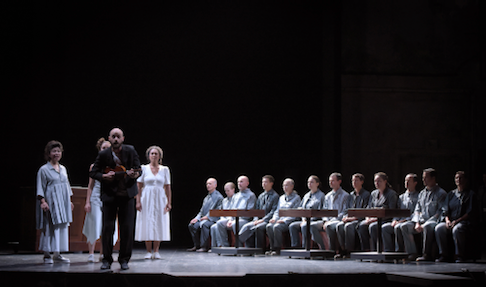 Principals and chorus of Seven Stones
Principals and chorus of Seven Stones
There was no orchestra and no scenery but there were four singers who rarely, very rarely, and only incidentally sang and there was a four part (satb) chorus, Paris’ accentus / axe 21, that in fact never sang a note. These twelve singers associated with Paris’ elite Ensemble Intercontemporain spoke rhythmic text configured as magnificent, complex syllabic, toneless madrigals. These choruses were the major part of the evening’s one hour twenty minute duration.
During his twelve year reign departing Aix Festival general director Bernard Foccroulle (Foc-crewl- lih — did I get that right?) tenaciously and fruitfully explored opera’s most basic tenet — collaboration. Seven Stones well serves as his crowning achievement!
Seven Stones is a musico-dramatic mechanism. the score is not only auditory notation, in effect it also seems to be notated movement that is the staging of its 13 scenes. The singers magnify the colors of their sound world by hitting, rubbing or pounding on abstract constructions, some huge, that serve the story and music and as well as create the spectacle. There were a few instrumentalists (violin, cello, exotic zithers, an electric organ to create quotations of western and eastern music), whose on stage instruments were picked up from time to time by principals and chorus to be used as rhythmic noise sources.
There is of course the central figure of the poem. The stone collector (mineralogist) spoke and stuttered throughout the evening, abetted by three female voices who assumed various guises to confound the stone collector in complex clucks, pops and runs of language, sumptuously notated and executed. Needless to say these performances were as astonishing as the madrigals executed by accentus / axe 21.
Perhaps three, maybe four of the stones might have sufficed. The novelty wore thin.
Dido and Aeneas is Henry Purcell’s 1688 famous operatic tragedy, famed not only for the wrenching suicide of its heroine Dido, but also by the hopelessly bleak lament of the citizens of Carthage in their closing madrigal. Though of monumentally tragic proportion the 50 minute or so duration of Purcell’s opera usually condemns it to share the stage with another short opera, diluting the tragic spell it creates.
The Aix Festival extended the opera’s length, making it a one opera evening however brief (one hour twenty minutes) by adding a prologue to replace the original, long lost Purcell composed prologue. The Festival commissioned French novelist Maylis de Kerangal (b. 1967 in Toulon — her most recent (2016) English translated novel is The Heart: a novel [Réparer les vivants]). Mme. de Kerangal’s Dido and Aeneas prologue imagines Dido arriving in Africa on a ship together with 80 kidnapped girls, prey to Dido’s army of men who will father their children in Carthage.
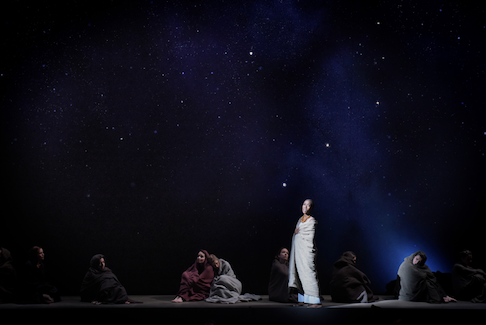 Actress Rokia Trore with a few of the 80 silent abducted Cyprian girls
Actress Rokia Trore with a few of the 80 silent abducted Cyprian girls
Mali born, internationally decorated actress Rokia Trore, founder of the Passerelle Foundation [for the arts] in Bamako, Mali’s capital, delivered the monologue. Slowly traversing the stage left to right she delivered her first-hand, immediate account of the fictional abduction of the girls, the abuses they suffered during their voyage to and the miseries of their lives in Africa. It was spoken in splendrous French, the official language of Mali.
The prologue did indeed offer an oblique perspective on the founding of Carthage back in 146 BC. Carthage, the city (in today’s Tunisia) was destroyed soon after it was founded. This new prologue well serves as a curse upon Dido's city, and more immediately upon her impending marriage to Aeneas.
Said to be a production of the Aix Festival’s Académie, the principal roles of the Purcell tragedy seemed to be taken by apprentice artists, perhaps in appreciation that Dido and Aeneas was written to be performed by students at Mr. Priest’s boarding school for girls back in 1689. In Aix the promising voices of these young participants exemplified the early stages of mastery of their craft. Note that after the first performance (which I attended) the Dido was replaced by a career singer.
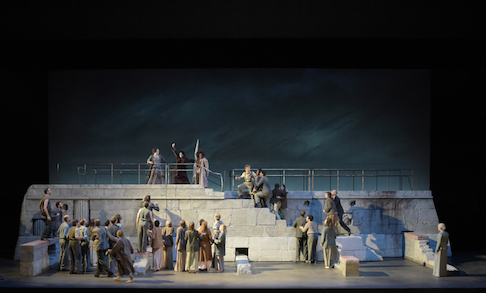 Three of the principals with the chorus of the Pygmalion Ensemble
Three of the principals with the chorus of the Pygmalion Ensemble
The evening did however attain some tragic grandeur in the voice of the Carthaginians, the 30 singers of the chorus of the Ensemble Pygmalion, and in the rich realization of Purcell’s scanty original score (string quartet plus harpsichord). Of the well endowed instrumentation of Ensemble Pygmalion’s twenty-seven orchestra players, many doubling on additional instruments, the continuo generously consisted of two keyboards, three plucked instruments and three strings.
The Ensemble Pygmalion is resident at the Opéra de Bordeaux, and associated with Paris’ Opéra Comique. It is one of the cultural glories of France. For these performances in Aix the Ensemble Pygmalion was lovingly conducted by well-known Czech early music conductor Václav Lucs, may we assume it was his edition.
The final chorus “With drooping wings” found its wanted sublimity and the audience roared its appreciation.
Orfeo & Majnun is a co-production with Brussel’s Monnaie and Rotterdam’s Stichting operas, a festival in Kraków (Poland), plus entities in Malta and Vienna, and a town in Portugal — an unlikely conglomeration indeed. It is intended as a public event/celebration (no admission charge) having premiered a couple of weeks ago in Brussels.
The opera, really musical theater, was the super-imposition of the Orpheus story and the Persian tale of Majnun and Layla. The common ground of the two stories are laments — Orpheus addresses Charon, the guardian of Hell’s entrance, and Majnun addresses the natural world (animals). But both Eurydice and Layla die anyway. While Majnun falls dead on Layla’s tomb, Orpheus becomes the voice of classical poetic love.
In Aix the single performance occurred in the Cour Mirabeau, the city’s famed grand avenue, of which it took over about half the length. Thousands of chairs were set up, enormous video screens were set up to pass the visual images along the route, and there was the attendant sound amplification (slightly out of sync with the visual images). One can only imagine the security that was in place.
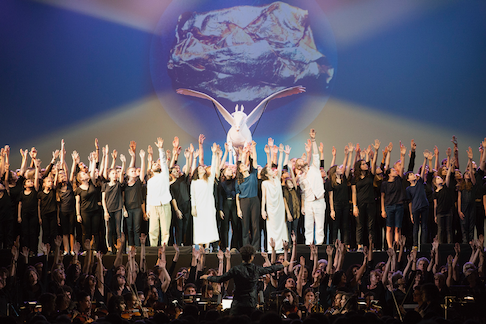 The final moment of the opera, lovers in white, narrator in blue
The final moment of the opera, lovers in white, narrator in blue
Like all productions of the Aix Festival this one too was beautifully and thoroughly produced, thus certainly our security was state of the art — only later did I understand that we had been sitting ducks.
The intent of the project was to illustrate a commonness of European and Middle-Eastern cultures. Certainly this was somewhat achieved even though the philosophic underpinnings of the two tales are strikingly different. However the juxtaposition of musical languages made it glaringly evident that there is irreconcilable difference of sensibility between the rich structures of Western music and the sharp melismatic lines of Eastern music.
The opera boasts three composers, the Palestinian Moneim Adwan who one assumes created the extended Arabic based episodes, the British composer and organist Howard Moody, and the Dutch composer Dick van der Harst. We had no idea who did what, except we assume that one or the other of the European composers will have accommodated the classical Arabic sounds to the basically musical theater sound of the evening.
Of the four fine singers only French baritone Yoann Dubruque as Orfeo stood out. Singing in English (Eurydice and the Narrator both used French, the Persians sang in Arabic) he alone found the direct and easy charm of musical theater.
Western music has traditionally used chorus to express a universality of sentiment. Thus in such an undertaking as this ode to multiculturalism a massive chorus would make its message exponentially more forceful. What seemed to be hundreds of amateur singers offered their voices to the many, not easy choruses that the composers included. These wonderful musicians succeeded with aplomb, singing without score in semi-staged movements.
It was a long one and one half hours.
Michael Milenski
Cast and production information:
Seven Stones Maid / Storyteller: Anne-Emmanuelle Davy; Land Lady / Storyteller: Shigeko Hata; Stone Collector: Nicolas Simeha; Stone Collector's Wife: Landy Andriamboavonjy; Chorus: accentus / axe 21. Conductor: Ondřej Adámek; Additional conductor: Léo Warynski; Mise en scème and choreographer: Éric Oberdorff: Scénographie et lumière: Éric Soyer; Costumes: Clémence Pernoud. Théâre du Jeu de Paume, Aix-en-Provence, July 8, 2018.
Dido and Aeneas Dido: Anaïk Morel; Femme de Chypre: Rokia Traoré; Æneas: Tobias Greenhalgh; Belinda: Sophia Burgos; Sorceress / Spirit: Lucile Richardot; Second Woman: Rachel Redmond; First Witch: Fleur Barron; Second Witch: Majdouline Zerari; Sailor: Peter Kirk. Chœur et orchestre: Ensemble Pygmalion. Conductor: Václav Luks; Mise en scène: Vincent Huguet; Décors: Aurélie Maestre; Costumes: Caroline de Vivaise; Lumière: Bertrand Couderc. Théâtre de L/Archevêché, Aix-en-Provence, July 7, 2018.
Orfeo & Majnun Majnun: Loay Srouji; Layla: Nai Tamish Barghouti; Orfeo: Yoann Dubruque; Eurydice: Judith Fa; Narratrice; Sachli Gholamalizad. Orchestre: Ensemble interculturel de l'Orchestre des Jeunes de la Méditerranée; Chef de chœur: Philippe Franceschi avec la participation d’amateurs choeurs; Sinfonietta: Session de l'Orchestre des Jeunes de la Méditerranée. Direction musicale: Bassem Akiki; Mise en scène: Airan Berg and Martina Winkel; Créatures animalières: Roger Titley; Costumes, dramaturgie: Martina Winkel; Lumière: Luc Schaltin; Vidéo: Daan Milius and Martina Winkel; Chorégraphie: Marta Coronado. Cour Mirabeau, Aix-en-Provence, July 8, 2018.
image=http://www.operatoday.com/AixTrilogy_Aix1.png
product=yes
product_title=A Choral Trilogy at the Aix Festival
product_by=A review by Michael Milenski
product_id=Above: Nicolas Simeha as the stone collector [Seven Stones and Dido and Aeneas photos copyright Vincent Pontet, Orfeo & Majnun photo copyright Vincent Beaume, all photos courtesy of the Aix Festival]
July 11, 2018
Vintage Audi — Parsifal, Kaufmann, Pape
Audi, veteran of decades on the cutting edge of music theatre, knows what he's doing, even if what he does isn't flashy. So darkness and desolation greeted us on the stage. The Grail community is in trouble, desiccated like the skeleton in the corner beneath which Kundry shelters, a wild, lonely outcast. Audi's focus on the main characters focuses attention on what they are singing about. Just as in Greek tragedy, there's little need for fancy decoration. In an opera like Parsifal austerity is no bad thing, abstraction will suffice. This also means more room for the music itself which is hardly a minor distraction. In many ways it is the whole point of the drama, greater than the stars or scenery. Without the music there'd be no opera !
René Pape is cloaked in black, Amfortas (Christian Gehaher) in white, with Kundry (Nina Stemme) in black/red moiré. Lest we get caught up, too soon in simplicity, Pape and Stemme remove their "armour". (Lucky for them in this blistering heat) So when the "Innocent Fool" Parsifal arrives (Jonas Kaufmann), he's wearing a bizarre breastplate. Minor detail but don't dismiss it yet. The Grail Knights are in heavy armour. But for what purpose ? In their fortress they have no enemies to fight but themselves. The orchestra wells up, magnificently, Parsifal bells booming. Of course Parsifal is impressed. But the children's choir sing of sacrifice. What is this blood ritual that's re-enacted without question ? Amfortas is suffering but the knights look on, but then remove their cloaks to reveal body suits. Of course they're not "beautiful". It's easy to judge a production by shocking images but what really matters is to figure out why. Under their armour, they are human, capable of compassion. Though ugly, they are redeemable. Compassion is a greater gift than conventional beauty. As Parsifal wanders off, deep in thought, we should be thinking, too.
The realm of Klingsor (Wolfgang Koch) is depicted through images of dead bodies, hanging upside down. Again, simple but effective. The Flower Maidens are seen in fat suits Like the dead men, they are Klingsor's victims, creatures of his sick mind, created to trap and deceive. If we judge them on surface appearances we are buying into his game, treating women as objects to be consumed by men. Besides, listen to their voices - seriously good casting here - Tara Erraught among them. There is a lot of misogyny in Parsifal, such as the Knight's mistreatment of Kundry, which needs to be addressed because abuse is the opposite of compassion. Part of the reason the Grail community is in trouble is its dismissal of women and the principles they represent. Kundry, after all, "never lies" as Gurnemanz tells us right out, though the Knights malign her. Though she's controlled by Klingsor, she's the vehicle through which Parsifal connects to his mother and awakens his conscience. In this act, Stemme (as Kundry) looks lovely in evening gown and blonde wig, but her lines are forcefully delivered. She's too real to do mock-temptress. And so the walls of Klingsor's kingdom are rent apart, his victory denied. Kundry reveals how she was cursed : I liked the personality in Stemme's performance. And thus Parsifal's self-discovery, Kaufmann's voice swelling with magnificent resolution.
"Hier bist du an geweihtem Ort:da zieht man nicht mit Waffen her, geschloss'nen Helmes, Schild und Speer.". Mark those words from Gurnemanz. They explain a lot. Parsifal creeps back to the Grail Community garbed in strange armour but disrobes, handing the spear - a neat, elegant cross, not a weapon. Instead of violence, bigotry and obsession with outward appearance, redemption comes through kindness. The steel in Kaufmann's voice gleams, evoking the inner strength Parsifal has learned from years of wandering and searching. Pape and Kaufmann can do no wrong in this performance, they pretty much steal the show. As Parsifal baptises Kundry, the stage lights up : utter simplicity and purity, "Wie dünkt mich doch die Aue heut so schön!". The textures in the orchestra open out, with clarity and ineffable sweetness. Kaufmann's timbre became infused with tenderness. .
Meanwhile the Knights are back in their formal black armour intoning their ritual dirge. Like Amfortas, they're still acting out guilt, blood sacrifice and immutable agony. Christian Gerhaher sings a good enough Amfortas though somewhat one-dimensional. Amfortas carries baggage, he's ridden with conflicts and should ideally be characterised with more engagement. This is a pity since Audi's clear, unfussy staging puts so much emphasis on the part.
Mission accomplished, Kaufmann stands with the chorus, one among equals and prays - not with this hands together but over his eyes. Durch Mitglied wissend, empathy, kindness. Don't judge people by surface appearances but by what they might be inside. And above all, the need to rise above self for higher purposes. An excellent ending : the focus shifting from the mortals on stage to an abstract depiction of light, more spiritual than specific. This reflects Wagner's stage direction "Lichtstrahl: hellstes Erglühen des Grales". So we don't see a literal dove flying around, but the meaning is clear. The orchestra has the last word, so to speak : we are in the presence of the sublime.
Anne Ozorio
image=http://www.operatoday.com/pierre-audi-futur-nouveau-patron-du-festival-international-d-art-lyrique-d-aix-en-provence%2CM350694.jpg
image_description=Pierre Audi
product=yes
product_title=Richard Wagner : Parsifal. René Pape, Nina Stemme, Jonas Kaufmann, Christian Gerhaher, Wolfgang Koch,conductor Kirill Petrenko. Bayerische Staatsoper, Munich (livestream) 8th July 2018
product_by=A review by Anne Ozorio
product_id=Above: Pierre Audi
July 10, 2018
Flight Soars High in Des Moines
The story in brief involves a Refugee who is living at a major airport, unable to leave, and his interaction with the travelers/employees who are taking a flight, or who are “in flight” from obligations, relationships, or duties.
I am not sure what other opera companies are doing for world class singers at the moment, since they seem to all have been assembled in Indianola, Iowa to people this exquisitely realized performance.
Mr. Dove has set April DeAngelis’ epigrammatic libretto to a diverse, evocative score, often haunting and melancholy, frequently ironic and funny, sometimes profoundly moving, always exceedingly vibrant in theatrical and musical invention. Dove is a master orchestrator and his vocal writing, whether angular, melismatic, conversational, or lyrical, is supported by richly diversified orchestral effects.
Music Director David Neely exerted consummate control over his amassed forces, conducting a reading of sweeping power and jaw-dropping precision. DMMO’s fine orchestra has had a banner year, and they distinguished themselves yet again with a crackling reading of Dove’s richly layered, rhythmically propulsive opus. Maestro Neely inspired nuanced playing from each and every instrumentalist, whether in solo or ensemble passages, and melded them fortuitously with the singers, creating a musico-dramatic work of sensational impact.
The vocal work was uniformly exceptional, revealing each soloist at the top of their game. Composer Dove gave the signature, extended emotional “moments” to the Refugee and the Minsk Woman. John Holiday brought his distinctive counter-tenor to the Refugee and he proved a charismatic, galvanizing presence. His is a uniquely appealing, star quality instrument, and his ingratiating persona makes him a fan magnet. Mr. Holiday’s penultimate aria, which finally reveals the secret of his situation, was ineffably moving.
The superlative mezzo Elise Quagliata was an enigmatic and powerful Minskwoman, i.e. a passenger supposed to be bound for Minsk. Ms. Quagliata’s character is in the late stages of pregnancy, and her hormonal swings are the cause for lyric outbursts, recriminations, and finally resignation. In her major scena, Elise poured out beautifully judged fiery, arching phrases that captured the heart and ravished the ear. Her richly-colored mezzo was always powerful and persuasive.
Audrey Luna was a commanding presence as the Controller, who oversees and reports events. Ms. Luna has a crystal clear, pliant soprano that has to be among the purist and most finely spun in the business. From the stratospheric top notes to a gleaming middle voice to a secure bottom range, this prodigiously gifted singer imbued every phrase with ravishing vocalizing. Her fine sense of legato caressed the numerous melismatic passages in the role, but when it came time for spitfire commentary, she hurled out bolts of sound penetrating well into the wild blue yonder.
As the perpetually horny Stewardess and Steward, Sofia Selowsky and Theo Hoffman were vocally lustrous and theatrically unrestrained. Ms. Selowsky sports a wonderfully ripe mezzo, warm throughout, gleaming on top. Mr. Hoffman’s appealing, diminutive frame houses a polished, booming baritone that seems about three sizes bigger than he is. Together, they complemented each other musically and dramatically, as they provocatively worked their way through the Kama Sutra, unselfconsciously simulating all manner of randy sexual abandon.
Tenor Andrew Bidlack (Bill) and soprano Zulimar López-Hernández (Tina) were the young hipster couple escaping on vacation together in an attempt to rejuvenate their waning romance. Mr. Bidlack has an effortlessly produced, honeyed lyric tenor who brings Rossinian grace and fluidity to his rangy vocal lines. His rolled eyes and put-upon shrugs as his wife keeps picking at him were boyishly engaging. His character eventually gets pushed away to experiment quite willingly with a different kind of human connection.
Ms. López-Hernández creates a delectably fussy princess as the controlling spouse, all the while singing with glistening tone that is wedded to an admirably steady technique. Her refulgent upper register was especially sonorous and her unbridled physicality including defiantly showing off a beach body that is worthy of Baywatch.
As the deluded/hopeful Older Woman, Deanne Meek wielded a velvety mezzo that gloved a nice underlying bite in the tone. Ms. Meek created a figure of some pathos as she waits for her 22-year old young lover (who may as well be named Godot) to show up. But she never became an unappealing victim, relishing every one of her comic lines as she feigned speaking French, and injecting some welcome vocal gravity in the mix with her beautifully warm, sustained phrases.
The Minskman was glowingly sung by Norman Garrett. The burnished character of his substantial baritone and his informed delivery made us wish he had even more stage time. Ditto the always impressive bass Zachary James as the Immigration Officer. We have to wait until Act Three for him to sing, but when he rolls forth with his darkly colored, pulsating musical lines, we find it was well worth the wait.
Director Kristine McIntyre has inspired this miracle of an ensemble cast to the highest possible level of achievement. The personal journey of each character has its own arc and together the team has not only defined the individual’s quests, but also has woven them together so that in the end, they are all surprised as they embrace their interdependence.
Two ladies sitting next to me were somewhat perplexed by what the story means, why there was no conventional plot, etc. And therein lies one beauty of Flight. It allows us to speculate. It gives us vignettes and lets us struggle to resolve them. It challenges us to face dynamics in our lives, relationships, situations, where we ourselves were tempted to flee. It tells us that life is not always linear, but sometimes parenthetical. And it makes us reflect upon how well we treat not only “others,” but the “Other.” And Team Flight accomplished this with humor, tireless physical movement, utter belief in the material, limitless application of talent, and profound compassion for the frailty of their (and our) characters.
Back to the unerring staging from Ms. McIntyre, she used every possible inch of the playing space with variety and abandon. And what a playing space it is! None of us has likely ever spent time in an airport lounge this coolly beautiful. R. Keith Brumley’s set is a marvel of circular concepts. A low railing, like a classy circus ring defines and contains the fore stage. Upstage of the proscenium, a winding staircase leads up to the control room, a high tech crow’s nest from which the Controller can pontificate. A glass door leads outside to a balcony.
Stage right has a forbidding security door, while stage left features a wall of windows behind which is parked a jet plane that can be pushed back and disappear. The ever-handy downstage trap is filled with a spiral staircase down to a secretive “level two.” The stairs can retract and the gap closes to form additional playing space. When the flooring parts once more and a unit rises from the depths to elevate the very tall Immigration Officer high above the frightened Refugee, the effect suggests the last judgment on steroids.
Mr. Brumley’s pristine terminal also has recessed lighting built into it. Combined with Barry Steele’s richly complex lighting and projection design, this was a wonderland for colorful effects, to include a zany tropical sidebar that morphs into a sort of realization of the mindless crescendo of kitschy extravagance in Bernstein’s Island Magic (Trouble in Tahiti).
Designer Jonathan Knipscher is having a blast providing some of his best costumes ever, really personalizing the characters, and he includes a couple of tricks and jokes that really enliven the proceedings. From the cool elegance of the well-off, pregnant Minskwoman to the third world homeliness of the Refugee to the buttoned down Controller’s uniform to the boisterous flight attendants’ look, the costumes were witty, telling and apt.
Flight was a uniquely satisfying journey with echoes of today’s headlines, musically vibrant and theatrically engaging, passionately presented by a thoroughbred team of interpreters who simply could not have been bettered. Bravi tutti!
James Sohre
Flight
Jonathan Dove, Music
April DeAngelis, Libretto
Refugee: John Holiday; Controller: Audrey Luna; Bill: Andrew Bidlack; Tina: Zulimar López-Hernández; Older Woman: Deanne Meek; Stewardess: Sofia Selowsky; Steward: Theo Hoffman; Minskman: Norman Garrett; Minskwoman: Elise Quagliata; Immigration Officer: Zachary James; Conductor: David Neely; Director: Kristine McIntyre; Set Design: R. Keith Brumley; Costume Design: Jonathan Knipscher; Lighting and Video Design: Barry Steele; Make-up and Hair Design: Brittany Crinson for Elsen Associates
image=http://www.operatoday.com/Flight%20image.jpg
image_description=Die Fledermaus, Des Moines Metro Opera
product=yes
product_title=Die Fledermaus, Des Moines Metro Opera
product_by=A review by James Sohre
product_id=Above: image courtesy of Des Moines Metro Opera
July 9, 2018
Fledermaus Pops the Cork in Iowa
The production team re-imagined the time and setting to the “anything goes” era of The Great Gatsby, and this fresh approach proved to generally be a fine fit. As is customary at DMMO, the production was beautifully cast.
Taylor Stayton, best known as a Rossini specialist extraordinaire, on this occasion was a preening, over-sexed Alfred, bursting out in handsomely sung, over the top Italian opera phrases at the slightest provocation. Mr. Stayton’s gleaming tenor, handsomely boyish demeanor, and shameless pursuit of Rosalinda were a wholly winning entertainment package.
David Pershall’s muscular tenor brought a stolid, suitably smug take to the deceitful party boy Eisenstein. Despite some characterful singing and genial enough philandering, his comeuppance was a satisfying denouement. Troy Cook was a delectably devious, musically resplendent Dr. Falke, his firm-toned baritone ringing out in the house with real panache.
Craig Irvin was a rock solid vocal presence as the warden Frank. The tall, dark, and handsome Mr. Irvin deployed his pliable, well-schooled baritone to fine effect as he played a lively part in the intricate plot to contrive identities and ameliorate indiscretions. Thomas J. Capobianco’s steady, insistent tenor made a fine impression in his brief, but key, appearances as Dr. Blind. Craig Juricka’s engaging baritone was appealing in his featured moments as Ivan. Brian Frutiger, a notable tenor soloist, scored all his laughs as the jailer Frosch, even though he didn’t sing a note. The leading ladies were all stellar.
Susannah Biller was a supremely stylish Rosalinda, her uncommonly fine soprano in full service to a notable role traversal. Ms. Biller has gained just a hint of steel in her attractive instrument and the voice was gorgeously “present” throughout the range. She offered confident, idiomatic singing throughout, but never more so than in her beautifully crafted rendition of the Czardas. Her theatrical abandon also enabled a hedonistic, adventurous take on the character, greatly enhanced by her uninhibited display of arguably the best gams in the business.
Anna Christy is having an unparalleled success as Adele. First, her beaming smile shines so intensely it threatens to contribute to global warming. But second, Ms. Christy is effortlessly singing the spots off the page in a vocal interpretation without peer. If there is a more petite, delectably sassy, vocally adept, theatrically engaging soprano performing this part, please don’t tell me. I don’t think my heart could take it.
In the featured role of Sally, soprano Abigail Paschke proved to be a soupçon of delight in the Act Two’s party scene, first as a bitchy foil for the impostor Olga/Adele. Ms. Paschke not only sings delightfully but boy, can she dance, too! In a daffy goof of a “ballet,” she and four hapless chorus boys entertained the party guests with a spontaneous parody of The Red Shoes, with the clumsy ballerina all shaky legs, splayed ankles, teetering pirouettes, and earthbound tour jetés. Josh Walden was the creative choreographer.
Sarah Larsen is having a ball at the ball as the gender-bending Prince Orlovsky. Ms. Larsen’s well-produced, hearty mezzo easily encompasses the role’s requirements, and her rendition of Orlovsky’s party piece was the highlight of her performance. Her accent (or “ek-sent”) was commendably consistent and suitable, if on occasion just a bit impenetrable. Never you mind, her blasé take on this rich royal reveler was a very satisfying turn.
In the pit, Robert Moody conducts with insouciant affection for the material and the excellent group of musicians responds in kind. Non-continental European orchestras don't have this lilting operetta style built into their DNA, and Maestro Moody has done quite an accomplished feat of instilling the correct Straussian feel and bounce into the proceedings.
R. Keith Brumley has created a riotously colorful set design. The Viennese Eisenstein manse is all busy diamond wallpaper, huge doors, massive staircase, heavy wooden accents, and competing color palates of blue, orange and green. The action in Act One is confined to this “proscenium” portion of the stage. Act Two spills onto the apron, and the prince’s palace is backed by an impressively complicated, floor to ceiling Tiffany inspired wall of luminescent glass art. Act Three’s jail is more down to earth and institutionally realistic, although in a good visual joke, the silly rubber jail cell bars allow Frosch to play them like a harp.
Jonathon Knipscher’s apt costumes not only helped define the characters (and their station in society), but also filled the stage with dazzling color. Having seen the profusion of period flapper party attire in Act Two, I am not sure there are any beaded, sequined dresses left in all of a tri-state area! Mr. Knipscher has outdone his own admirable record with this richly diverse costume design. Barry Steele contributed a straight forward, unfussy lighting design that did everything necessary, and Brittany Crinson was responsible for the wide-ranging make-up and hair design.
Director David Gately managed his resources effectively. The movement of the chorus on and off stage was especially breathtaking in its efficiency, such as having Act Two start with a veritable explosion of choral activity, expertly tutored by Chorus Master Lisa Hasson. In spite of many clever intentions, I found Act One overall to feel more like a tickle of ginger ale on my upper lip than the heady effect of champagne. The latter was reserved for Act Two, when the effervescence of Moët kicked the comic intensity into higher gear.
Perhaps I am a jaded Fledermaus-er, well acquainted (too acquainted?) with this thrice familiar piece, since, in spite of a profusion of talent, I thought that the evening could haven been improved substantially by excising abut 10-15 minutes from the spoken text. With today’s taste for less leisurely Old World pace, I found myself wanting the plot to more often cut to the chase, that being the wondrous Strauss melodies that are the raison d'être for mounting this perennial favorite.
That said, the packed audience laughed, and clapped, and cheered (as did I), proving that if this was your first time at Die Fledermaus or your thirty-first, there is substantial life in the old Bat yet.
James Sohre
Die Fledermaus
Alfred: Taylor Stayton; Adele: Anna Christy; Rosalinde von Eisenstein: Susannah Biller; Gabriel von Eisenstein: David Pershall; Dr. Blind: Thomas J. Capobianco; Dr. Falke: Troy Cook; Frank: Craig Irvin; Sally: Abigail Paschke; Prince Orlovsky: Sarah Larsen; Frosch: Brian Frutiger; Ivan: Craig Juricka; Conductor: Robert Moody; Director: David Gately; Set Design: R. Keith Brumley; Lighting Design: Barry Steele; Costume Design: Jonathan Knipscher; Make-up and Hair Design: Brittany Crinson for Elsen Associates; Choreographer: Josh Walden; Chorus Master: Lisa Hasson
image=http://www.operatoday.com/Des%20Moines%20Fledermaus.jpg
image_description=Die Fledermaus, Des Moines Metro Opera
product=yes
product_title=Die Fledermaus, Des Moines Metro Opera
product_by=A review by James Sohre
product_id=
A spritely summer revival of Falstaff at the ROH
Chronological and geographical side-steps aside, the production is funny, frivolous and thoughtful in equal measure and just what was needed at the end of a long, hot summer week. (For further comment on the design and staging see my 2015 review of the first revival.)
The theatrical and vocal joy was supplied by a terrific cast. While at Garsington a few weeks ago, the women bonded over their suffragette placards and politics, here the ladies-who-lunch exuded a real sense of mischievous camaraderie and feminist nous.
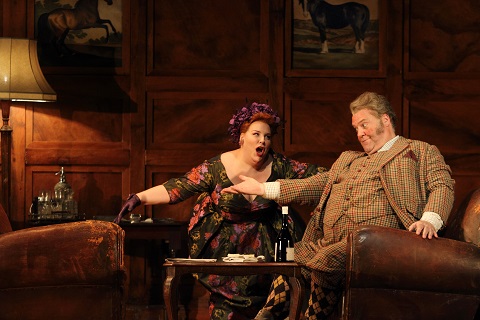 Marie-Nicole Lemieux as Mistress Quickly. Photo credit: Catherine Ashmore.
Marie-Nicole Lemieux as Mistress Quickly. Photo credit: Catherine Ashmore.
Marie-Nicole Lemieux was a scream as Mistress Quickly, and if she was larger-than-life and milked the camp for all it was worth, it didn’t matter when she was a walking exclamation mark with every entrance and exit - a kick of the heel, a flash of leg, a sashaying curtsey or flamboyant spin - and equally rich and resplendent of voice. Marie McLaughlin’s Meg Page was assured and poised, and if Ana María Martínez sometimes couldn’t match her female ‘accomplices’ for plushness, then she acted superbly, and her phrasing was as poised as her posturing before the gullible Falstaff.
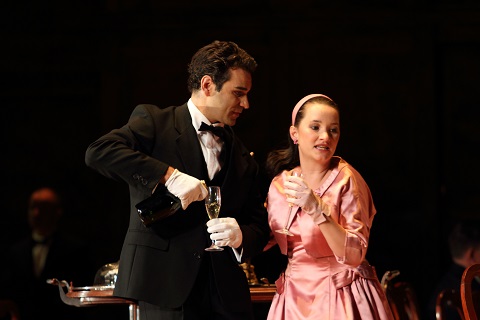 Frédéric Antoun as Fenton, Anna Prohaska as Nannetta. Photo credit: Catherine Ashmore.
Frédéric Antoun as Fenton, Anna Prohaska as Nannetta. Photo credit: Catherine Ashmore.
Anna Prohaska’s Nannetta was a dew-drop of guileless charm and genuine love, a real breath of fresh air; she floated her first top Ab with stunning purity - it punched right to the heart - and if the second was less pointed, well, she was on her knees, crawling backwards under a table for an assignation with her beloved Fenton. Prohaska and Frédérick Antoun’s Fenton shone through the seedy, soullessness of some of the romantic liaisons with an honest, innocent affection that was truly touching. Fenton can sometimes seem a bit spineless but Antoun’s Act 3 aria granted him vocal and dramatic stature.
As a shiny-suited Ford, Simon Keenlyside was a powerfully bitter presence amid the sugary self-indulgence. Surely his disguise, as Brook, would have fooled no one, the lavish ease of his rock-star locks and flamboyant shirt overshadowed by a rage aria which was frighteningly vicious, but which could have done with a bit more punch in the lower register.
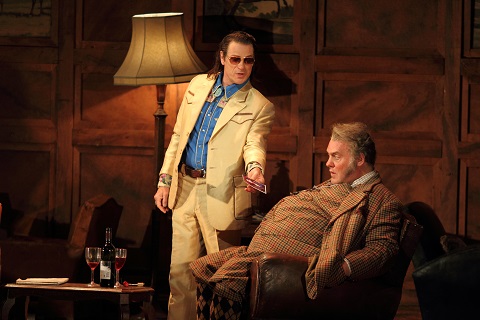 Simon Keenlyside as Ford. Photo credit: Catherine Ashmore.
Simon Keenlyside as Ford. Photo credit: Catherine Ashmore.
But, this opera rests or falls on the stomach and heart of its eponymous Fat Knight. And, what a wonderful singing actor Bryn Terfel is. Perhaps there were a few rough edges at times - Act 3 didn’t quite make its sentimental mark, though he blossomed authoritatively in Act 1’s honour aria - but he can do belligerency, bravado and belly-laughs with equal panache, and despite all Falstaff’s boasting and bluffing there was still that telling touch of sincerity to win the audience’s sympathetic smile and sigh.
Though first espied loafing indifferently behind a newspaper in his outsized bed at the Garter ‘Inn’, as agitated waiters wafted unpaid bills, or imbibing indulgently in a grimy onesie - six boiled eggs for breakfast with coffee and cognac, all on the tick - this Falstaff could miraculously transform himself, instantaneously resurrecting that memory of the former slim Duke of Norfolk, to take his place amid the privileged and entitled, and irritate the bespectacled gents in the hotel Reading Room.
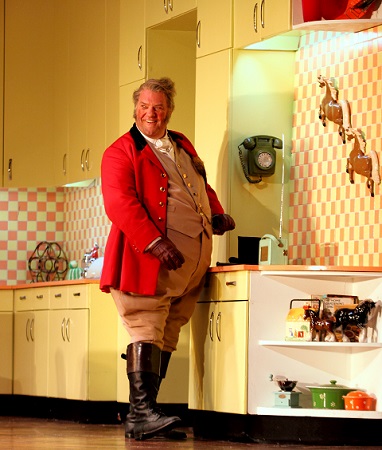 Bryn Terfel as Sir John Falstaff. Photo credit: Catherine Ashmore.
Bryn Terfel as Sir John Falstaff. Photo credit: Catherine Ashmore.
When visited by Mistress Quickly bearing an invitation to visit Alice, Terfel became the epitome of studied suavity à la P.G. Wodehouse. Terfel can twinkle his eyes, twaddle his cane and twiddle his top hat with stomach-tickling ease. Regaled in scarlet hunting regalia he was champing at the bit. In Act 2 he seemed to know how to place himself in the exactly the right place at just the wrong time, as the drama demands, commandeering his sexual territory atop of the formica kitchen units of Alice’s ‘perfect’ buttercup-hued kitchen, diving in the nick of time into a cupboard with the arrival of Ford, swinging - with some effort - his booted legs into the laundry basket as the jealous husband turned house and home upside down. Perhaps Terfel was upstaged by the munching horse at the start of Act 3, and, despite rolling athletically along the dining table, a delicacy at the cruel feast, couldn’t quite find his niche in an Act which in this production rather loses its way, but at the close he grasped the opportunity to quash his opponents with a quip, a flourish and winning flair.
Given the intemperate ego at the centre of the show, conductor Nicola Luisotti was a bit too restrained and the score might have zipped along with rather more spice. But, this revival is a sparkling summer spritzer.
Claire Seymour
Sir John Falstaff - Bryn Terfel, Alice Ford - Ana María Martínez, Ford - Simon Keenlyside, Nannetta - Anna Prohaska, Fenton - Frédéric Antoun, Mistress Quickly - Marie-Nicole Lemieux, Meg Page - Marie McLaughlin, Dr Caius - Carlo Bosi, Bardolph - Michael Colvin, Pistol - Craig Colclough; Director - Robert Carsen, Conductor - Nicola Luisotti, Set designer - Paul Steinberg, Costume designer - Brigitte Reiffenstuel, Lighting designers - Robert Carsen and Peter van Praet, Royal Opera Chorus and Orchestra of the Royal Opera House.
Royal Opera House, Covent Garden, London; Saturday 7th July 2018.
image=http://www.operatoday.com/Bryn%20Terfel%20as%20Sir%20John%20Falstaff%20%28C%29%20ROH.%20Photo%20by%20Catherine%20Ashmore.jpg image_description=Falstaff, Royal Opera House product=yes product_title=Falstaff, Royal Opera House product_by=A review by Claire Seymour product_id=Above: Bryn Terfel (Falstaff)Photo credit: Catherine Ashmore
July 8, 2018
Down on the Farm with Des Moines’ Copland
Such “second stage” productions of smaller works have proven to be highly popular, sold-out accent pieces to the company’s three main stage offerings at the Blank Performing Arts Center in Indianola.
The bucolic setting with a backdrop of rolling cornfields and a colorful sunset were the perfect environment for Adam Crinson’s evocative set design, a farm-within-a-farm. The imposing barn façade stage left and family house, right, made solid, earthy impressions while still incorporating some skeletal artistic elements that imbued them with a theatrical whimsy. A semi-circular white, wooden fence corralled the action and effectively defined the playing space on the plush lawn.
Nate Wheatley worked wonders with limited, sprawling resources to create an evocative lighting design that was an amalgam of even washes, variable colors, subtle isolated specials, and a blazing sunrise effect that visually underscored the heroine’s dawning awareness of her path in life. Heather Lesieur’s homey, lived in costumes proved just the right look to define individual characters. I wondered if the itinerant Martin mightn’t have looked a bit too clean cut and unrumpled, but there is no doubting that Ms. Lesieur’s choice set him apart as the attractive hero.
Octavio Cardenas directed the gentle doings of Laurie’s coming of age with a knowing eye and a sure hand. Mr. Cardenas used the expansive playing space to good advantage, creating varied, continually morphing tableaux in the party scene, all the while keeping a good focus on the smaller dramas playing out within it. Character relationships were clear, sincere, and focused. The director also used well-motivated blocking to move the action around so that all audience members in the semi-circular tiered seating were engaged. Choreographer Isaac Martin Lerner devised simple, cleverly synchronized steps and gestures for “Stomp Your Foot” that still allowed Lisa Hasson’s well-tutored chorus to sing with abandon and precision.
Conductor Joshua Horsch not only found all the colors of the blatant Americana in Copland’s folksy writing, but also elicited a shimmering serenity inherent in so much of the score’s luminous atmosphere. Thanks to the placement of monitors (hidden in wooden crates around the perimeter), Maestro Horsch maintained awesome control of his disparate forces, whether in the jaunty, playful story-telling passages, or the inexorable build-up of the unfolding “Promise of Living.” The instrumentalists rewarded him with a flavorful, idiomatic reading.
As did Glimmerglass a few seasons ago, DMMO chose to people its exceptional cast with soloists from its admirable Apprentice Program, meaning all the characters save the child Beth Moss (a delightful Camryn Overton) appeared to be the same average age, whether high school graduate or grandfather. The trade-off is that we were treated to ninety minutes of some continually impressive, fresh-voiced singing.
Lindsay Kate Brown used her rich, plummy mezzo to fine effect as a sympathetic Ma Moss. While Ma has affecting moments of melodious resignation, Ms. Brown also proved that her delivery could crackle and snap, as she confronted her defiant daughter, or falsely accused the drifters of a heinous crime. Rhys Lloyd Talbot’s orotund bass-baritone suggests maturity far beyond his years. Mr. Talbot opens his mouth and a rolling, oaken sound pours out with incredible ease, yet always with dramatic conviction and appropriate coloring. It is to the show’s credit that while both suggest older age with their gait and posture, neither resorts to caricature. Kudos too, to Brittany Crinson’s subtle hair and make-up design for avoiding this trap.
As the restless Laurie, Grace Kahl was perfectly matched to the role’s requirements, her poised, gleaming soprano effortlessly encompassing the musical and emotional gamut. Ms. Kahl instantly engages our hearts and ears with a radiant rendition of “The World So Wide,” and never lets go. Her journey to self-awareness is the reason for the piece and she never falters in her focused trajectory. As her love interest, Martin, tenor Remy Martin (yes!) is boyishly shy, and he suggests that and his indecision with a pleasing lyrical delivery that grows in scope and determination as his love for Laurie deepens. Both Mr. Martin and Ms. Kahl are so attractive and sing so persuasively that we buy into the love-at-first-sight cliché with willing disbelief.
Harry Greenleaf had a great time as the ne’er-do-well Top, his lustrous baritone somewhat belying his malintent. Mr. Greenleaf’s incisive banter with Martin/Martin resulted in some of the evening’s highlights. Tenor Adam Bradley made the most of his time as the postman Mr. Splinters, securely delivering many important expository and explanatory passages. Emily Triebold’s focused mezzo served Mrs. Splinter’s solo lines well. As Mr. and Mrs. Jenks, baritone Craig Juricka and Emily Kern enlivened the party scene with solid, appealing vocalizing.
At the premiere, the amplification of the singers, especially the men, was unfortunately not always up to DMMO’s usual high standard. This will no doubt be fully corrected for the second and final showing. Nevertheless, these occasional minor problems could not distract from the overall excellence of the experience. Operagoers even had the option of additionally booking a late afternoon tour of the famous farm, and/or an on-site dinner. For all, free popcorn preceded the show, pie and ice cream followed. How often does that happen?
But that’s Des Moines Metro Opera. Unique. Surprising. Engaging.
James Sohre
The Tender Land
Laurie Moss: Grace Kahl; Martin: Remy Martin; Grandpa Moss: Rhys Lloyd Talbot; Ma Moss: Lindsay Kate Brown; Beth Moss: Camryn Overton; Top: Harry Greenleaf; Mr. Splinters: Adam Bradley; Mrs. Splinters: Emily Triebold; Mr. Jenks: Craig Juricka; Mrs. Jenks: Emily Kern; Conductor: Joshua Horsch; Director: Octavio Cardenas; Set Design: Adam Crinson; Lighting Design: Nate Wheatley; Costume Design: Heather Lesieur; Make-up and Hair Design: Brittany Crinson for Elsen Associates; Choreographer: Isaac Martin Lerner; Chorus Master: Lisa Hasson
image=http://www.operatoday.com/000308.jpg
image_description=Image courtesy of Des Moines Metro Opera
product=yes
product_title=Down on the Farm with Des Moines’ Copland
product_by=A review by James Sohre
product_id=Above image courtesy of Des Moines Metro Opera
Des Moines’ Ravishing Rusalka
Des Moines Metro Opera has mounted a stunner of a production, splendidly sung, passionately played, and inventively staged. Dare I say, definitive? Never before have I been as entertained or as moved by Dvorak’s masterpiece as on this occasion.
Sara Gartland was utter perfection in the title role, a performance on full throttle from first to last as she descended inexorably from infectious, hopeful girlish impetuosity to end up a pathetically defeated nonentity. Her singing was nothing less than radiant throughout. Ms. Gartland possesses a substantial lyric soprano of great beauty and rock solid technique that seems to know no bounds when it comes to alluring sheen, emotional connection, thrilling top notes, vibrant mid-range, floated pianissimi, and well, any and all variations thereof. Moreover, her attractive presence and committed acting were all one could wish for this complex heroine. I would wager there is no one in the world singing this role better than Sara Gartland.
Evan Leroy Johnson was every bit her equal as the conflicted Prince. From his first phrase with its gleaming, robust tone and Heldentenor promise, Mr. Johnson announced himself as a major talent. Tall, handsome, strapping, he appeared every inch the romanticized royal. His freely produced, technically secure tenor was also able to modulate its size to encompass melting phrases of tenderness and pathos. I will not soon forget his affecting death scene, which had us helpless in tears, hanging on his every utterance. But when it came to firepower, he tirelessly, decisively delivered the goods. Indeed, one particularly searing extended high note had such thrilling power, beauty, and accuracy that, completely awed, I involuntarily said the F-word! (Apologies, neighbors, but you probably thought it too.) You read it here: If young Johnson (he is 26) takes his time and takes his pick, he is destined to be the next star tenor of his generation.
Great depth of casting is taken for granted at DMMO, and the embarrassment of riches continued with the powerful Vodnik (Water Sprite) embodied by bass Zachary James. Having been mightily impressed by his Claggart last summer, I came to this performance with big expectations, and he exceeded them all. Mr. James’ vibrant, virile singing can ping off the walls with potent urgency and chilling effect. But he is equally capable of nuanced vocalizing that communicates fatherly concern and even pathos. He is a born stage animal who prowls, slides and lurks about the proceedings with consummate presence and unerring dramatic effect.
Not about to be outdone, the redoubtable Jill Grove threatens to steal every scene she is in with a nonpareil turn as the witch, Ježibaba. Ms. Grove has a rich, robust mezzo with a pleasantly smoky timbre and she deploys it fearlessly. A consummate artist, she confidently negotiates the bridge between upper and chest register with musical skill and dramatic savvy. There is no tic or comic subtlety of this role that eludes her and she seizes every opportunity. Her wry stage business of puffing a cigarette was but one invention that informed her characterization. When it came time to get serious, the lady was equally capable of sending a shiver down your spine with her menacing, dead level pronouncements.
Laura Wilde sang so impressively as the Foreign Princess that I wished the composer had given her more stage time. Her poised, gleaming soprano seems to have taken on a bit more weight since last I heard her, and the spinto-leaning approach to this role yielded beautiful musical dividends. Her mean-girl theatrical commitment and hauteur were a perfect foil to the mute (at this point) beauty, Rusalka.
There is no way to separate out the lovely achievements of the Wood Sprites, Dorothy Gal (1), Cadie Jordan (2), and Namoi Brigell (3). Whether in solo or ensemble, the three offered limpid, pliable, steady singing of the highest order. Gregory Warren’s meaty baritone enlivened the Gamekeeper’s critical scenes. Grace Kahl, such a shining, serenely determined Laurie in the previous evening’s The Tender Land, did an about face and put her sterling soprano to good use creating a scrappy, skittish impression as the flighty Kitchen Boy. Harry Greenleaf’s warm, hearty baritone ably dispatched the Hunter’s lines with considerable beauty.
David Neely conducted an incandescent reading of this challenging score. Brooding and agitated one moment, lushly layered the next, ethereal and transcendent the following, Maestro Neely handled the work’s complexities and shifts with his usual commendable dexterity. All night long he elicited nigh unto virtuoso playing from his talented band, all the while partnering effortlessly with the singers to create a memorable piece of lyric theatre.
The physical production was lavish, mysterious, malleable, and as inventive as all get out. Since it is the first element we experience, pride of place is given to Jacob A. Climer’s sumptuous set design, which manages the feat of suggesting an underwater locale and dry land simultaneously. There are three large doorways in the wainscoted wall that is set into the proscenium.
These white walls are randomly decorated with fragments of blue drawings (think Delft pottery) and the entire floor of the stage, and everything on it, is similarly white with blue details. Armoires and chairs are askew, seeming as if they have come to rest, all akimbo on the ocean’s floor. Other furniture pieces are floating randomly overhead as if suspended en route to a similar resting place. Ježibaba’s residence turns out to be a chest leaning proscenium right, and when the doors are opened smoke and eccentric tschotchkes are revealed. Vodnik first slithers into view onto a skewed slab down center from a concealed trapdoor.
For Act Two’s Prince’s palace, cabinets are upright, a huge banquet table is place on the apron, and practical sets of huge glass-paned double doors occupy the arches. All of this, mind you, including the drapes and the settees, has been painstakingly detailed with those indigo ink fragmented images, making the setting fairly shimmer with busy-ness. Act Three removes the doors, places a lone, isolated chair on the apron, and restores the witch’s “hut.” If anything might upstage Mr. Climer’s opulent scenery it would be Mr. Climer’s equally eye-popping costumes.
The fantasy costuming for the water creatures is whimsical, diaphanous, and richly layered. The variegated coloring and subtle sequins harmoniously lifted us out of our reality and into a magical realm. The mortals/royals costumes are just as engaging, their formality filtered through a fairy tale lens. A billowing, shiny yellow ball gown was as brash and insistent as the Foreign Princess who wore it. The household servants’ rust accents were wonderfully matched by Brittany Crinson’s ginger wigs. Ms. Crinson displayed substantial transformational hair and make-up success throughout, not least with the three Wood Sprites and the bewhiskered, tattooed Vodnik.
Nate Wheatley created an atmospheric lighting design, with judicious use of gobo patterns, diffusions, moody area lighting, shifting specials, and an excellent, disquieting final lightning effect. Mr. Wheatley also created the haunting pale moon projection, which chillingly morphed into blood red coloration in the course of Act Three. Isaac Martin Lerner contributed highly inventive choreography for the six male servants. Most memorably, the sextet spun and twisted and turned and do-si-do’d with dizzying precision as they meticulously dressed the dinner table in Act Two.
Chas Rader-Shieber has added another jewel to his directing crown. There was no moment of this remarkable, coherent staging that did not seem infused with his creative spirit. Overall, he succeeded in realizing the disturbing unease of the piece and its shifting fortunes. His blocking conveys a restlessness that often has the actors prowling the playing area in search of a place, and a reason, to light. When stillness is called for, Mr. R-S unselfconsciously draws a meaningful picture with telling groupings and positioning. His imagination informed the entire, unnerving, relentless arc of the storytelling.
One effect I will never forget is having the witch hand the about-to-be-mortal Rusalka a pair of high heel shoes. That she will forever be rooted to the land is clear in Act Two when the poor mute heroine cannot, no matter how hard she may try, get the shoes off her feat and return to the sea. As Act Three begins, Rusalka stumbles on stage, skirt hem bloodied, bloodied knife in her left hand, bloodied shoes in her right, and her feet stumps almost unrecognizably bloodied from her having tried to: Cut. Off. Her. Mortality. The wave of chills I got from that image just came back as I retold it.
This compelling Rusalka proved to be, for me, another “best ever” experience that can only be created by a team at the top of its game, in a theatre that allows us to share this intimate journey in such proximity that it seems we are virtually inhabiting this very special world ourselves.
Thank you, Des Moines Metro Opera for another unforgettable artistic triumph.
James Sohre
Rusalka
1st Wood Sprite: Dorothy Gal; 2nd Wood Sprite: Cadie Jordan; 3rd Wood Sprite: Namoi Brigell; Vodnik: Zachary James; Rusalka: Sara Gartland; Ježibaba: Jill Grove; Hunter: Harry Greenleaf; Prince: Evan Leroy Johnson; Gamekeeper: Gregory Warren; Kitchen Boy: Grace Kahl; Foreign Princess: Laura Wilde; Dancers: Tanner Myles Huseman, Isaac Martin Lerner, Andrew Scott Pester, Owen Prum, Cooper Stanton, Devin Tokarski; Conductor: David Neely; Director: Chas Rader-Shieber; Set and Costume Design: Jacob A. Climer; Lighting Design: Nate Wheatley; Make-up and Hair Design: Brittany Crinson for Elsen Associates; Choreographer: Isaac Martin Lerner; Chorus Master: Lisa Hasson
Image=http://www.operatoday.com/Rusalka%20Des%20Moines.jpg
image_description=Rusalka, Des Moines Metro Opera
product=yes
product_title=Rusalka, Des Moines Metro Opera
product_by=A review by James Sohre
product_id=
July 7, 2018
L'Ange de feu (The Fiery Angel)
in Aix
Its primary role, the possessed Renata, is punishing nearly beyond comprehension and its relentless, lurid narrative is difficult to follow, and in fact the vulgarity of its music can be off-putting.
The Fiery Angel is the third of Prokofiev’s seven operas (The Gambler and Love for Three Oranges are the first two), and the last opera he wrote before his return to Russia in 1936. Though begun in 1919 when the composer was 28 years old, and completed only in 1927 it was not premiered until 1955 in Paris and then in Vienna.
There is no doubt that The Fiery Angel is Prokofiev’s most intense dramatic music. It tells the ugly story of a young girl possessed by an angel, though perhaps a devil. She wishes to make physical love with her possessor. Two or so hours and several mis-adventures later she is exorcized (unsuccessfully) in a convent together with other nuns. It is a medieval tale of expressed sexual desire told from an early twentieth century symbolist perspective.
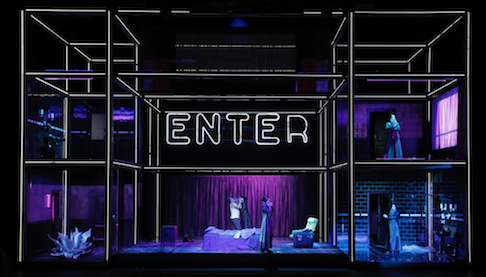 At the beginning there was the hotel room.
At the beginning there was the hotel room.
The possessed Renata and her would be redeemer, the knight Ruprecht seek and do find the angel of fire incarnate with the help of sorcerers. Finally Renata gives herself sexually to Ruprecht in place of the angel. A short philosophical discussion ensues between Mephistopheles and Dr. Faustus. And, voilà, Renata is condemned to be burned at the stake.
Mariusz Trelinski, artistic director of Teatr Wielki, staged the opera updating the action to what seemed to be rural eastern European surroundings in the communist 1960’s. Ruprecht seemed to be some sort of traveling salesman (if there were such then and there) who happened onto a seedy small town hotel. One recalled the Arthur Miller play Death of a Salesman.
Strangely, though we are in France and there are scenes specifically in medieval Cologne there were English language neon signs placed high in a multi-storied grid that was the stage face. The Cologne scenes were then staged on platforms in its upper reaches, effectively and unfortunately disembowelling Renata and Ruprecht’s voices from the dissonant maelstrom emanating from the pit way below.
Japanese conductor Kazushi Ono urged ever greater volume and bombast from the stalwart Orchestra de Paris, complementing the crassness of the staging. One of the many remarkable moments was in fact the long awaited sexual consummation of Renata and Ruprecht, the couple humping on an upper level, the orchestra turging away way down below while a miniature Ruprecht double attempted to jump rope on the stage floor.
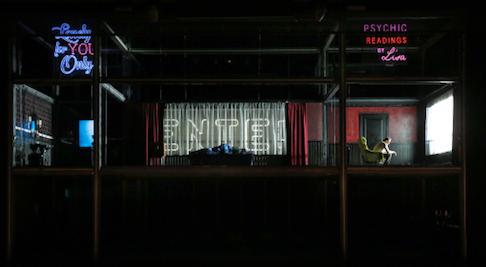 Renata (on left), Ruprecht (on right)
Renata (on left), Ruprecht (on right)
The role of Renata was sung by Aušrinė Stundytė, the Lithuanian soprano who incarnated the brilliant Lady Macbeth of Mtsensk in Lyon. Mme. Stundytė brought similar intensity to the obsessed Renata, but fell victim, understandably, to the obtuse staging demands as well as to the stamina needed to complete the role. She was essentially voiceless for the concluding exorcism.
The American baritone Scott Hendricks was the Ruprecht. This esteemed artist seemed a fish out of water, his fine, Italianate lyric voice not finding an edge or the volume needed to embody this complex, possessed-by-love knight who first attempts to rape Renata, and then in this production is raped by Renata. As well, and more importantly, Mr. Hendricks was placed in the upper reaches of the grid for his big scenes, depriving us of a direct presence, and an immediacy of voice.
Faring better were tenor Andrei Popov as Mephistopheles and bass Krzysztof Baczyk as Faust who both essentially tore up the stage in their stage level scene in the hotel bar. Both artists succeeded in projecting words and sentences that directly tied us to content, however oblique, an attribute sorely lacking in the balance of Mr. Triliński’s production.
Michael Milenski
Cast and production information:
Renata: Aušrinė Stundytė; Ruprecht: Scott Hendricks; La Voyante / La Mère supérieure: Agnieszka Rehlis; Méphistophélès / Agrippa von Nettesheim: Andreï Popov; Faust / L’Inquisiteur: Krzysztof Bączyk; Jakob Glock / Un médecin: Pavlo Tolstoy; Matthieu Wissmann / L'Aubergiste / Un serviteur: Łukasz Goliński; La Patronne de l’auberge: Bernadetta Grabias; Première religieuse: Bożena Bujnicka; Seconde religieuse: Maria Stasiak. Orchestre de Paris, Chorus of the Opera of Warsaw. Conductor: Kazushi Ono; Mise en scène: Mariusz Treliński; Scenery: Boris Kudlička; Costumes: Kaspar Glarner; Lighting: Felice Ross; Vidéo: Bartek Macias; Chorégraphe: Tomasz Wygoda. Grand Théâtre de Provence, Aix-en-Provence, July 5, 2018.
image=http://www.operatoday.com/FieryAngel_Aix1.png
product=yes
product_title=The Fiery Angel in Aix
product_by=A review by Michael Milenski
product_id=Above: Aušrinė Stundytė as Renata [All photos by Pascal Victor / Artcompress © courtesy of the Aix Festival]
July 6, 2018
Ariane à Naxos (Ariadne auf Naxos) in Aix
Among her Aix projects Mme. Mitchell staged George Benjamin’s Written on Skin with libretto by British playwright Martin Crimp. Mr. Crimp has subsequently served as dramaturg for Mme. Mitchell’s Aix Pelleas et Melisande and now for Ariadne, both productions brilliantly moving to meta-theatrical levels (metatheater is a Martin Crimp coined term). This simply means that it is theater as seen by theater — the original exists as well as how it is seen. Like metaphysics.
Of crucial contribution to the Aix Ariadne was the conducting of German born Marc Albrecht, now chief conductor of the Dutch National Opera. This maestro exploited the chamber music voice of the Strauss score in the expanses of the open air Théâtre de l’Archeveché, the grandness of Strauss’ orchestral introduction to the prologue monumentally minimized, but energized to accommodate the frantic transformation of the host’s (“the richest man in Vienna”) grand parlor into a makeshift theater space (a square of sand with a dinner table).
The maestro pulled out the intricacies of the myriad instrumental solos to create the usual intensity of backstage energy now augmented by the negotiations of merging commedia dell’arte with opera seria. Zerbinetta’s persuasive arguments to the opera seria’s composer seamlessly flowed into a passing moment of private musing by the composer, his fervent ode to music magically absorbed into the behind-the-scenes maelstrom.
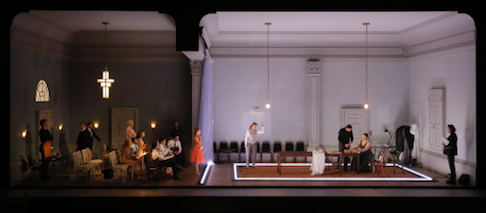 The totality of the Katie Mitchell production
The totality of the Katie Mitchell production
And finally Mo. Albrecht transformed Strauss’ bombastic Ariadne Bacchus duet into an intimate discussion between two lovers accompanied by the exquisitely sweet comments of Dryad, Naiad and Echo, Bacchus taking frequent gulps of water from a plastic water bottle.
As Strauss and Von Hofmannsthal intended it was chamber opera, though now with Mme. Mitchell’s superimposed household on top of it — remember that the original intention was that Strauss’ opera seria was but an ending for Moliere’s Bourgeois Gentilhomme (translated by Von Hofmannstahl). In fact Mme. Mitchell’s household’s cross-dressed host and hostess sometimes interrupted Strauss’s opera with sarcastic comments (spoken) before they too climbed onto the stage to participate in Ariadne’s plight* and Zerbinetta’s solutions.
*Ariadne was pregnant.
Strauss was a very reluctant partner in this second, purely operatic version of the Strauss Von Hafmannstahl play-cum-opera, fearing with grave and indeed quite pertinent concerns a lack of comprehensibility for such a far-out, obliquely sculpted narrative. Katie Mitchell brilliantly brokered this Von Hofmannstahl/Strauss dispute by pulling it all together into one totality. The play within a play, the location and circumstance of the play, the guests at the play, the actors in the play (the commedia dell’arte troupe became transfixed by Ariadne’s outpourings), the exposed backstage psychologies, the opera indeed coalesced into pure metaphysics.
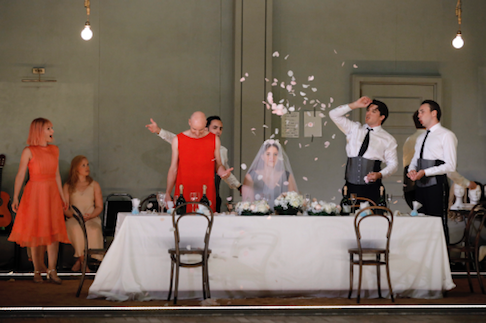 Zerbinetta, the richest man in Vienna, Ariadne, three of the commedia troupe
Zerbinetta, the richest man in Vienna, Ariadne, three of the commedia troupe
The Aix Festival is famed for its casting sophistication, and this Ariadne is no exception. Young Norwegian soprano Lise Davidsen let out immense, inhuman howls to welcome us to Ariadne’s solitude on Naxos. She added fine musicianship and vocal finesse in the use of her hugely powerful voice. French soubrette Sabine Devieilhe as Zerbinetta cooly seduced first the composer, and then she lectured Ariadne with splendrous soubrette tone in her lengthy, very lengthy “Großmächtige Prinzessin…So war es mit Pagliazzo.” The aria is punishing in its brilliant, stratospheric tessitura, flawlessly exuded in this Zerbinetta’s atypical soft charm and compassion that fit perfectly into the metaphysics of the production.
American mezzo-soprano Angela Brower as the composer physically conducted her opera though of course she sang not a word after the prologue, her presence in the opera seria adding the concept of creation and pride of creation to Mme. Mitchell’s inexhaustible philosophical complexities. She somehow seamlessly integrated her “Sein wir wieder gut” into the conceptual flow of the prologue, emanating gorgeous silvery tones in her radiant declaration of the powers of music.
Austrian bass baritone Josef Wagner as the Music Master was indeed authoritative in his deftly sung, deft management first of the spoken majordomo (actor Maik Solbach) and then of household’s two sets of performers. He was aided by the household’s very tall Dance Master, cross dressed and made taller by stiletto heels in the person of British tenor Rupert Charlesworth who for all his draggy, swishy flightiness was cooly supportive of the fraught performers in frank, masculine voice.
Like Zerbinetta the comedia dell’arte troupe (Harlequin, Brighella, Scaramuccia and Truffaldino) had costumes that lighted up (ah, what riches LED lights have brought to opera), in this case the exaggerated cumberbunds of their matching formal wear (black pants, white shirts) lighted up to make the flashiness of their comedic performances apparent, and in stark contrast to their weighty, maybe drab operatic counterparts.
Dryad, Naiad and Echo were physically matched to be sprites of nature, and vocally matched to be the sweetly voiced handmaidens of nature and its eternal renewal. Bacchus was sung by American heldon tenor Eric Cutter who served and re-served in stentorian voice (lubricated by gulps of water) the cake-like boxes of starry lights to Ariadne’s table throughout her death scene.
This Ariadne auf Naxos is an Aix Festival co-production with Barcelona, Paris, Helsinki, Copenhagen and Luxembourg. Be advised, it is a production worth crossing continents, even oceans to see.
Michael Milenski
Cast and production information:
Primadonna / Ariadne: Lise Davidsen; Der Tenor / Bacchus: Eric Cutler; Zerbinetta: Sabine Devieilhe; Der Komponist: Angela Brower; Harlekin: Huw Montague Rendall; Brighella: Jonathan Abernethy; Scaramuccio: Emilio Pons; Truffaldin: David Shipley; Najade: Beate Mordal; Dryade: Andrea Hill; Echo: Elena Galitskaya; Ein Musiklehrer: Josef Wagner; Ein Tanzmeister: Rupert Charlesworth; Ein Offizier: Petter Moen; Ein Perückenmacher: Jean-Gabriel Saint Martin; Der Haushofmeister: Maik Solbach; Ein Lakei: Sava Vemić; L'Homme le plus riche de Vienne: Paul Herwig; Sa Femme: Julia Wieninger. Orchestre de Paris. Conductor: Marc Albrecht; Mise en scène: Katie Mitchell; Dramaturge: Martin Crimp; Set Design: Chloe Lamford; Costumes: Sarah Blenkinsop; Lighting: James Farncombe; Responsable des mouvements: Joseph W. Alford. Théâtre de l”Archevêché, Aix-en-Provence, July 4, 2018.
image=http://www.operatoday.com/Ariadne_Aix1.png
product=yes
product_title=Ariadne auf Naxos at the Aix Festival
product_by=A review by Michael Milenski
product_id=Above: Zerbinetta on Ariadne's table with two of the three sprites [All photos by Pascal Victor / Artcompress © courtesy of the Aix Festival].
The Skating Rink: Garsington Opera premiere
This is Sawer's third opera. His first, From Morning Till Midnight , to his own libretto based on a Georg Kaiser play, was premiered with some success by English National Opera in 2001, though his second opera, in fact an operetta, Skin Deep with a libretto by Amando Iannucci, perhaps failed to quite find its mark when premiered by Opera North in 2009. This new piece, The Skating Rink, seems something of a return to the darker, expressionist world of From Morning Till Midnight, though not without lighter moments.
Bolano's novel tells the same events from the points of view of three narrators, each of whom is involved in a different way in the events in a 1990s Spanish town on the Costa Brava, where love leads Enric (Grant Doyle) to build an illicit ice skating rink so that Nuria (Lauren Zolezzi and Alice Poggio) can train, but the murder of a former opera singer Carmen (Susan Bickley), now living on the streets, clouds issues.
Rather daringly, Sawer and Mullarkey take this structure into the opera: each of the three acts tells the same events from a different point of view. First, that of Gaspar (Sam Furness) the night watchman at a holiday camp, tasked with evicting Carmen and Caridad (Claire Wild) and in love with the latter, who eventually discovers the illicit rink. Then, Remo (Ben Edquist), Gaspar's boss, who is in love with Nuria and thinks that he has a relationship with her. And, finally, Enric (Grant Doyle), the fat and unlovely head of the town's social services whose obsession with Nuria leads him to build the rink for her. Each act advances the plot slightly: the first ends with the discovery of the rink, the second with the discovery of Carmen's body, and the third with the arrest of Enric. Then, in a Coda, we find out who really did the murder.
The result is rather multi-layered, the characters are unwrapped rather akin to a Baroque opera, in that we first see Enric through the eyes of Gaspar and Remo before we hear his point of view. Key moments are enacted three times, notably the eviction of Carmen and Caridad, but each time in a different context. Also, rather daringly, each of the narrators actually addresses the audience: Sawer and Mullarkey stop time and allow the narrators to address us and explain themselves. This means that some of the action is described rather than experienced. Again, this creates a complex multi-layering, the sort of remove from filmic naturalism which is essential when creating an opera and this new piece is thankfully anything but a sung play.
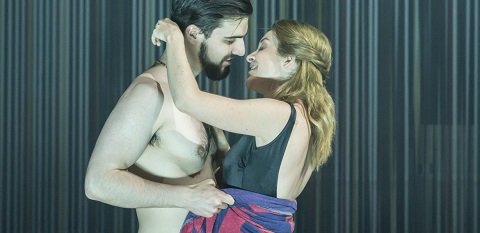 Ben Edquist (Remo), Lauren Zolezzi (Nuria). Photo credit: Johan Persson.
Ben Edquist (Remo), Lauren Zolezzi (Nuria). Photo credit: Johan Persson.
David Sawer is noted for the drama of his orchestral works, and he uses the orchestra in The Skating Rink to create, colour and animate the atmosphere. The orchestra becomes another protagonist and whilst Sawer's harmonic language might be complex and sometimes challenging, his textures and ear for timbres made the music often seductive and accessible. This is a highly coloured score, which reflects the subject matter, and Sawer weaves into it popular references, yet never directly. Having the opera singer Carmen entertaining in a cafe created a magical scene at the end of Act Two, and Act Three included a disco which managed to mix drama with a popular beat, not to mention actor Steven Beard doing a wonderful karaoke number! And, the use of a brass-band (off-stage and walking on), created some wonderfully Ivesian counterpoints.
It helped that Sawer and Mullarkey had created some strongly characterised, not to say meaty roles so that Garsington Opera's cast of singing actors had something to get their teeth into. Whilst this is not an opera that you will come out of singing the tunes, Sawer's vocal lines, though sometimes complex, were dramatic, enlivening and expressive; he never noodled. For the passages where the narrators addressed the audience directly, Sawer chose a simpler, plainer style, a more neutral type of discourse which threatened sometimes to lack dramatic interest.
Stewart Laing's production did not aim to give us naturalism. We never saw the Palacio Benvingut where the skating rink was built; instead, we had to rely on the descriptions from the characters. The basic set was a space with a backdrop of a plastic curtain, which evoked those found in caravans of the period, and the stage littered with packing cases. A mobile box structure became Gaspar's office, Remo's home and Enric's office, moving about as necessary. Other elements, such as tables and chairs were brought on, and the front of the stage had a boardwalk. Yet, throughout the first act we asked ourselves, where was the skating rink? In fact, it was there all the time, the floor of the stage was covered with a special material which enabled Alice Poggio to skate on it. (One of the male actors also skated, providing a dream image of Enric as he imagines skating on the ice.) Where necessary, the cast brilliantly evoked the trickiness of walking on ice with unsuitable footwear.
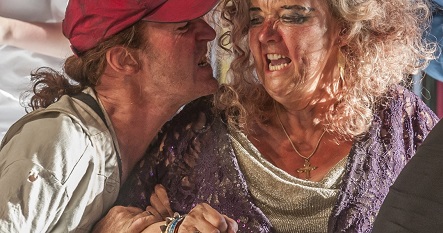 Alan Oke (Rookie), Susan Bickley (Carmen). Photo credit: John Snelling.
Alan Oke (Rookie), Susan Bickley (Carmen). Photo credit: John Snelling.
This was very much an ensemble production. Characters emerged and then retreated, and each singer gave a committed, engaged and engaging performance. Sam Furness was wonderfully passionate as the young Gaspar, whose obsession with Carmen's companion Caridad (Claire Wild) sets the plot in motion. Furness produced a fine stream of firm tone and strong emotion. This was a thrillingly committed performance. As Remo, Ben Edquist (making his UK debut) was cooler and emphasised the character's lack of self-reflection. Rather sex-obsessed, he never understands his relationship with Nuria (the tantalising Lauren Zolezzi), and is puzzled when she evaporates. Edquist has the work's final words, slightly enigmatic and wonderfully evoking the character's puzzlement at life. As the final narrator, Enric, Grant Doyle was particularly impressive having taken on the role at relatively short notice to replace an ailing Neal Davies. At first, we see Enric through others' eyes, fat, unlovely and rather nasty, and only in the last act do we find the passion and obsession underneath. Doyle gave a beautifully crafted, multi-layered performance which really brought the character alive and, surprisingly, made us begin to sympathise with him.
The limitations of Sawer and Mullarkey's approach was the other characters were slightly less well drawn. There was no authorial voice and this meant that we never heard things from Carmen, Caridad or Nuria's point of view.
Susan Bickley was superb as Carmen, fierce, troubled and rather crazed, yet complex, and revealing elements of the person she used to be in moments like her singing in the cafe, and her blackmailing of Enric (having discovered the skating rink, built with embezzled council money). Claire Wild was evocative as the troubled Caridad, whom we only saw her through Gaspar's eyes. Lauren Zolezzi really brought out the mystery and sense of contained distance in Nuria's character, as we see her through both Remo's eyes and those of Enric. And, she was allowed to develop most, as we learned more about her in the coda. The movement between Zolezzi as singing Nuria and Alice Poggio as skating Nuria was beautifully done, and the result was a very real character.
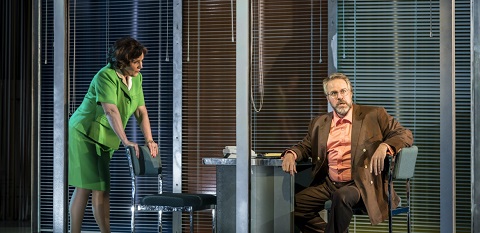 Louise Winter (Pilar), Grant Doyle (Enric). Photo credit: Johan Persson.
Louise Winter (Pilar), Grant Doyle (Enric). Photo credit: Johan Persson.
The role of Pilar the town's mayor might have been relatively small, but Louise Winter really made it count. Alan Oke was Carmen's would-be lover Rookie. Also living on the streets, the two have a love-hate relationship with a wonderful shouting match which concluded Act Two. Rather underused in the three main Acts, Oke created Rookie's character using a breathy form of sprechstimme, which blossomed in his final solo in the coda which revealed the truth of the murder in thrilling fashion.
Under Garry Walker's expert guidance, the orchestra drew a wide range of colours and textures from Sawer's score, giving as thrilling and committed performance as the singers on stage and making the piece really count.
Sawer and Mullarkey have created a new opera with a striking voice, one which managed to draw an enthusiastic response from a very engaged audience, without ever seeming to talk down and with music which was of admirable complexity and sophistication. The drama was handled in a confident fashion which really made you want to know what was going to happen. The whole received a strong performance from both cast and orchestra, and it is being recorded by the BBC for broadcast later this year on BBC Radio 3.
Robert Hugill
David Sawer & Rory Mullarkey: The Skating Rink
Ramo - Ben Edquist, Gaspar - Sam Furness, Enric - Grant Doyle, Carmen - Susan Bickley, Caridad - Claire Wild, Rookie - Alan Oke, Nuria - Lauren Zolezzi, Pilar - Louise Winter, Nuria (skater) - Alice Poggio; Director & design - Stewart Lang, Conductor - Garry Walker.
Garsington Opera, Worsley; Thursday 5th July 2018.
image=http://www.operatoday.com/Alice%20Poggio%20%28Nuria%20skater%29%20credit%20John%20Snelling.jpg image_description=The Skating Rink, Garsington Opera product=yes product_title=The Skating Rink, Garsington Opera product_by=A review by Robert Hugill product_id= Above: Alice Poggio (Nuria skater)Photo credit: John Snelling
July 5, 2018
Madama Butterfly at the Princeton Festival
The title role of Cho-Cho-San, the 15-year old geisha whose naïve love for an American sailor ends in suicide, belongs among the most challenging in the Italian repertoire. Any singer who dares to tackle this role requires the stamina to remain on stage nearly continuously through almost three hours, singing with a full range of dynamics, emotions, and textual nuances. Puccini’s heroine is driven from child-like innocence in Act I, to pious determination in Act II, and to wrenching anguish in Act III.
Yulia Lysenko, a Ukrainian-trained soprano but now living in the US, approached the role with vocal virtues common among the great mid-20 th century exponents of this role: technical security, perfect intonation, and a credibly child-like timbre. Her characterization was heart-felt, believable and consistent—if sometimes a bit unsubtle and not always ideally alert to the text. As essentially lyric singers of this type often do, she struggled a bit with weightier utterances that lie lower in her voice.
Matthew White, a recent competition-winning tenor from Virginia still finishing up at the Academy of Vocal Arts, brought to the role a small and well-formed young voice. His penetrating and slightly metallic tone, fine intonation and secure high notes matched Lysenko. Yet his is most decidedly not (yet?) the type of instrument appropriate to the role of Pinkerton. Musically, even the reduced orchestra sometimes buried him and, dramatically, he struggled to convey Pinkerton’s self-serving, cowardly, arrogant and yet irrepressibly outgoing character. Even in the days when lighter tenors like Beniamino Gigli, Giuseppe di Stefano and Cesare Valletti customarily sang this role—something rarer today—they did so with greater warmth and ebullience.
The smaller characters consistently excelled. Rising young American baritone Paul la Rosa, a Juilliard graduate with an extraordinary resume of operatic and concert performances, sang Sharpless with style, full resonance and true stage presence—save for some thinner top G’s. Janara Kellerman brought a resounding mezzo voice, clear diction and convincing passion to the role of Suzuki. Her Puccini sounds like Verdi and Wagner, in the best sense of the comparison. Wei Wu, a native of China climbing making his way up in the US opera world, sang the Bonze, a small gem of a Puccini role, with strength and directness. Anthony Webb showed a typical character tenor to best advantage while hamming his way through the role of the marriage broker Goro. Chad Armstrong and Kathleen Monson were solid as the suitor Prince Yamadori and Kate Pinkerton. The latter, who is largely silent while on stage, looked the part of the ice queen.
Festival Director Richard Tang Yuk led a reduced orchestra in a technically assured performance. The conducting—while it could have been lighter, quicker and more varied, especially in Act I—was as good overall as has ever been heard at the Princeton Festival.
Prima la musica! Opera has always been—and should remain—mostly about the music. Yet opera is a multi-media art form, and stage directors have recently gained prominence. Though Puccini sentimentalized the plot of Butterfuly in many respects, it offers more opportunities to probe beneath the surface than La Bohême, Tosca, or Turandot. Some productions return to the harsher realism of the short story and the play on which the libretto is based. Others invoke classical Japanese drama to stylize the action, as does the MET’s current Butterfly. At the very least, some accentuate the theme of cultural clash by presenting Pinkerton as stereotypically American in his bluff but callous manner, and Cho-Cho-San’s suicide as a return to the dignity and pride of Japan’s deeper civilization.
Princeton’s production team chose none of these options, hewing instead to the lowest common denominator. The production suggested that this was all just a misunderstanding: a romance gone bad between two rather confused young people. In this interpretation, Pinkerton seemed a bit dim-witted: his constantly perplexed persona clashed with the jovially impatient and authoritative naval officer of the libretto. Cho-Cho-San also seemed clueless from beginning (where it makes some sense) to end (where it does not). Most objectionable was the opera’s final moment, when she fell dying into Pinkerton’s arms and tried to kiss him. After three years of suffering, had she really learned nothing?
Sets and costumes accentuated the superficial mood. While competent enough, were the cute little house of wood and paper, a decorative garden bridge, and garish pink sunsets borrowed from a production of Mikado? And does it take a professional dramaturg to note something amiss when Cho-Cho-San approaches her wedding tatami singing about her garment of “lily white” yet is dressed in sparkling light blue chiffon? (Thus spoiling a lovely triple-entendre in Italian that is encapsulates the entire plot: the world Butterfly uses, “candido,” means not just pure white, but also “clean” and “honest.”) Surely, a bit of serious thought about what is in the libretto could have fixed all this—without costing a dollar more.
With all its strengths and weaknesses, the final performance of Madama Butterfly played to a nearly full auditorium, which responded with a standing ovation.
Andrew Moravcsik
image=http://www.operatoday.com/06.13.18_PF_Butterfly_0550-X3.jpg image_description=Yulia Lysenko as Cio-Cio-san, Matthew White as Pinkerton (photo by Jessi Franko Designs LLC) product=yes product_title=Madama Butterfly at the Princeton Festival product_by=A review by Andrew Moravcsik product_id=Above: Yulia Lysenko as Cio-Cio-san, Matthew White as Pinkerton [Photo by Jessi Franko Designs LLC]‘Schiff’s Surprise’: Haydn
It is not clear that he is much of a pianist any more either. The latter surprised me: not because my recent encounters with him in the concert hall had been positive, far from it, but because various friends had thought highly of his recent turn to the fortepiano. (He has long played older instruments as well as the modern piano, but seems to be doing so rather more at the moment.) When one of them lent me a CD of Schiff playing Schubert on a period instrument, I shared some of that enthusiasm. The deathly seriousness of his recent piano playing, often not helped by bizarre programming more suited to recording of box sets than to the concert hall, seemed to be gone. Schiff seemed liberated by the possibilities, rather than restricted by the shortcomings, of the older instrument. Whether that were due to recording trickery, or whether this concert were an off-day, I do not know. However, I could not help but think that the other musicians would often have made a better show of things without him (and with another soloist).
Each of the three works on the evening’s programme opened with great promise, the introduction to the Surprise Symphony’s first movement dark with potentiality. (The Creation’s ‘Representation of Chaos’ was not itself an act of creatio ex nihilo; it is inconceivable without Haydn’s symphonic introductions.) That came from the players, though, Schiff’s conducting either ineffectual or restrictively four-square. Oddly, or perhaps not so oddly to those more closely acquainted with the period-instrument scene, the willingness of the OAE’s players truly to play out, rather than to condescend to Haydn, had them sound closer to performances by the likes of Eugen Jochum or Colin Davis than to many more recent ones. Alas, however, the lack of formal dynamism and even control of the players soon made for a wearing experience. The Andante was on the fast side, yet far from unreasonably so. Otherwise it was business as usual: the more Sturm und Drang passages sounded magnificent in their way – they would have done still more so with a larger band – yet unduly regimented. The scherzo had Schwung, for which one could overlook a few too many intonational lapses. Soon, it became a bit too same-y, though: where was the development? Such was still more the case for its trio and for a merely hectic finale.
If the D major Piano Concerto opened with somewhat mannered string articulation, such is often the way now. I have heard far worse – whether from modern or period instruments. Quite why Schiff sometimes played continuo and sometimes did not is anyone’s guess. He certainly made things far worse as soloist, his phrasing often barely worthy of the word. Balance between the hands was sometimes straightforwardly odd; there is, of course, a greater difference between registers on such an instrument, but even so. His cadenza, based upon the Symphony’s Andante was thought hilarious by some, but they had reacted similarly the first time around too. In the slow movement, Schiff struggled to form a cantabile phrase at all, let alone to shape it meaningfully. The OAE was much better, needless to say. Episodes in the finale were weirdly unconnected; I was quite shocked how little harmonic understanding was on show here. Surely Schiff used to be better than that? The audience loved it, though, and was rewarded with an encore of the entire movement.
The introduction to the ‘Kyrie’ of the Harmoniemesse,
surely one of Haydn’s very grandest, indeed awe-inspiring passages,
sang with all the promise, perhaps even more, of that to the Symphony. Even
here, though Schiff’s phrasing was often pedantic; the less he did,
the better. Grainy woodwind reminded us why this mass has the nickname it
does. Vocal quartet and choir alike offered consummately professional
singing, often rather more than that: beautiful, if not especially mitteleuropäisch in style. Not that there is anything
intrinsically wrong with an ‘English’ performance of Haydn:
better that than unconvincing ventriloquism.
The ‘Gloria’ began, as many of the movements – I know we
should not really call them that, but never mind – did, at a
surprisingly slow tempo. I have nothing against that, quite the contrary,
but much of it was a bit of a trudge. Charlotte Beament’s bell-like
soprano was attractive here and throughout. The ‘Gratias’
section sounded too fast: more likely in relation to what had gone before
than intrinsically. Indeed, proportional tempi were notable only by their
absence. That said, nothing here can really mask the vigour and rigour of
Haydn’s thematic working out; if that is not ‘symphonic’,
then I do not know what out. Moreover, nothing did mask it. A four-square
conclusion was less than overflowing with joy.
There was an old-fashioned Handelian sturdiness to the opening of the ‘Credo’: far from out of place, necessarily, in Haydn’s evocation of the Church as Rock of St Peter. Without greater forward impetus, though, such an approach will sound merely staid, as it did here. If you are going to adopt a Klemperer-like tempo – what it might have been to have heard him conduct this mass! – then it may help actually to be Klemperer, or at least more of a conductor than Schiff. Gorgeous woodwind in the central section, ‘Et incarnatus…’, was alas, supplanted, by increasingly wayward solo noises from ‘Ex resurrexit’ onwards. That would have mattered less, had there been more in the way of formal and/or theological insight from Schiff. Alas, it was by now clear that such would not be forthcoming.
The ‘Sanctus’ was spacious and less static, Schiff’s slow tempo notwithstanding. It too, however, was blighted by too much dodgy woodwind playing. Perhaps the players were tiring; it certainly sounded like it. It was no bad thing in the circumstances to have a swift ‘Benedictus’, although it verged perhaps on the silly. Nicely imploring invocations of the Lamb of God, as much orchestral as choral, gave way to bizarrely heavy, joyless cries of ‘Dona nobis pacem’. A pity.
Mark Berry
Programme:
Symphony no.94 in G major, ‘Surprise’; Piano Concerto no.11 in D major, Hob.XVIII/11; Harmoniemesse in B-flat major, Hob.XXII:14. Charlotte Beament (soprano); Helen Charlston (mezzo-soprano); Nick Pritchard (tenor); Dingle Yandell (bass). Choir of the Enlightenment/Orchestra of the Age of Englightenment/András Schiff (fortepiano, conductor). Queen Elizabeth Hall, London, Wednesday 4 July 2018.
image=http://www.operatoday.com/Schiff.png image_description=Sir András Schiff [Photo © Nadia F. Romanini] product=yes product_title= ‘Schiff’s Surprise’: Haydn product_by=A review by Mark Berry product_id=Above: Sir András Schiff [Photo © Nadia F. Romanini]Recital of French song from Véronique Gens and Susan Manoff
With the best will in the world, it could hardly be claimed that the songs of Gounod and Massenet are possessed of remarkably piano parts. And yet, from the prelude to the opening Où voulez-vous aller, it was often the piano that proved more communicative, that grabbed and retained my interest. Indeed, Manoff’s evident love for the music and for music-making in general proved so infections that I found more in the songs, especially Gounod’s, than I might ever have imagined possible. Whether it were her teasing, effortlessly ‘natural’ rubato in the Lamartine setting, Le Soir, the immediate establishment of a cradle rhythm, and her play therewith, in the Hugo Sérénade, or the unerring sense of line and shaping the song as a whole in Mignon, (sort of) after Goethe, it would have been more or less impossible not to warm to these performance. I certainly did not try. Likewise in the rhythms of Massenet’s Nuit d’Espagne. ‘Generative’ might be thought too Teutonic a way of considering the music in a song like that; it was nevertheless the word that came to mind to this incorrigible Teutonophile.
Gens sometimes sounded reticent by comparison, rather as if she were holding something back for the second half. Perhaps she was. Not that there was nothing to admire. Above all, there was her ready way with the texts and her cleanness of line. A touch more vibrato might on occasion, though, have been welcome - at least to me. The tasteful sadness of Massenet’sElégie prove eminently satisfying, though. In Edmond de Polignac’s Lamento, simple and well-formed, far more than a mere curiosity, both artists left one wanting more. The piano’s harmonic inflections nevertheless proved the key, or so it seemed.
If I found Gens at times a little ‘white’ of voice in Duparc’s songs - Vie antérieure in particular - that is more a matter of taste than anything else. It remained, however, the piano parts in which I found, again to my surprise, the greater interest, at least until the Théophile Gautier setting, Lamento. Contemplation of the white tomb, as opposed to entombment itself, was very much the thing - until the high drama (relatively speaking) of the third and final stanza. ‘Ah! jamais plus près de la tombe je n’irai…’
Try as I might, I cannot summon up the enthusiasm shared by so many for the songs of Reynaldo Hahn, whether in the second half proper, or as encores. Nevertheless, I found myself well able to appreciate the darker undercurrents of a song such as Mai in performance. Likewise that ineffably Gallic regret - a cliché, I know, but what of it? - in Infidélité, another Gautier setting. Moreover, the way Manoff set up musical expectations through rhythm in the Hugo Rêverie reminded me very much of the opening Gounod set.
Offenbach’s cynical humour is probably just more appealing to me. I do not think I had ever heard his songs before. The two pieces from his Six Fables de La Fontaine, pretty much operettic scenas in their own right, made me keen to hear more. Gens now seemed far more at ease, more readily communicative. ‘She played humorously with the closing phrase of ‘Le Corbeau et le renard’ - ‘qu’on ne l’y prendrait plus’ - with no need to underline. The preceding ‘La Cigale et la fourmi’ closed with a true invitation to the dance. This was by now a true partnership, whether between soprano and pianist or grasshopper and ant.
Mark Berry
Gounod: Où voulez-vous aller?; Le Soir;O ma belle rebelle; Sérénade; Mignon; Viens, les gazons sont verts; Edmond de Polignac: Lamento ; Massenet: Chant provençal; Elégie;Nuit d’Espagne; Duparc: Chanson triste; La Vie antérieure; Extase; Lamento; Reynaldo Hahn: Le Rossignol des lilas; Mai; Les Cygnes;Infidélité; Rêverie; Offenbach: Six Fables de La Fontaine: ‘La Cigale et la fourmi’, ‘Le Corbeau et le renard’.
Wigmore Hall, London, Monday 2 July 2018.
Image=http://www.operatoday.com/Gens%20Franck%20Juery.jpg image_description=Recital of French song from Véronique Gens and Susan Manoff, Wigmore Hall product=yes product_title=Recital of French song from and Susan Manoff, Wigmore Hall product_by=A review by Mark Berry product_id= Above: Véronique GensPhoto credit: Franck Juery
July 3, 2018
Pelléas et Mélisande: Glyndebourne Festival Opera
What might have been, had this magnificent statement of intent - one of the greatest opera directors alive - from Sebastian F. Schwarz’s intendancy not been followed by manœuvring to ensure that something more ‘English’ would thereafter prove the order of the day? What might have been, had this Pelléas been conducted by someone with a little more feeling for and understanding of Debussy’s score - it would not have been difficult - than Robin Ticciati? What, ultimately, might have been, were operatic culture in this country not so philistine and class-ridden? The good news - our lives are at present as full of good news as those we see in Pelléas - is that leaving the European Union will only serve to make everything far, far worse. C’est au tour de pauvres petites.
I was thinking, though - which is considerably better than not. Even if I could not help but wonder what Pelléas set on a spaceship would have been like - on the face of it, it sounds a brilliant idea - Glyndebourne’s Organ Room, from time to time a salle modulable yet never escapable, turned the action and responsibility squarely upon us, the audience. (If only the worst-behaved had noticed. Some laughed at the end. Laughed! It was not difficult to think of them as Faragistes.) It is specific, yes, but not exclusivist. Indeed, with its heavy wood-panelling in Philipp Fürhofer’s outstanding set design, it might almost be the Victorianised combination room of an Oxford or Cambridge college or even something from the Hamburg of Buddenbrooks. Ancestry and tradition weigh down on it, though, as seen on the severe wall portraits. It is about us, then, but also about how we have become who we are.
‘Us’ in this sense means taking on aestheticism, asking ourselves as well as selfish fellow audience members what we think we are doing and why. These are people engaged in fruitless, fatal pursuits - but in this case they are also aesthetic pursuits. They try to paint new pictures and cannot. Why not? On account of tradition, or account of an aestheticism that has them retreat from lives, even try to turn their lives into art? It need not be either/or; it almost certainly is not. We see through their attempts at art, though: literally, for the paintings, if they exist at all, are beyond the fourth wall. Is not Mélisande, after all, a blank canvas? Men certainly tend to wish her so - as with Lulu. It is just a hobby, though, is it not? Something for rich people to do to while away their time, perhaps like building an opera house so that ‘your’ - the possessive is important - wife might sing in it. Pelléas might seem different; he is, here, an artist, a younger Debussyan dandy rather than the elderly huntsman trying to be something he is not and certainly was not. (Are Golaud and Pelléas to be identified with the composer? Perhaps, perhaps not. If you do not want ambiguity, this is not the opera for you.) But is he? Is he really? Or does he just wear summer clothes in a darkened room? Perhaps his aestheticised life is still more dishonest; perhaps ours are too. Perhaps, peut-être. ‘Je pars peut-être demain.’
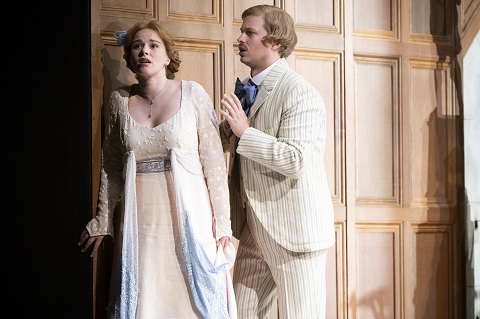 Mélisande (Christina Gansch) and Pelléas (John Chest). Photo Credit: Richard Hubert Smith.
Mélisande (Christina Gansch) and Pelléas (John Chest). Photo Credit: Richard Hubert Smith.
We do that to children too, especially those of us who claim to be shocked by the very suggestion. Germaine Greer has fallen off the rails spectacularly in recent years, but her insight that we are all paedophiles still holds; indeed it holds more strongly than ever, if less so for those of us unburdened by ‘family’. And so, when Yniold - yes, I too had been mumbling that I should have preferred to hear a treble - is unmasked as a woman all along, with locks aspiring to those of Mélisande, we are obliged to ask ourselves questions. The violence we see, feel aestheticised and sublimated all around us suddenly becomes, as the interval comes, something we can no longer ignore. Those blows that never quite led anywhere come to seem something more than ‘boring’.
By the same token, however, should they perhaps not have become something a little sooner? When does representing boredom become merely boring? I am not sure that Herheim, usually a master at treading of multiple lines, does not trip, even fall, in this case. An object lesson in that respect was Christiane Pohle’s revelatory post-Beckett staging for the Bavarian State Opera. Meaninglessness was the thing there, not ennui as such; the production was all the better for it. I cannot help but wonder whether the negative reaction it received was laced with misogyny - and/or perhaps a journalistic lack of understanding of ‘modern’ theatre. It was, at any rate, difficult not to ask such a question in a work that focuses on abusive behaviour and yet here, at least, attempts to avoid addressing that behaviour.
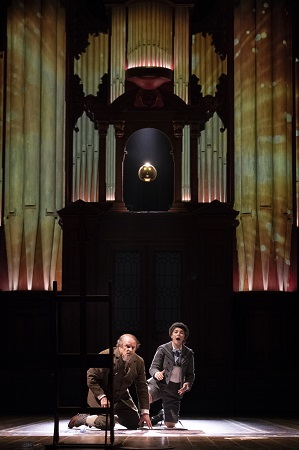 Golaud (Christopher Purves) and Yniold (Chloé Briot). Photo Credit: Richard Hubert Smith.
Golaud (Christopher Purves) and Yniold (Chloé Briot). Photo Credit: Richard Hubert Smith.
Later on, when it becomes more explicit, when we see that Pelléas and Mélisande literally stage their own death - is it actually a real death at all, or just an act - everything falls into place. Mélisande has already - in fact she did so straight away - ease(le)d out Geneviève. The family, closing ranks, would clearly avenge itself, so perhaps playing at Tristan and Isolde is all that it is left. It has not been an easy road; nor, surely, should it have been. However, just a little relief from the claustrophobia might actually render it more powerful. As things stand, there remains more than a little suspicion that earlier tedium is a handy, even suggestive excuse, yet perhaps nevertheless an excuse in part. Bloodied clowns certainly make their point; this sick Liebestod from the Theatre of the Absurd has still not left my imagination. Yniold, now herself, visits the Organ Room as a guest, an opera-goer. It makes the point, yes, but might it not be better left unmade?
Tradition is, after all, sometimes necessary, or at least helpful - as the Roman Catholic Church would rightly tell us. It often provides an important counterweight to literalism, to fundamentalism. Collective wisdom enables development; each one of us need not re-invent the wheel. (Aesthetes breathe a collective sigh of relief.) As Pierre Boulez pointed out in challenging - though not, as some have claimed, denying - tradition, ‘a strong personality will inevitably transform it [tradition].’ That still leaves the problem, of course, of what to do about personalities that are not ‘strong’ or do not wish to be. ‘Ne me touchez-pas! Ne me-touchez-pas!’ Is the conclusion here bleak or weak? Is it too easy to say that it is what we want it to be? Doubtless. Is it what we will make of it? By definition it more or less has to be, but is that simply to evade the question? And is that wrong? Debussy, after all, is the unsurpassed master of musical ambiguity.
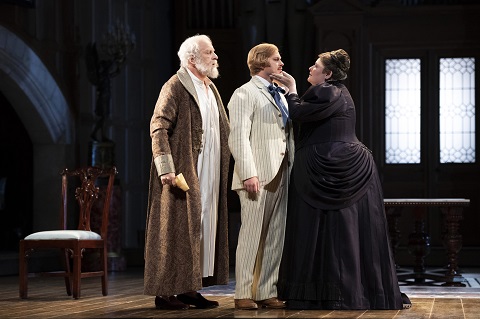 Arkel (Brindley Sherratt), Pelléas (John Chest) and Geneviève (Karen Cargill). Photo Credit: Richard Hubert Smith.
Arkel (Brindley Sherratt), Pelléas (John Chest) and Geneviève (Karen Cargill). Photo Credit: Richard Hubert Smith.
Tradition, or at least learning, would certainly have benefited the conducting, at best featureless, at worst frankly jejune, we heard from Ticciati. Debussy’s genius shone through, although more the debt to Wagner than what distinguished him from the old Klingsor. That, however, was surely the doing of the London Philharmonic, drawing when it could on its vast reserves of operatic and symphonic experience. Alas, such uninspired musical direction - bleeding titbits of Wagner for people who do not like Wagner - did not help the singers either. Christopher Purves was presented as an older Golaud and sang as such: nothing wrong with it. His anger was wonderfully sublimated until it was not. It would have gained greater musical context, though, as would the rest of the cast’s, had there been - well, greater musico-dramatic context. Christiana Gansch and John Chest likewise offered good vocal performances as the doomed lovers, but something seemed to be missing. (Should something be missing? Perhaps. Again, however, it is a fine line.) Richard Wiegold was an undoubted hero of the evening, singing from a box whilst an indisposed Brindley Sherratt acted out the role of Arkel below. Karen Cargill offered rich-toned benevolence - I think - as Geneviève; as so often in this role, one wished there were more to hear. There was much to admire from Chloé Briot, Michael Mofidian, and Michael Wallace, although it was difficult not to think that all concerned would have benefited from greater certainty and clarity elsewhere.
Was it worth it, then, to have annoyed the right people, bluff English purveyors of ‘common sense’? Of course. They will not like Pelléas anyway; if they think they do, it is because they have not remotely understood it and think of it as vaguely ‘beautiful’. Is it enough to have annoyed them? Of course not. Does this represent Herheim’s best work? No. Does the production stand in need of revision? Very much so. Does it also need a conductor with a little more idea what might be going on and what might be at stake? Still more so. And yet, I have been thinking about it ever since, and show no sign of stopping. In the meantime, hasten to see Barrie Kosky’s Berlin production and, should it ever be revived, Pohle’s Munich staging . There are always, as we æsthetes/æstheticists will tell you, great recordings too. Desormière or Karajan? Boulez or Abbado? Why choose? With Boulez, you can even see Peter Stein before he lost it. ‘What,’ you might ask, ‘is “it”,’? Such is surely part of what Herheim’s production is about - perhaps, peut-être, still more so than he intended.
Mark Berry
Claude Debussy: Pelléas et Mélisande
Golaud: Christopher Purves; Mélisande: Christiana Gansch; Geneviève: Karen
Cargill; Arkel: Brindley Sherratt/Richard Wiegold; Pelléas: John Chest;
Yniold: Chloé Briot; Doctor: Michael Mofidian; Shepherd: Michael Wallace.
Director: Stefan Herheim; Designs: Philipp Fürhofer; Lighting: Stefan
Herheim, Tony Simpson; Dramaturgy: Alexander Meier-Dörzenbach. Glyndebourne
Chorus (chorus master: Nicholas Jenkins)/London Philharmonic
Orchestra/Robin Ticciati (conductor).
Glyndebourne Opera House, Sussex, 30 June 2018
image=http://www.operatoday.com/Pelleas%20Act%201.jpg image_description=Pelléas et Mélisande, Glyndebourne Festival Opera product=yes product_title=Pelléas et Mélisande, Glyndebourne Festival Opera product_by=A review by Mark Berry product_id= Above: Pelléas et MélisandePhoto credit: Richard Hubert Smith
July 1, 2018
Mozart: Don Giovanni, Royal Opera House
Holten’s Don Giovanni is entirely about making the most of Es Devlin’s sets - and he does so even before the Overture, as lugubrious as any I’ve heard, has even ended. Devlin’s sets are undeniably imposing - a vast colonnaded front, with balconies and endless doors, balustrades and hallways linked by stairways that disappear into infinity. At times I had difficulty deciding whether I was looking in on a Romanesque temple or the set of Hush… Hush Sweet Charlotte and the Hollis Mansion in its antebellum, southern Louisiana horror. But just as Altman’s 1964 film had been a study in psychological breakdown, of seeing ghosts at the top of staircases, Holten extends his cinematic journey into his Don Giovanni still further by drawing us into Hitchcock’s 1945 study into psychoanalysis and surrealism, Spellbound, with his own Dali-inspired Don Giovanni aria ‘Fin ch’han dal vino’ with the Don as the centre of the eye amid a converging point of infinite distances.
If Holten’s production shares one thing with Bieito’s it is that both are somewhat voyeuristic in their views of the opera, very much comfortable with the objectification of sexuality. From the outset, Luke Halls’s video design (this is very much a production for the digital age) gives us a running count of the Don’s sexual conquests - and there are so many of them, they cover not only every inch of the outside of the walls, but the inside too… from the sides of staircases, the steps themselves, furniture, even objects on tables. Echoing Escher’s stairs, the geometric set reflects a sense of perspective and depth to this endless pornography. This graffiti leaves an almost permanent stain throughout the entire opera, a reminder that Don Giovanni’s existential sexuality is based entirely on deceit and immorality embedded as it is deep within his psyche. It’s no coincidence that his principle lovers are also damaged goods - the cluster of ink blots on their dresses, Rorschach-like, but also reminders of sex itself. When the litany of names are erased it’s to soak the walls in crimson blood, or drench them in the bleakness of Don Giovanni’s mental psychosis.
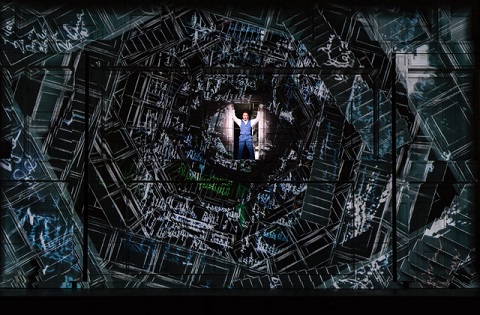 Photo credit: Bill Cooper.
Photo credit: Bill Cooper.
Musically, this Don Giovanni is a bit of a mess. Textually, it is neither the complete Vienna nor the Prague edition, nor the usual mixture of both - and many will find excising ‘ Questo è il fin di chi fa mal’ from the end troubling, though I think it better meets Holten’s objectives for this production to exclude it. Holten’s Don is so psychologically flawed, so concerned with projecting his pain onto others and using his sexual narcissism to seduce almost everyone he encounters into complicity, that his descent into madness at the end seems a more fitting conclusion. Holten’s Don is morally corrupt, but as Kierkegaard also suggests desire is “victorious, triumphant, irresistible and demonic”. The comparison with Faust is completely unambiguous and, rather as the French novelist Jean Genet was fond of suggesting when describing his own views on sex, this is a Don who is in it for the chase alone.
The casting of Covent Garden’s revival is fairly strong, and, frankly, it needs to be to fight against Marc Minkowski’s interminable and heavy-handed approach he takes with much of the score; I thought Act I was never going to end. This approach to the music doesn’t sit comfortably with the dramatic visual changes that Luke Halls’s video design and Bruno Poet’s lighting is presenting on stage - often what the eye is seeing isn’t corresponding very closely to what the ears are hearing. Minkowski didn’t always generate much enthusiasm from the orchestra either, so it was perhaps all the more surprising that the singing itself was often of a very high standard indeed.
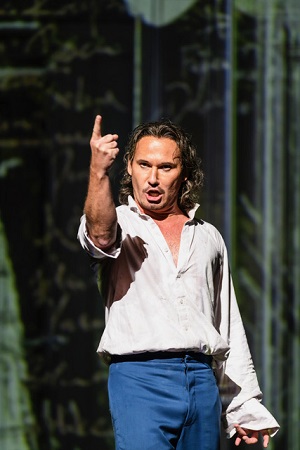 Mariusz Kwiecień as Don Giovanni. Photo credit: Bill Cooper.
Mariusz Kwiecień as Don Giovanni. Photo credit: Bill Cooper.
The Polish baritone Mariusz Kwiecień is the kind of Don Giovanni that seems ideally suited to Kasper Holten’s production. In many ways, I found his assumption of the part quite disturbing - he’s dynamically sexual, a prowler, but the trajectory towards his mania is like watching a breakdown happening in slow motion so deeply does he explore the depths of the character’s underlying psychology. The voice is superb as well, a dark, true baritone - like Eberhard Waechter’s - able to explore the demonic and seductive sides of the Don’s personality. He was nowhere better than in his final confrontation with the Commendatore, imperious of tone, the technique immaculate, with just enough spine-chilling darkness to the voice. Perhaps he was fortunate that his Leporello was Ildebrando D’Arcangelo. Kwiecień and D’Arcangelo often subverted the master/servant equation, so much so that Joseph Losey’s The Servant seemed like a model for their unbalanced relationship, even with its latent hints of an uneasy masculine derived sexuality. Although he sometimes looked as if he had fallen out of a Chicago Sleep Easy, D’Arcangelo moved with breath-taking ease between being a figure capable of easy-going humour one moment, and disturbing violence the next. More so than in many productions, Holten views his Leporello as a tragic shadow of Don Giovanni himself - even the similarities in the voices that both these singers share suggested a much closer alignment to their fates than normal.
Rachel Willis-Sørensen, as Donna Anna, never sounds vocally stretched (as can sometimes happen with this role) and is as lyrical as she luminous. Hrachuhi Bassenz, as Donna Elvira, is done with considerable intensity at times, almost as if she is on the edge of hysteria. As with many of Holten’s characterisations in this production, there is a sense that his women, especially, are being driven into a kind OCD pattern of sexual behaviour - coming back for more of the same, even though it is pushing them into damaging psychological breakdowns. Both Donna Anna and Donna Elvira are more complex women than we usually see in this opera, even if what we see is quite disturbing.
As for the rest of the cast, Willard W. White, as the Commendatore, perhaps lacks the depth of tone he once had to command the stage but was compelling, especially in his showdown with Kwiecień - even if he looked as if he had risen from George A. Romero’s Dawn of the Dead, taking to stalking Don Giovanni around the corridors like a zombie. Pavol Breslik was a beautifully lyrical Don Ottavio, and convincingly handsome, Chen Reiss a somewhat matronly Zerlina, and Anatoli Sivko a sonorous, if ultimately unsympathetic Masetto.
Holten’s Don Giovanni probes deep, and Es Devlin’s sets, dizzying though they are - quite literally - are visually spectacular. The entire opera is a tour de force for its lighting engineers and someone working on a laptop, but the length of time we are asked to engage in looking at the staging borders on the cinematographic rather than operatic. Likewise, the demands that Holten places on his audience and the questions he asks squarely place Mozart the composer second. On opening night, the cast sang well despite the conductor, not because of him - in other circumstances this production might well be not so fortunate.
Further performances 3rd July until 17th July 2018.
Marc Bridle
Mariusz Kwiecień - Don Giovanni, Ildebrando D’Arcangelo - Leporello, Rachel Willis-Sørensen - Donna Anna, Pavol Breslik - Don Ottavio, Hrachuhi Bassenz - Donna Elvira, Chen Reiss - Zerlina, Anatoli Sivko - Masetto, Willard W. White - Commendatore; Kasper Holten - Director, Amy Lane - Revival Director, Marc Minkowski - Conductor, Es Devlin - Set Director, Luke Halls - Video Design, Bruno Poet - Lighting Design, Orchestra of Royal Opera House.
Royal Opera House, Covent Garden, London; Friday 29th June 2018.
Image=http://www.operatoday.com/Don%20Giovanni%20production%20image%20Cooper%20%281%29.jpeg image_description=Don Giovanni, ROH, Covent Garden product=yes product_title=Don Giovanni, ROH, Covent Garden product_by=A review by Marc Bridle product_id= Above: Don Giovanni, at The Royal Opera HousePhoto credit: Bill Cooper
Superb Schoenberg Gurrelieder - Salonen, Philharmonia, London
After their first Gurrelieder with him in March 2009, I was at an airport where many of the players were talking excitedly about Gurrelieder and the way Salonen worked with them. Musicians can be blasé (at least on the surface), but these players were genuinely enthusiastic. And they didn't know that I was listening in !
The deep surging undercurrents in the Prelude, lit by bright sparkling figures, seemed almost to vibrate. Well-defined the strings, harps and horns introduced the dream-like mood, textures gradually build up in sweeping arcs, string lines swelling and heaving. Perhaps Schoenberg had in mind Tristan und Isolde, or Siegfried's journey down the Rhine. Either way, vast cosmic forces are being invoked. Or can we hear echoes of Verklärte Nacht writ infinitely larger ? Schoenberg then introduces the mortals, King Waldemar (Robert Dean Smiith) and Tove (Camilla Tilling). The parts are tricky to cast, since Schoenberg, in his youth, pits the singers against huge orchestral forces. Yet voice along doesn't create a part. Simon O'Neill, for example, doesn't have a pretty voice but more than compensates with artistry and insight. Waldemar was anti-hero enough that he dares curse God : a Flying Dutchman of sorts. Dean Smith didn't quite have the heft or gift for characterisation, so this Waldemar came across in milder form, though the music around him roared with passion. Tilling created a refined Tove, her lines soaring gracefully, serving the part well. Few Tove's are truly "wunderliche" but Tilling is attractive, as gentle as a dove. Tove is silenced, but the Wood Dove takes her place.
The Wood Dove, a much stronger personage than Tove, is an Erda figure, who sees all, and the mood is almost incantation. . Michelle DeYoung was ideal, her rich timbre enhanced by sombre dignity. The recurring line "Weit flog ich....." rose forcefully from the surging undercurrents, bringing out the rhythmic flow. Every good performances helps us think more about the music. This time I was pondering how the Wood Dove's music might resemble Sprechstimme. A pity that the "Herrgott ! Herrgott!" part didn't have quite the impact in the Royal Festival Hall as it could have. The front of that stage sucks voices into the void even if you've got a voice-friendly seat. On the BBC Radio 3 broadcast, Dean Smith's can be heard with better balance. In the orchestra, however, the "Herrgott!" chords were magnificent, executed so they seemed to have a metallic quality, like hammerblows striking stone.
A haunted, baleful introduction to the final part, when the orchestra seemed to explode with the horror of the apocalyptic vision being described. Trombones wailed, percussion rumbled, strings evoking a sense of wind and wildness. Waldemar and his doomed knights are riding theough the sky. Another excellent cameo with David Soar's Peasant. The firmness in Soar's timbre suggested that even a doughty peasant can be so shaken that he must bolt his door and pray. The Philharmonia Voices were augmented by the male voices of the Royal Academy of Music, the Royal College of Music, the Guildhall School of Music and Drama and the Trinity Laban Conservatoire of Music and Dance.In the relatively small space of the Royal Festival Hall, the impact could have been overwhelming, but under the direction of Aidan Oliver, what came over was clarity, not sheer volume. Good articulation, the "Holla!"'s wild, the sudden descent into near silence chilling. Yet again, the orchestra set the scene. The strings surged, then opened out to strangely disturbing calm, the woodwinds adding quirky menace. Despite the turbulence around him, Waldemar is alone.
Thus the spooky interlude before Klaus-Narr sings, cloaking the part with surreal horror. Wolfgang Ablinger Sperrhacke is one of the finest "Character" singers in the business, so this cameo, like Michelle DeYoung's Wood Dove, was a major highlight. Ablinger-Sperrhacke captured the strange, disjointed rhythms in the part extremely well, the "fool" easily the match of the orchestra. Perhps Waldemar is the fool, still obsessed by ."Ich und Tove, wir sind eins", oblivious to his predicament. Thus the brooding in the orchestra before the male choirs returned, textures subdued yet uncowed. "Ins Grab! Ins Grab!" A particularly good Wild Hunt of the Summer Wind, tubas booming, let by high winds, with chamber-like delicacy in the playing. The role of the Speaker is usually cast with a singer whose voice is past its bloom, but whose musical instincts are still strong enough to declaim with Sprechstimme intonation. Some of the great singers of the past have done the Speaker so he/she feels like a ghost from the past, revived, like Waldemar and his Knights, a thoughtful insight. Barbara Sukova is an actress with musical nous, whose voice is still fairly youthful, so her Speaker was different, closer perhaps to Klaus-Narr commenting on the spectres, as opposed to being one of them, which is perfectly valid. A blazing "Seht die Sonne!"! and the audience in the Royal Festival Hall went wild. In orchestral terms, this was an outstanding Gurrelieder, Salonen and the Philhrmonia delivering with insight and understanding.
Anne Ozorio
Image=http://www.operatoday.com/e-p_image_credit_Katja_T%C3%A4hj%C3%A4.jpg
image_description=Arnold Schoenberg, Gurrelieder: Esa-Pekka Salonen, Philharmonia Orchestra, Robert Dean Smith, Camilla Tilling, Michelle deYoung, David Soar, Wolfgang Ablinger-Sperrhacke, Barbara Sukova, Philharmonia Voices, Choirs of the he Royal Academy of Music, the Royal College of Music, the Guildhall School of Music and Drama and the Trinity Laban Conservatoire of Music and Dance, Royal Festival Hall, London. 28th June 2018.
product=yes
product_title=Arnold Schoenberg, Gurrelieder: Esa-Pekka Salonen, Philharmonia Orchestra, Robert Dean Smith, Camilla Tilling, Michelle deYoung, David Soar, Wolfgang Ablinger-Sperrhacke, Barbara Sukova, Philharmonia Voices, Choirs of the he Royal Academy of Music, the Royal College of Music, the Guildhall School of Music and Drama and the Trinity Laban Conservatoire of Music and Dance, Royal Festival Hall, London. 28th June 2018.
product_by=A review by Anne Ozorio
product_id= Above: Esa-Pekka Salonen
Photo credit: Katja Tähjä